Mix Masters
Concrete creativity p28
Elevated Awareness
Lessons from on high p32
Civic Civility
Talk among yourselves p36

Artistic Encounters
The oddly compelling creations of Anida Yoeu Ali

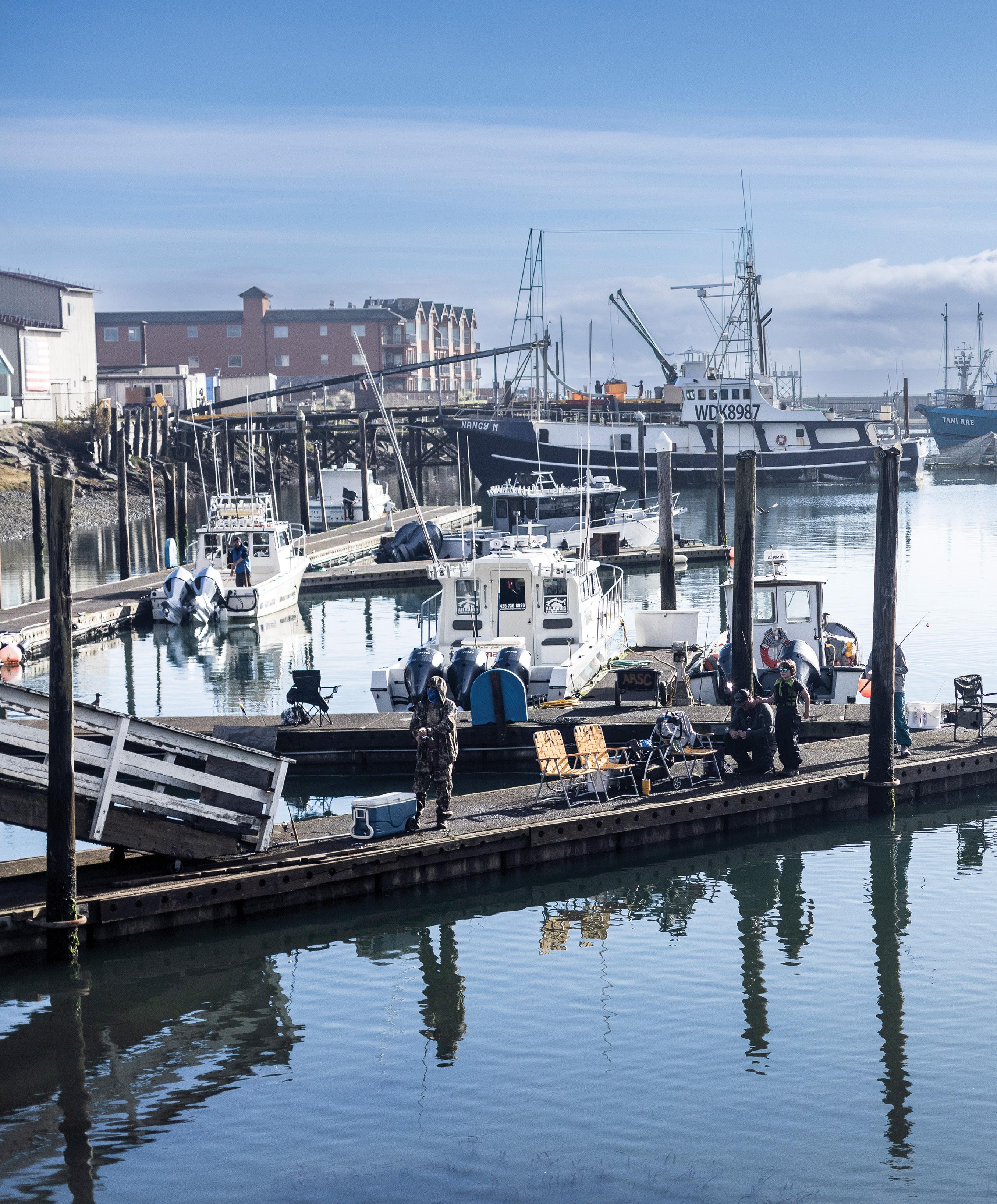

Hope Against Peril
The small town of Westport in Grays Harbor County is known for its sandy beaches, sprawling marina and century-old fishing industry. But its proximity to the Pacific Ocean and shifting tectonic plates along the coastline bring the risk of a tsunami. A team of University of Washington researchers and scientists in mathematics, the Washington Sea Grant and the College of Built Environments are helping the town and other coastal communities prepare for a tsunami and other associated risks, including sea-level rise. Photo by Mark Stone
OF WASHINGTON WESTPORT

AT&T is Washington’s largest network *Coverage not avail. everywhere. Based on 3rd party data. * ©2022 AT&T Intellectual Property. AT&T and the Globe logo are registered trademarks and service marks of AT&T Intellectual Property. All other marks are the property of their respective owners.
At the University of Washington, our students and our community have a rich legacy of striving toward a common goal, and we don’t stop at the finish line. When we all combine our individual passions with a shared purpose, we go further, faster — together.
uw.edu/boundless

For pushing yourself. For pulling together. BE BOUNDLESS.

22 Artist, Agitator, Bug
Anida Yoeu Ali, UW Bothell’s senior artist-in-residence, launches a solo exhibition at the Seattle Asian Art Museum.
By Shin Yu Pai
26 Mix Masters
At the UW Concrete Materials Lab, the outlook for the future of one of the world’s oldest building materials is anything but gray.
By Stacy Kendall
30 Elevated Awareness
Alpinist and filmmaker Graham Zimmerman reflects on lessons learned climbing the world’s highest peaks.
By Rachel Gallaher
34 Civic Life
Husky Civic Saturdays will bring people together to explore moral questions that matter to us.
By Caitlin Klask
Calling Graham Zimmerman a globetrotter is spot on. Born in New Zealand but raised in the Pacific Northwest, the alpinist who earned a certificate in storytelling from the UW has become one of the world’s preeminent mountain climbers.

SUGAR RUSH
What started as an Instagram account in 2020 became a perpetually sold-out bakery for Lauren Tran, ’11, co-owner of Bánh by Lauren. uwmag.online/tran

TOP DAWG
Relive the Huskies’ latest season with former linebacker Bruce Harrell, ’81, ’84, in a Q&A about football, family and Seattle. uwmag.online/harrell
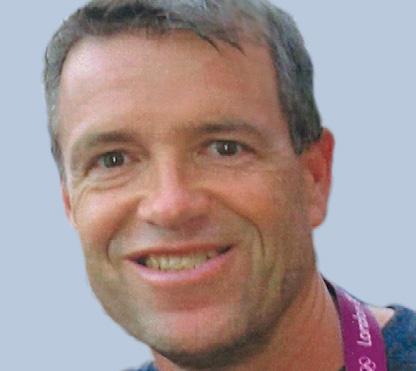
CAPLE'S COMMUNITY
Sports writer Jim Caple, ’97, who died late last year, wrote some of UW Magazine’s most memorable stories. Find them at uwmag.online/caple.
ON THE COVER
Anida Yoeu Ali, a UW Bothell senior artist-in-residence, performs in “Campus Dining, The Buddhist Bug Series.” The Bug is an ongoing series of performances that explore issues of displacement and belonging.
courtesy Anida Yoeu Ali.
ONLINE
uwmag.online 4 UW MAGAZINE VOLUME 35 NUMBER 1 SPRING 2024
Photo
COMMUNICATIONS
VICKI
CAPLE ATHLETICS
COUTO
COURTESY GRAHAM ZIMMERMAN
CAEAN
FORWARD 6 The Hollow Horse 8 The Nature of Nature 10 Roar from the Crowd THE HUB 12 The Boldt Decision 13 State of the Art 14 Brad McDavid’s Swan Song 18 Research Briefs 20 Athletics COLUMNS 36 SIFF leader Tom Mara 37 Sketches 41 Media 52 Tribute 54 In Memory IMPACT 44 Clean Energy 48 The UW Farm UDUB 56 Equestrian Team


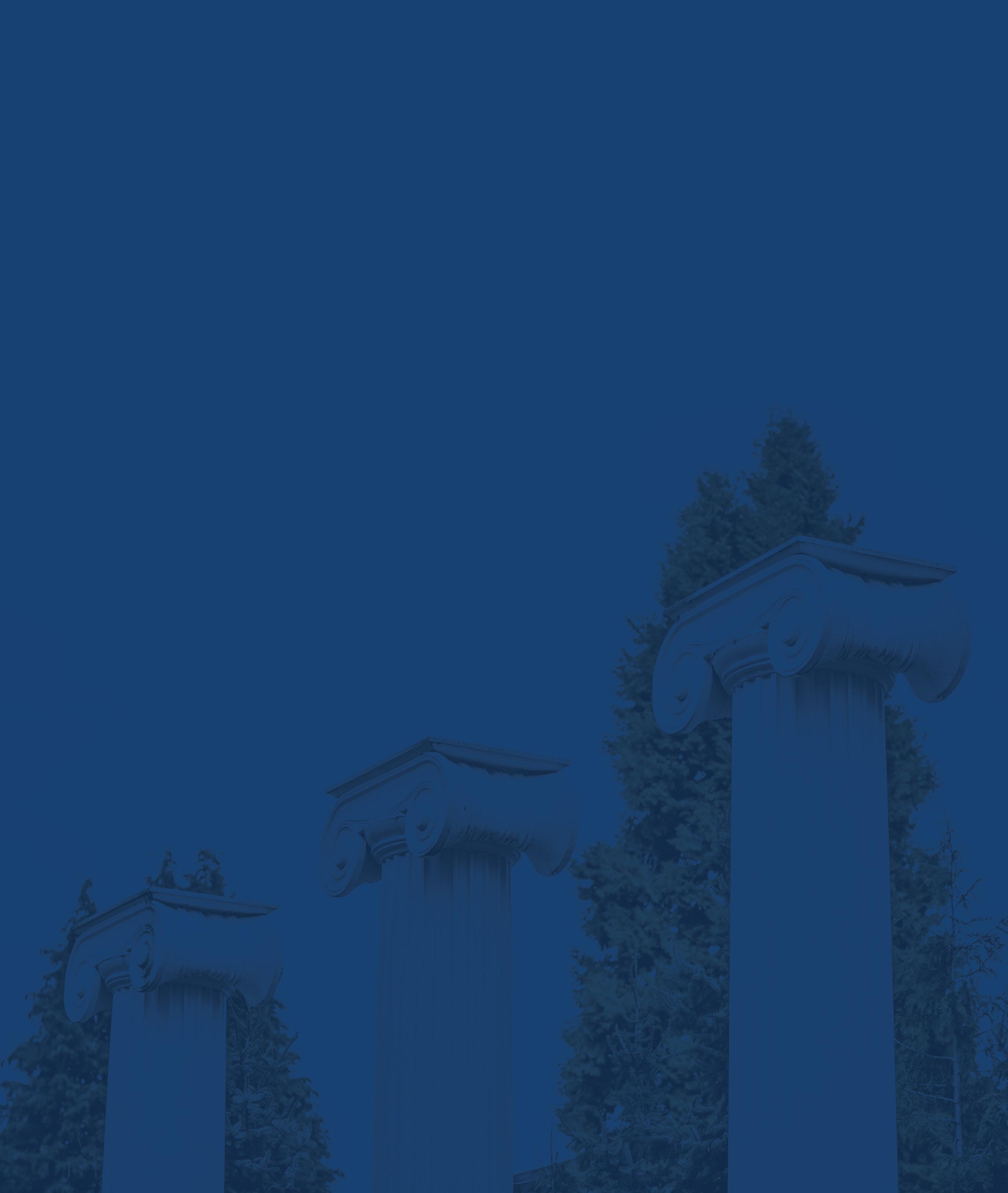
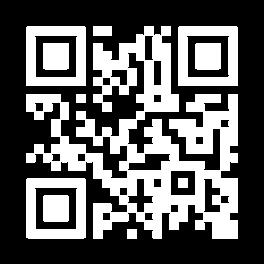
For PhDs in life well lived. AEGIS LAURELHURST, OPENING MAY 2024 Welcome to our newest community, a redbrick beauty standing tall in the shadow of UW. Steps away from the Burke-Gilman Trail, U-Village, and Lake Washington, Aegis Laurelhurst offers premier assisted living and memory care with a focus on well-being and longevity. A fitting tribute to experts in the good life. LAURELHURST (206) 785-3285 / aegislaurelhurst.com
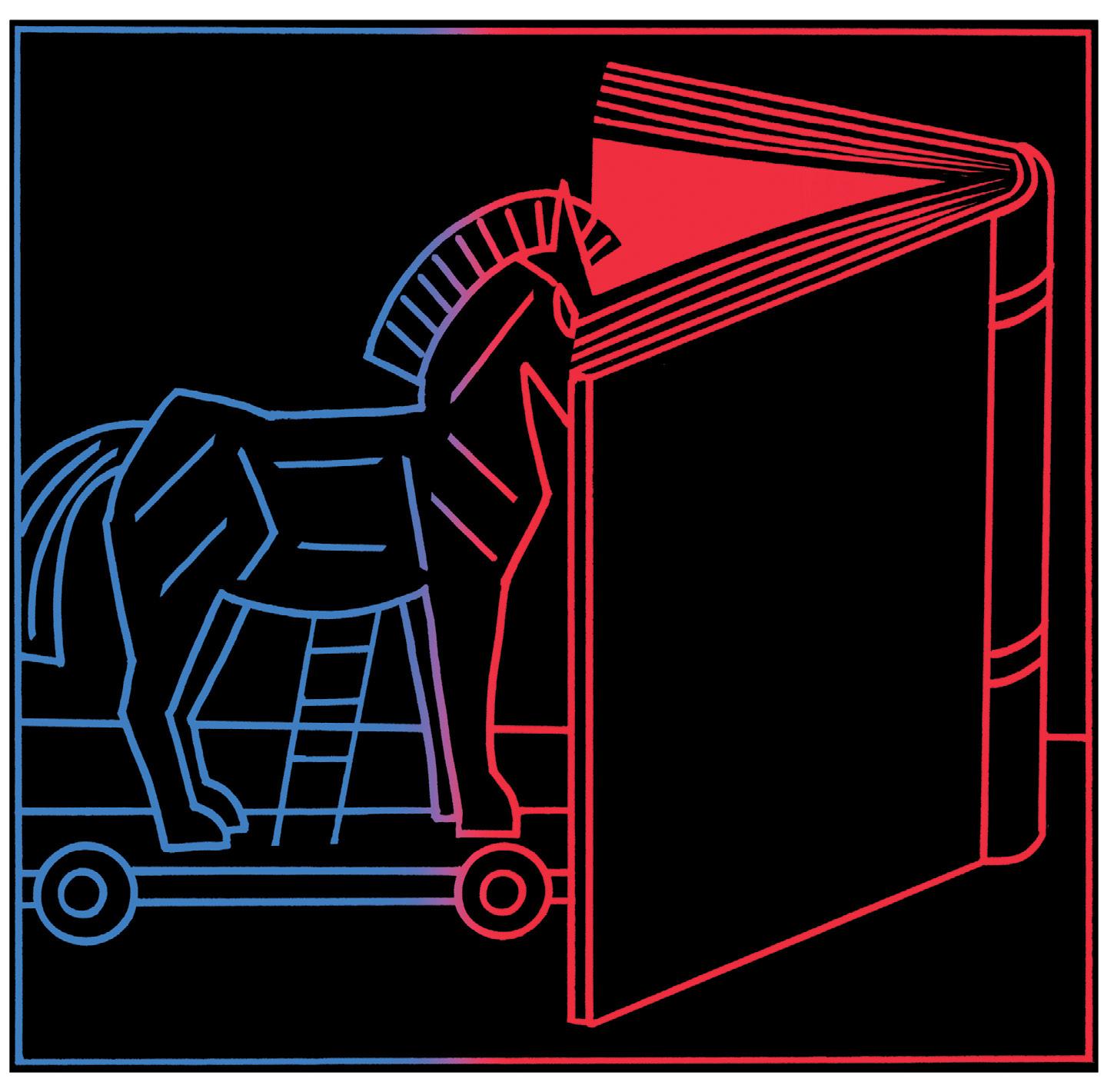 BY TRACIE D. HALL
BY TRACIE D. HALL
Beware the Hollow Horse
Why the current wave of censorship reveals the cracks in our democracy
“Equo ne credite (Don’t trust the horse),” Virgil warned over 2,000 years ago. He was talking about the gift of a hollow wooden horse that would lead to the toppling of Troy. We must also keep those words of caution in mind as our own country experiences an alarming escalation in efforts to censor books.
These efforts, which have increased steadily since 2017, and prodigiously since 2020, are disguised as moral imperatives such as protecting our children. There are no signs of the efforts slowing despite the fact that most Americans, regardless of political affiliation, believe that book banning is a violation of the right to speak
and freedom of the press as protected by the First Amendment.
In the notorious McCarthy era (19501954), Sen. Joseph McCarthy amassed the power to ban (and even burn) upward of 30,000 books. The authors were placed on trial and the libraries that housed the works attacked. Now, as then, the censorship crusade is far from a popular movement. Last year, an investigative study by The Washington Post found that the same 11 people were responsible for 60% of the book challenges leveled at schools.
The McCarthy era had a singular antihero and never produced a bill. The latest efforts are orchestrated by extremist groups
and have become such a potent leveraging tool for politicians that censorship legislation has been introduced in nearly every state. Some of these laws not only criminalize the act of reading, but also recommend jail time and fines for those who make banned or restricted materials available. A new law in Oklahoma, for example, decrees that school and library staff could be fined up to $20,000 or serve up to 10 years in prison for facilitating access to restricted content. A Tennessee law passed in 2023 subjects book publishers, distributors and sellers to the possibility of up to six years in prison and over $100,000 in fines for exposing children to matter deemed “obscene.” But notions of obscenity, age appropriateness or historically or socially reparative works are largely subjective. Over the last two years, I have attended or audited censorship hearings in which the very individuals calling for book bans have openly admitted to not having read the books themselves.
The rise and spread of state-sanctioned censorship legislation is evidence of the contemporary frailty of our democracy and makes this assault on intellectual freedom (and diversity, as books by LGBTQIA and BIPOC authors and about lived experiences are the predominant targets) all the more alarming. Now politicians in other democracies including Australia, Brazil, Canada and the United Kingdom, are replicating U.S.-style censorship tactics. Like their American counterparts, they may see the banning of books as a jumping-off point for restricting other personal liberties.
The distrust of science and data, disinvestment from fact-based journalism and derision of the right to read have formed a powerful and mutually reinforcing trifecta over the past few years. Yet it is the latter, in the form of book banning, that seems to presage a new dark age.
There was a time when the ability to write and read freely was the proof-point of any democracy. Today that right has been obfuscated by some who would have us conflate liberty with control.
The large wooden horse of censorship has cast its shadow over our nation once again. Isn’t it high time that we ask who sent it, what’s inside and why now?
�racie D. Hall, ’00, is the former executive director of the American Library Association, the first African American woman to serve in that role. She joins the UW this spring as a distinguished professor of practice for the Information School.
6 UW MAGAZINE OPINION AND THOUGHT FROM THE UW FAMILY ILLUSTRATION BY ANTHONY RUSSO

Orthopedic Surgery
Sometimes your body just won’t do what you want it to do. Whether that’s because of an injury or a chronic condition, our orthopedic surgery team can help. From joint replacement to non-surgical options, we’re here to help you get moving again. uwmedicine.org/ortho
HERE FOR WHATEVER HURTS
CARPAL TUNNEL FRACTURES
WE’RE
JOINT PAIN
SPORTS INJURIES TENNIS ELBOW ROTATOR CUFF TEARS

The Nature of Nature
By Jon Marmor
Washington state has always been recognized as one of the most gorgeous parts of the country, and for its residents’ deep appreciation of the natural world. Thus, it made perfect sense for a University of Washington professor to be named the director for the first-ever United States National Nature Assessment.
Phillip Levin, a UW professor of practice in the College of the Environment’s School of Environmental and Forest Sciences and lead scientist at The Nature Conservancy in Washington state, has been appointed director of this White House initiative. This project will employ an interdisciplinary approach to better understand the role of nature in the lives of U.S. residents.
This assessment will take stock of lands, waters and wildlife and how they contribute to our economy, health, national security, environmental justice and climate—and how nature might be affected by climate change. The findings are expected to be released in 2026.
Levin, who heads the Interdisciplinary Conservation Science Lab at the UW, explains: “Successful conservation, especially in the face of an uncertain climate, is built
STAFF
A publication of the UW Alumni Association and the University of Washington since 1908
PUBLISHER
Paul Rucker, ’95, ’02
ASST. VICE PRESIDENT, UWAA MARKETING & COMMUNICATIONS Terri Hiroshima
EDITOR Jon Marmor, ’94
MANAGING EDITOR Hannelore Sudermann, ’96
ART DIRECTOR Ken Shafer
DIGITAL EDITOR Caitlin Klask
STAFF WRITER Shin Yu Pai, ’09
CONTRIBUTING STAFF Karen Rippel Chilcote, Kerry MacDonald, ’04
UWAA BOARD OF TRUSTEES PUBLICATIONS
COMMITTEE CO-CHAIRS
Chair, Mark Ostersmith, ’90 Vice Chair, Roman Trujillo, ’95
CONTRIBUTING WRITERS
Eric Butterman, Rachel Gallaher, Stacy Kendall
CONTRIBUTING PHOTOGRAPHERS
Matt Hagen, Mark Stone, Jonathan Vanderweit, Dennis Wise, Ron Wurzer
CONTRIBUTING ILLUSTRATORS
Olivier Kugler, David Plunkert, Anthony Russo
EDITORIAL OFFICES
Phone 206-543-0540
Email magazine@uw.edu
Fax 206-685-0611
4333 Brooklyn Ave. N.E.
on the knowledge and collaboration of Tribes, stakeholders, scientists, natural-resource managers and local leaders. We all have a stake in—and contribute to—a sustainable future. This collaboration will be key to the success of the National Nature Assessment, enabling us to develop a holistic understanding of nature in the U.S.”
In this new role with the White House Office of Science and Technology Policy and the U.S. Office of Global Change Research, Levin’s role is to create a holistic view of America’s ecosystems, waters and wildlife, and define the benefits they provide. No one is better suited for this undertaking; Levin is a conservation scientist who is interested in bridging the gaps between theory and practice, and between social and natural sciences. The primary focus of his work is developing interdisciplinary tools to inform conservation of marine and terrestrial ecosystems and the communities that depend on them.
It’s no surprise that the federal government turned to the University to head up this project. It’s just another example of the positive impact the University has on our way of life.
UW Tower 01, Box 359559 Seattle, WA 98195-9559
ADVERTISING
SagaCity Media, Inc.
1416 NW 46th Street, Suite 105, PMB 136, Seattle, WA 98107
Megan Holcombe
mholcombe@sagacitymedia.com, 703-638-9704
Carol Cummins
ccummins@sagacitymedia.com, 206-454-3058
Robert Page rpage@sagacitymedia.com, 206-979-5821
University of Washington Magazine is published quarterly by the UW Alumni Association and UW for graduates and friends of the UW (ISSN 1047-8604; Canadian Publication Agreement #40845662). Opinions expressed are those of the signed contributors or the editors and do not necessarily represent the UW’s official position. �his magazine does not endorse, directly or by implication, any products or services advertised except those sponsored directly by the UWAA. Return undeliverable Canadian addresses to: Station A, PO Box 54, Windsor, ON N9A 6J5 CANADA.
8 UW MAGAZINE
ILLUSTRATION BY DAVID PLUNKERT
MESSAGE FROM THE EDITOR
It was buddies at first book club.

Mirabella senior living. Sometimes scholarly. Sometimes playful. Oftentimes, just plain fun. Professor? Bookworm? Fun lover? You’ve found your place. Call today to schedule a tour.
116 Fairview Ave N • Seattle • 206.337.0443 www.mirabellaseattle.com


Retirement Services
Mirabella Seattle is a resident-centered, not-for-profit Pacific
community and an equal housing opportunity.
Find Your People in South Lake Union
A Great Response
As a UW graduate and a lifelong boat owner, I’ve had an avid interest in crew during my college years and beyond (“Strokes of Genius,” Winter 2023). Al Ulbrickson’s influence extended beyond being a great rowing coach. He was a Phi Beta Kappa in the UW College of Business. Later, it was through his business-school associations, he asked our crew turnouts if they would be interested in a few parttime positions at the 1962 Seattle World’s Fair. The jobs were driving carts, taking tickets and giving directions. You can imagine what the response was!
Nick Dobos,
’66, ’71, Sun Lakes, Arizona
Clipper Course
I thoroughly enjoyed the article about the “Boys on the Big Screen.” However, the Husky Clipper was given away by the UW in 1959, not 1963 as described in the article. The Husky Clipper was presented by coach Fil Leanderson to the Green Lake Crew in early 1959 for use by the then decade-old junior rowing program. Green Lake then passed it on to PLU in 1963.
Jill MacCorkle, ’90, Seattle
Revisiting Vietnam
The article “Wounds to Land, Mind, Body” (Winter 2023) brought me back to 22 years of age (I am now 71). It started in 1965 when upon graduating with a history degree, I received recognition from a higher institution (USA) in the form of a draft notice! After basic training and transportation training, I drove five-ton oil tankers throughout the greater area surrounding Saigon (now Ho Chi Minh City). I was on my own on back roads and to and from our base. That led to continual tenseness to possible enemy locations. Like Dr. Fey, I felt that if I would be able to return home, I would make good use of the time given. And so far, I feel I have accomplished that goal. I was one of the many who vowed never to return to ’Nam, but I returned in 2014 with my wife, Gael. Dale L. Schultz, ’65, Seattle
CORRECTION
The story “With Wit and Whiteout” (Winter 2023) accidentally placed Franklin & Marshall College in New Hampshire. Its home is in Lancaster, Pennsylvania.

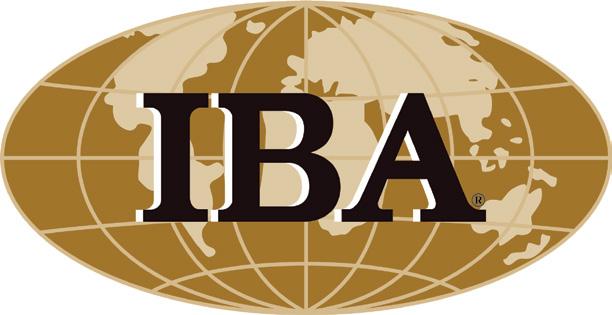
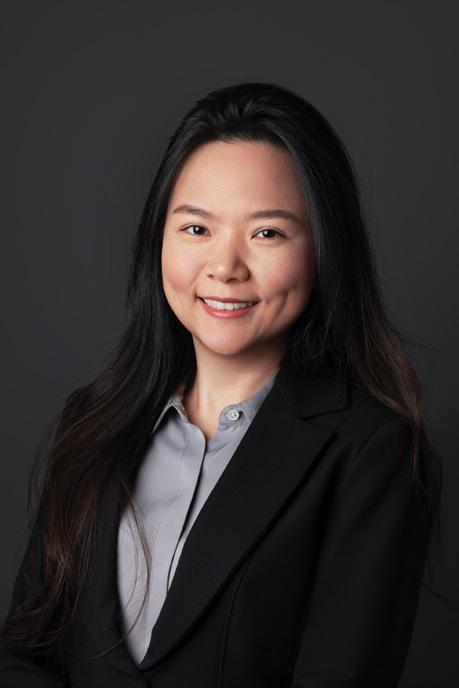
10 UW MAGAZINE ROAR FROM THE CROWD JOIN THE CONVERSATION EMAIL YOUR COMMENTS TO: magazine@uw.edu (Letters may be edited for length or clarity.)


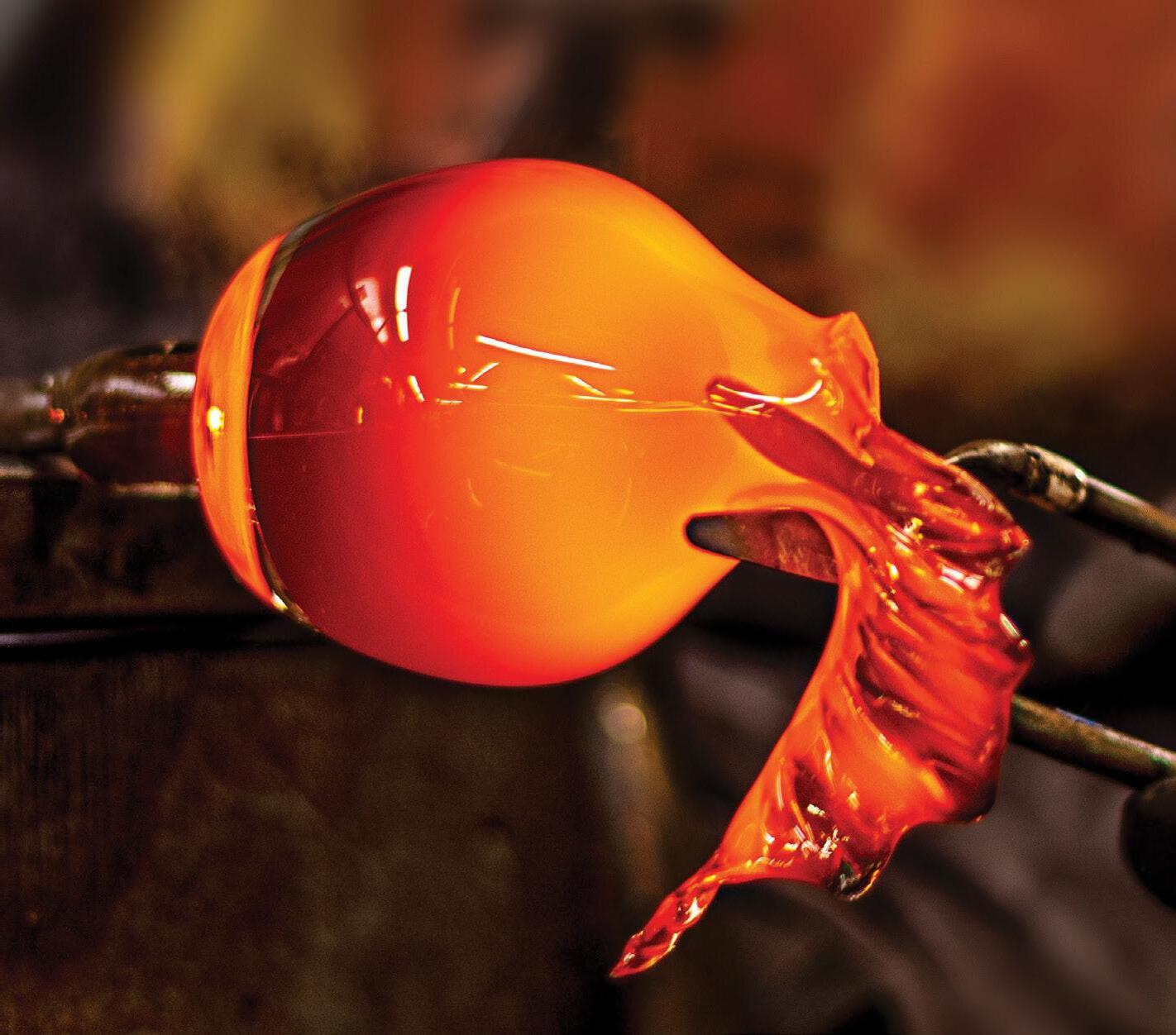

HANDCRAFTED HUSKY PICKS
Every University of Washington glassybaby begins as glowing molten glass in the heart of a furnace. At glassybaby’s hot shops here in Washington state, artisan glassblowers transform hot glass into your unique purple-and-gold keepsake. Creating one at a time, their process takes the clear glass from artfully coloring to shaping the glassybaby’s distinctive curves, trimming the edges and slowly cooling it in a controlled oven. It’s the perfect way to fi re up your Husky spirit.
Get your one-of-a-kind UW glassybaby at glassybaby.com
realdawgswearpurple wearpurple UWearPurple


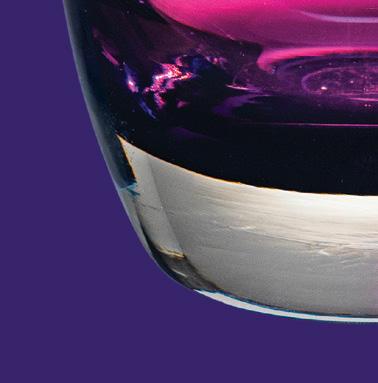



Tribes, Treaties and Justice
The Boldt Decision, which turns 50 this year, reaffirmed tribal fishing rights in Washington and marked a turning point for tribal sovereignty
By Hannelore Sudermann
In a peaceful demonstration, Muckleshoot �ribe members practice their fishing rights in October 1970 in the Green River. At the time, Washington state law restricted Native fishing in spite of treaties that guaranteed tribal members the right to fish.
In 1945, 14-year-old Billy Frank Jr. was arrested for fishing. A member of the Nisqually tribe, Frank was charged with poaching even though it was at a site his family and ancestors had fished for centuries. Furthermore, the 1854 Treaty of Medicine Creek guaranteed him and other Indigenous people the right to fish “at all usual and accustomed grounds and stations.”
But state officials and commercial and sport-fishing interests had been working for decades to curtail Indian fishing. Local police officers and game wardens confiscated catches and gear, arrested Native fishermen and sometimes resorted to violence, firing guns at their boats and assaulting them and their families.
By 1974, Frank was a Korean War veteran and a well-known Indian rights and environmental activist. He practiced his civil disobedience in a boat with a fishing net. That was also the year of the landmark federal case known as the Boldt Decision—in which the federal government and 20 tribes sued the state of Washington to protect Native peoples’ rights to fish and won. The case later shaped the national understanding of Indian rights and tribal sovereignty.
In the decades leading up to the
decision, Native American communities in Washington state had struggled to exercise their fishing rights. But in the late 1960s, their issue became part of the Civil Rights movement and drew supporters from around the country to the cause. The heart of the activism was at Frank’s Landing, a site on the Puyallup River between Tacoma and Olympia where generations of the Frank family have lived that also served as a gathering place for tribal fishermen.
“It wasn’t just about fish,” says Richard White, ’72, who joined the protests at Frank’s Landing in the summer of 1968 and whose experience there led him to become a historian of the American West. “It was about shellfish, it was about other things.” White witnessed the chaos and police raids as well as peaceful acts of civil disobedience: tribal members simply putting their boats in the water and fishing. He saw the emergence of new Indigenous leaders like Hank Adams leave their studies at the UW and become activists.
At the time of the fishing-rights case, Native fishermen were taking only about 5% of the harvest, with the commercial fishers taking 90%, according to Charles Wilkerson, an expert in Indian law and author of “Treaty Justice: The Northwest
Tribes, the Boldt Decision, and the Recognition of Fishing Rights,” which the UW Press published in January. Wilkerson’s history—written at the request of Billy Frank Jr., who died in 2014—tells the broad saga of Indian fishing rights in Washington, highlighting significant events and individuals—like lawyer Jack Tanner, ’55, the president of the NAACP’s Washington chapter. He was hired by the tribes to fight their case in court. And another, anthropologist Barbara Lane, ’53, who provided expert testimony at the trial about the culture and history of the tribes, the circumstances around the Medicine Creek treaty and contemporary tribal lives and values. Wilkerson describes Lane as “the most important witness in the trial.”
In his U.S. District Court decision, Judge George Boldt affirmed the tribal members’ rights to fish and guaranteed them 50% of the harvest through their traditional fishing grounds and as co-managers of the state’s fisheries. One outcome of the decision is tribal governments’ increased role in protecting salmon and steelhead populations and their habitat here in Washington.
“This and other seminal cases from the Northwest became precedent for cases across the country,” says Ned Blackhawk, ’99, a member of the Te-Moak Tribe of Western Shoshone and scholar of Native American history. “The Boldt decision was among the most important exertions of Native American treaty rights in American history. It was tremendously generative and controversial.” What unfolded in Washington set precedent and encouraged tribes across North America to affirm their own sovereign and treaty rights, he adds.
To honor Frank, the Washington Legislature voted to install a statue of him in the National Statuary Hall in Washington, D.C. “There’s going to be a lot of attention this year as Washington turns the story of the Boldt decision into a kind of celebration,” White says. “The story starts with the struggle and ends with Billy Frank Jr. in the U.S. Capitol.” What shouldn’t be forgotten, he adds, is that state and national leaders “spent years trying to cut off funding to the Indian fisheries community and sought to strip the tribes of power.”
The 9-foot-high bronze statue of Billy Frank Jr. by sculptor Haiying Wu, ’96, is scheduled to be unveiled in 2025.
NEWS AND RESEARCH FROM THE UW 12 UW MAGAZINE
MOHAI, SEATTLE POST-INTELLIGENCER COLLECTION, TOM BARLET

Dazzling Display
Artist Raúl de Nieves blends mystical symbols and Mexican craft in the Henry Art Gallery’s largest exhibition room for “A window to the see, A spirit star chiming in the wind of wonder … ” Acetate-and-tape “stained glass” windows cover the massive skylights and fill the room with provocative content and vivid color. It’s a welcome break from the sometimes gray Seattle spring. The title of the show comes from a poem composed by de Nieves while he was making the windows. The exhibit runs through Aug. 25. Photo by Jonathan Vanderweit
STATE OF THE ART TAPE AND ACETATE
Swan Song
Brad McDavid is retiring after 30 years as the director of the beloved Husky Marching Band
By Jon Marmor

The purple sport coat. The white gloves. The beaming smile. The waving arms. We loved seeing them on autumn Saturdays over the past 30 years as Brad McDavid went into action leading the Husky Marching Band in one of the most picturesque stadiums on the planet. And now, after playing three of our favorite songs—“Bow Down to Washington,” “Tequila” and “Louie, Louie”—a jillion times, McDavid, the longest-serving
band director in school history, is calling it a career.
Here are a few items of note about McDavid, considered by some band members as the best teacher they have ever had:
20: Number of bowl games the Husky Marching Band has performed in 240: Number of members in the Husky Marching Band each year
7,000: Number of students he has worked with over his career
“I have loved coming up with halftime shows that hopefully over the course of a season tickled the musical funny bone of everybody in the stadium,” the tuba-playing Ohio native said in a recent interview on KING-5 TV.
And now, for McDavid’s outro.
Retiring Husky Marching Band director Brad McDavid looks forward to watching his son perform as the drum major of the WSU Marching Band.
14 UW MAGAZINE
RON WURZER
Alzheimer’s ‘Milestone’
New drug is shown to slow the disease progression
By Hannelore Sudermann
Doctors at UW Medicine are among the first to treat patients with a new drug that slows the progression of Alzheimer’s. They describe it as a first step toward revolutionizing the treatment of the disease.
“In many ways, Alzheimer’s disease is the biomedical challenge of our time,” says Dr. Thomas Grabowski, ’88, director of the UW’s Alzheimer’s Disease Research Center and Memory & Brain Wellness Center. In the U.S., about 6.5 million people—and one in nine over 65—are living with Alzheimer’s dementia. That number is expected to grow to 14 million by 2060. It is one of the leading causes of death.
But while scientists have made significant progress developing treatments for cancer, heart disease and diabetes, they are decades behind in understanding how Alzheimer’s
disease works and in developing ways to counter its progression. “We’re just now understanding some of the fundamental biology of it,” Grabowski says. He describes amyloid plaques and twisted strands of proteins—tangles—that are suspects in the death of nerve cells and the loss of brain tissue that come with Alzheimer’s. “There are too many suspects, and they all know each other,” he says. “It’s like ‘Murder on the Orient Express.’”
Until now, doctors have only been able to control some of the cognitive and behavioral symptoms of the disease. Enter the new drug lecanemab, which is shown to slow the progression of Alzheimer’s in patients in the early stages of the disease and to reduce the presence of amyloid plaques. An antibody, lecanemab binds to the plaques and stimulates the immune system to remove the amyloid. In testing, the drug slowed the patients’ rate of decline by 27% over 17 to 18 months. Of note, while most Alzheimer’s drug trials have lacked racial diversity, about 25% of the lecanemab trial participants were either Black or Hispanic; both populations are 1.5 times as likely as white individuals to develop the disease.
Last July, the Food and Drug Adminis-
tration approved lecanemab, which is sold under the brand name Leqembi, for the treatment of Alzheimer’s disease. That same month, Dr. Michael Rosenbloom joined the UW Memory & Brain Wellness Center. One of his roles is to champion efforts to make the medicine available to patients. “It took six months to figure out what we needed in order to do it,” he says. The drug is administered through IV in-
There are too many suspects, and they all know each other
fusion every two weeks, and patients need regular MRI scans. While the benefits are described as modest, “it’s a new milestone in the treatment of Alzheimer’s disease,” Rosenbloom says.He describes the medicine as a major step forward. “It’s probably the beginning of a new order in how we treat Alzheimer’s.”


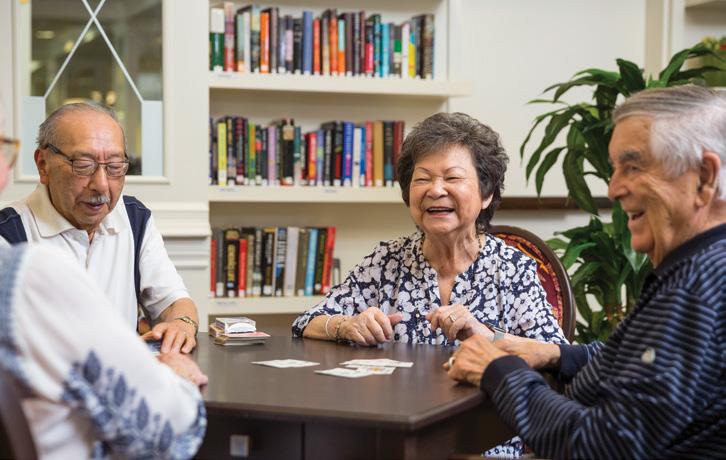
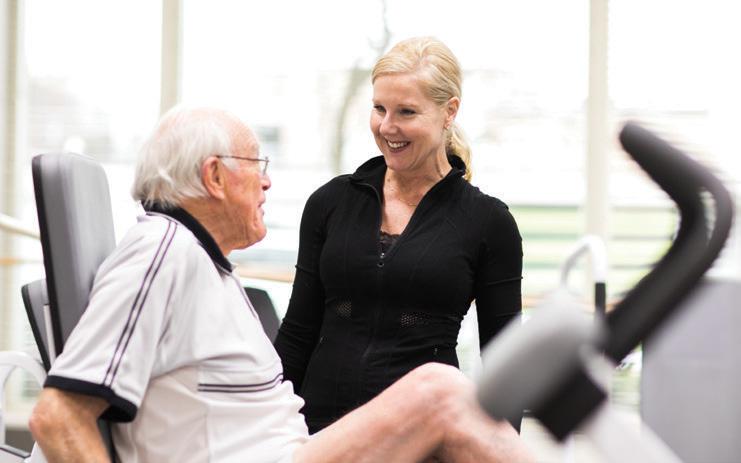










SPRING 2024 15 Find
and Joy IN EVERYDAY LIVING ERA LIVING PREMIER RETIREMENT LIVING OFFERS TWO AWARD-WINNING UNIVERSITY LOCATIONS: A University House retirement community is a lifestyle — one that's rich in intellectual stimulation and emotional engagement, exquisite dining and invigorating exercise classes. Providing a vibrant stage for your golden years, University Houses are designed with your future in mind. Visit eraliving.com/joy or call (206) 333-0290 to learn more! Both Wallingford and Issaquah locations offer special benefits for members.
Connection
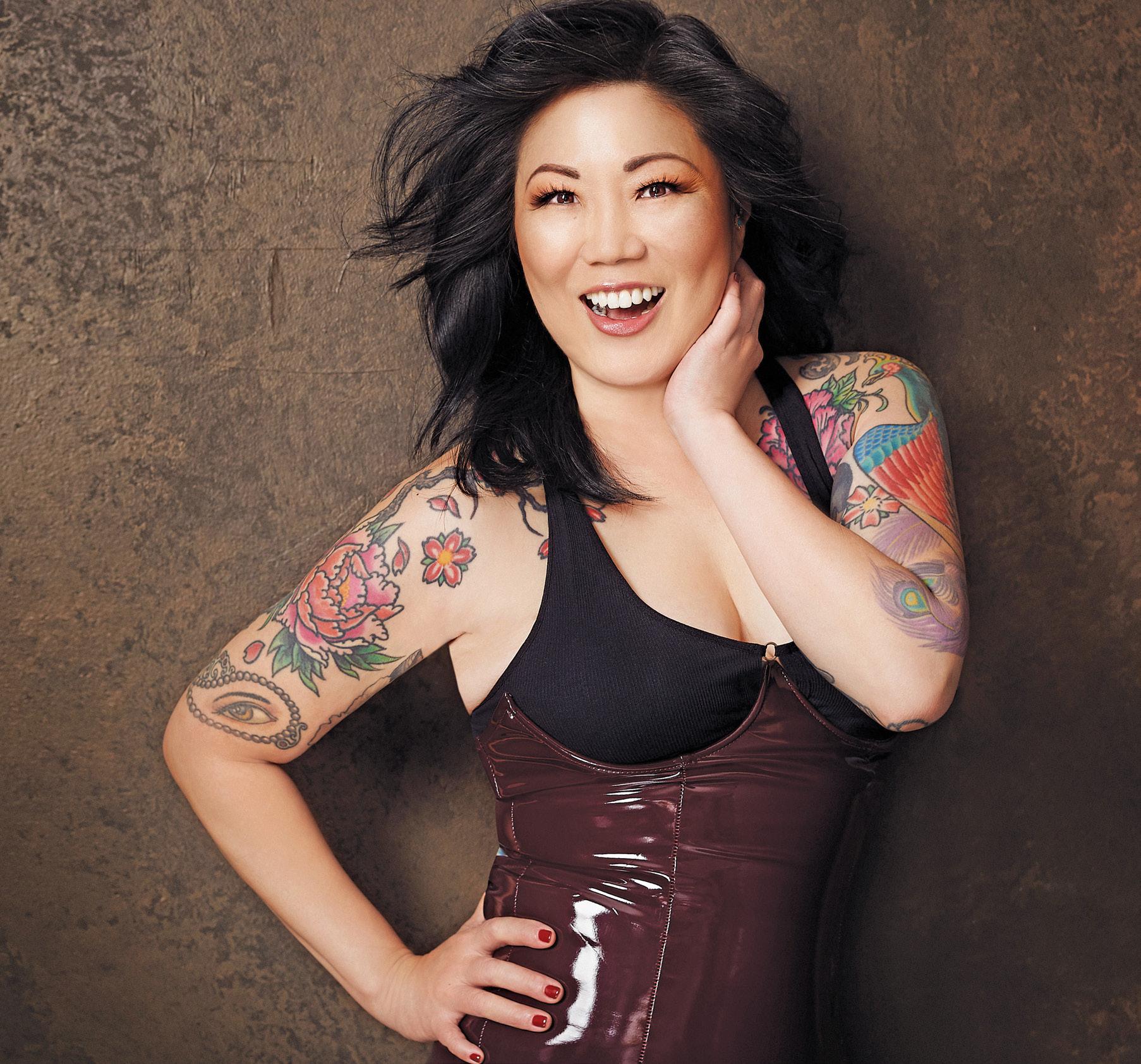
Always Identity Forward
Margaret Cho uses comedy for social and personal change
By Shin Yu Pai
On May 1, the Graduate School Public Lecture Series hosts An Evening with Margaret Cho. �he comedian, actress, musician and advocate for the queer community will share stories of her career and her thoughts on current events.
For the past 40 years, performer Margaret Cho has been tackling identity issues through stand-up comedy.
The five-time Grammy and Emmy nominee has been named one of Rolling Stone magazine’s 50 Best Stand-Up Comics of All Time, while CNN chose her as one of the 50 People Who Changed American Comedy. Now Cho brings her politically progressive and unapologetic humor to Seattle on May 1 for an onstage conversation at Town Hall, as part of the UW Public Lectures series.
Fresh from watching the Golden Globes
In addition to exploring her Korean family roots, her comedy boldly interrogates her own perspectives on gender and queer issues. She openly talks about her own gender dysphoria and her path to being open about her sexual identity. These are issues and conversations that she imagines young people and college-aged audiences are thinking about, too. “So much of my work is really about identity and in juxtaposition to the [white male] world that I’m in,” says Cho. “I’m always identity forward as a comedian. It’s always got that in there, whether I’m performing at a comedy club or on social media.”
This focus on identity is also interwoven into Cho’s love for making music. She sees
Cho is excited about what has shifted in Hollywood
music as another avenue of creative expression that allows her to subvert the Asian American stereotype of overly disciplined kids forced to take music lessons and grow up to be musical prodigies. “You had to be all of those things,” Cho says. “But they didn’t want you to like it too much.” Cho’s parents made her take piano lessons from a young age and expected her to be part of her church choir. But it wasn’t until she decided to become an artist that this interest posed a problem with her family. Today, Cho’s preferred instrument is the guitar. And she counts Fiona Apple and Olivia Rodrigo among her influences, as well as Bob Dylan— whom she calls “a great humorist.”
and a powerful night of public recognition for Asian American actors and their projects, Cho says she is excited about what has shifted in Hollywood. “‘Beef’ won for best series. And Steven Yeun and Ali Wong made history,” she says. “It’s an incredible achievement within a very white establishment.”
When Cho started in comedy in the 1980s, there were few Asian faces or voices on television or in the movies. Cho notes that now, it’s not just actors getting attention. “It’s also the quality of writing and projects.”
In 2024, Cho continues to share her stand-up comedy with audiences across the country. She sees touring in an election year as a necessary way to boost community morale and call for unity. “I was doing a lot of dates in Florida, where it was frankly dangerous to be when they are issuing warnings for gay people,” Cho says. “Yet the audience needs that so much. There are queer people who live there who need a kind of escape.”
Cho’s appearance in Seattle will be a moderated stage conversation. While the event is separate from her “Live & Livid” tour (she will be performing stand-up in Bellingham on May 3), there will be some component of comedy interwoven throughout the program.
An Evening with Margaret Cho will be May 1 at �own Hall Seattle. Registration opens March 13.
16 UW MAGAZINE
SERGIO GARCIA
KEXP to Bring Its Eclectic Music to San Francisco
By Jon Marmor
The already hip Bay Area airwaves are about to become even hipper. That’s because KEXP, the eclectic, non-commercial radio station affiliated with the University of Washington, just bought Alameda/San Francisco radio station KREV 92.7 FM as part of a bankruptcy auction.
In a statement on the KEXP website, CEO Ethan Raup says, “On any given week, KEXP’s audience now includes tens of thousands of streaming listeners and over a million YouTube viewers. We already know that a good portion of our community lives outside the Seattle market—and that’s a strength. KEXP is open to music lovers everywhere, thanks in part to your support.
“With that in mind, we’ll continue to champion Pacific Northwest music and artists in every way we do now. And we’ll continue to be up front that our broadcast is rooted in a specific place, with real human hosts on the mic in our Seattle Center home, no matter where our lis -
teners are located.”
Raup’s statement addresses one of the reasons for the purchase. “Over the years, we’ve seen constraints in listenership related to the weakness of our Seattle-area signal. ... We’ll certainly continue our focus on digital and streaming capabilities. But I’m a strong believer that terrestrial radio will be with us for a long time, and I think we’ve already seen how broadcast and digital listening can build off one another to create a stronger music community.”
When the Bay Area station begins broadcasting in the coming months after receiving FCC approval, Raup explains that it will air the same programming that you’ll hear on the radio in Seattle. “We’ll also launch a Bay Area local music show that will air regionally (similar to “Audioasis” in Seattle). We’ll also be doing our best to build relationships and connections with the local music scene that will help us define the evolution of the Bay Area station.”

Modern Slavery is on the Rise
A new global commission taps UW Law’s Anita Ramasastry
By Shin Yu Pai



Recent news stories highlight the fact that forced labor and child labor still exist across global supply chains. In the U.S., there are news accounts of unaccompanied migrant children working in factories and meat-processing plants supplying major brands.
Other stories have focused on the increased demand for cobalt to make batteries for electric vehicles, mined by child laborers in the Democratic Republic of the Congo. Preparations for the 2022 World Cup drew thousands of workers to Qatar to ready the country for that global event. Many had to surrender their passports to their employers and were unable to change jobs or leave the country.
Modern slavery, forced labor and sexual exploitation are a reality for millions of people all over the world. Today, in the wake of armed conflicts, COVID-19 and climate change, the problem is on the rise, according to the United Nations. In response, a new Global Commission on Modern Slavery and Human Trafficking has been formed and Professor Anita Ramasastry, who has built her expertise in business and human rights, recently joined. “The data on forced labor is going up. Not down,” Ramasastry says. “Even if someone is recruited into a forced-labor situation and then released, they are often left in debt bondage.”
Efforts to solve the problems have often been fragmented, and governments have failed to step up the pace of reform. Ramasastry, a UW law professor, hopes that innovative economic models and financing practices will help move past these bottlenecks.
REUTERS
Migrant workers in Qatar in advance of the 2022 World Cup were subject to forced labor, trapped by debt and poor working conditions.
SPRING 2024 17
YOUR VISIT
MUSEUM. MILLIONS OF STORIES.
PLAN
ONE
AT WORK AT WORK
PALEONTOLOGISTS PALEONTOLOGISTS

Native American
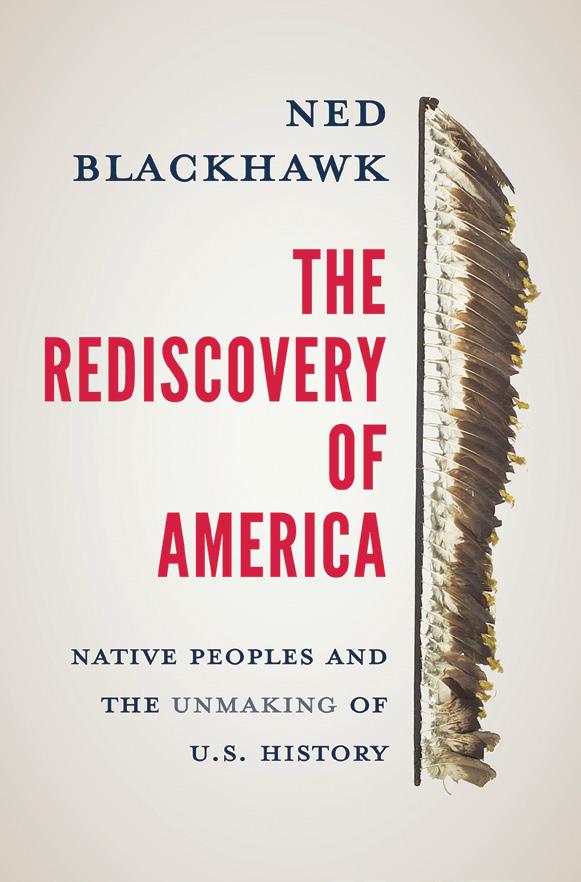
RESEARCH
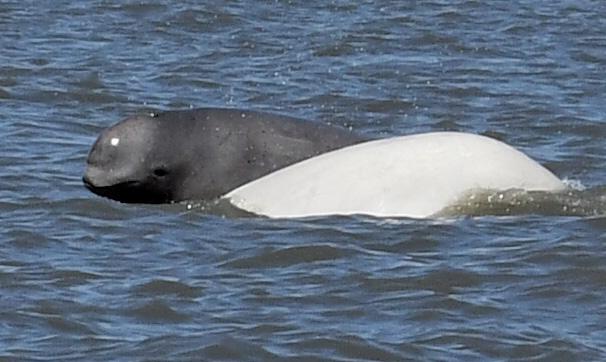
BELUGA BARRAGE
Beluga whales in Cook Inlet in Alaska use acoustics to navigate, find prey, avoid predators and maintain group cohesion. But UW research has found that increased noise from human activities is having a negative impact on these social mammals. “Commercial shipping, an international airport, military operations and gas and oil exploration are all concentrated there,” says Arial Brewer, UW doctoral student in the UW School of Aquatic and Fishery Sciences.

SLIPPING SLEEP
By Hannelore Sudermann
When Ned Blackhawk was in grade school in the 1970s, American history was taught from the perspective of European colonists. The lessons, which started with the arrival of Christopher Columbus in 1492 and carried the tale from east to west, described a vast and vacant landscape with a smattering of human inhabitants.
A history professor at Yale University and the author of ‘�he Rediscovery of America,’ Ned Blackhawk, ’99, is a leading voice on the Indigenous origins of America.
The textbooks went on to tell how, over several centuries, waves of white settlers flowed west into the wilderness, taming the landscape, tapping resources and building farms, then towns, then cities. But that version is far from the full picture, says Blackhawk (Te-Moak Tribe of Western Shoshone), a professor of history and American studies at Yale University and one of the nation’s leading Native American history scholars.
In November, Blackhawk, ’99, won the National Book Award for “The Rediscovery of America: Native Peoples and the Unmaking of U.S. History.” His book, which was published by Yale University Press, reconsiders our nation’s narrative, this time seeing Native American people more fully in time and in events over 500 years.
Before Columbus stepped foot on our
shores, he writes, North America was home to millions of people. It had powerful empires, cities, trade, power, wars, politics and cultures. As the Spanish, French and English colonists intruded, Indigenous communities adapted, avoided and, often in the spirit of protecting themselves and their holdings, attacked. From his first chapters, Blackhawk reframes our national narrative as one of encounter rather than discovery.
Highlighting key moments and events throughout U.S. history, Blackhawk captures the fragility of the early settlers who were ill-prepared for survival and depended on help from the Indigenous communities around them. He also points to the Indigenous origins of the American Revolution and to the presence of Native people in the minds and actions of the country’s founders, who often intended to assimilate or eradicate them. In the Declaration of Independence, for example, the text quickly moves from all men being created equal to describing “merciless Indian savages” who fought on behalf of England.
Covering more recent history, Blackhawk
Continued on p. 50
The UW’s move to the Big Ten Conference in 2024 means more travel for student-athletes. And that could be a problem. “More east-west travel and more travel time has … added a sleep disparity to it,” says Horacio de la Iglesia, UW professor of biology and a circadian rhythms expert who was the co-author of a white paper on the subject. “Proper sleep is critical for health, and we can’t let the health of our student-athletes get out of focus.”

AI, MEET DIVERSITY
If you use the popular artificial-intelligence image generator Stable Diffusion to conjure answers, too frequently you’ll see images of light-skinned men. Stable Diffusion’s perpetuation of this stereotypical practice is among the findings of a new UW study. Researchers also found Stable Diffusion failed to equitably represent Indigenous peoples. “It’s important to recognize that systems like Stable Diffusion produce results that can cause harm,” says UW doctoral student Sourojit Ghosh.
DAN
RENZETTI
18 UW MAGAZINE
JAROMIR CHALABALA
ARIAL BREWER
UW NEWS
Ned Blackhawk wins the National Book Award for his book on the real role of Indigenous people in the history of America
A FUTURE WHERE YOUR PAYCHECK DOESN’T IMPACT YOUR PREGNANCY.
People who can’t afford or access prenatal care are more likely to suffer pregnancy-related complications.
Healthier communities make healthier people. The University of Washington is leading the way in addressing the interconnected factors that influence how long and how well we live, from poverty and health care to systemic inequities and climate change. In partnership with community organizations, the UW transforms research into concrete actions that improve and save lives across the country — and around the world.

uw.edu/populationhealth
MORE
LEARN

A Wild Year Ends, Fresh Hope Arrives
A season of stunning success brings big expectations for new Husky Coach Jedd
Fisch
By Jon Marmor
My head hasn’t stopped spinning since the end of football season—or the week that followed the end of football season. In a season unlike any other on Montlake, the Huskies went undefeated, beat Oregon (for the second time this season) to win the very last Pac-12 championship ever and then survived Texas in a thrilling Sugar Bowl / College Football Playoff semifinal. That was before Big Blue (Michigan) made us blue in the 34-13 loss in the national championship game.
The Huskies’ richly deserved recognition could have filled up Husky Stadium: Quarterback Michael Penix Jr. was the runner-up for the Heisman Trophy; the UW offensive line captured the prestigious Joe Moore Award as the best blocking front in the nation; and Coach Kalen DeBoer was the consensus national coach of the year for leading the Huskies to a stunning 14-1 record a mere two years after the pre-DeBoer Huskies stumbled to a 4-8 record.
The highs were so high. But then came a stunner: Two days after the national championship loss to Michigan, DeBoer announced that he was leaving to take the head coaching job at Alabama.
While we were trying to catch our breath from all of that, athletic director Troy
Dannen announced two days after DeBoer left that he had hired Jedd Fisch as the new Husky head coach. The well-traveled Fisch brings an impressive resume to the Emerald City from the University of Arizona, where he turned around a moribund Wildcat program in three years. After a 1-11 inaugural season in the desert, Fisch’s Wildcats went 5-7 in 2022 and 10-3 in 2023, the school’s fourth 10-win season ever. That included an eye-opening victory over powerful Oklahoma in the Alamo Bowl.
“We wanted to move quickly but thoroughly and sought out a coach who would build on our foundation, bring energy to the program, has a track record of success, is an elite recruiter and was someone who young men wanted to play for,” Dannen explained. “We found all of those characteristics and more in Jedd Fisch. It became clear through our conversations that he shares our values and our vision for UW Football, and he is
the right coach at the right time as we transition to the Big Ten Conference.”
The Huskies are wading into transitions on several fronts: DeBoer’s departure, Fisch’s arrival, the departure of many Husky football players via the transfer portal, graduation or turning pro. That’s on top of the biggest transition of them all—competing in the Big Ten beginning in the fall.
“I don’t think anybody will have experienced as much roster turnover as we will experience here at Washington from the ’23 season to the ’24 season,” Fisch said at his introductory news conference. But if anyone knows how to deal with transition, it’s Fisch, a New Jersey native and Floridaeducated coach who has held positions all over college and pro football. “Now,” Fisch said, “the idea in the Big Ten is to win consistently, to play against the Michigans, the Penn States, the Ohio States, the USCs, the Oregons, every single year and compete at their level. At our level.
“That’s where I think Washington becomes a special place.”
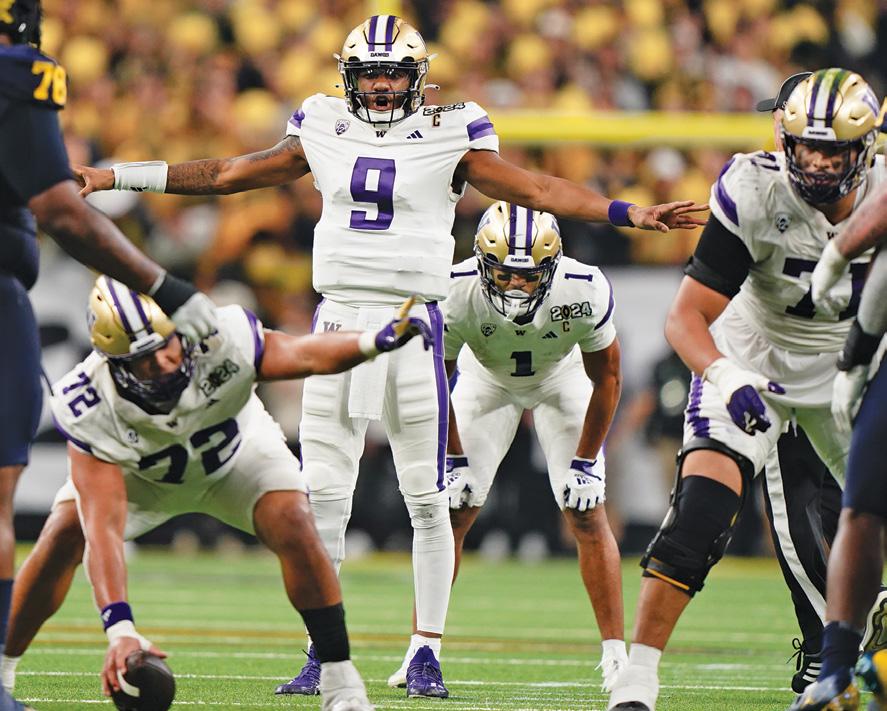
20 UW MAGAZINE
ATHLETICS COMMUNICATIONS (2)
Above: Newly arrived from Arizona, Jedd Fisch has the eyes of Husky nation on him as he takes over as the UW’s head football coach. Right: Quarterback Michael Penix Jr. led the Huskies to the national championship game.

BIG hearts, BIGGER impact
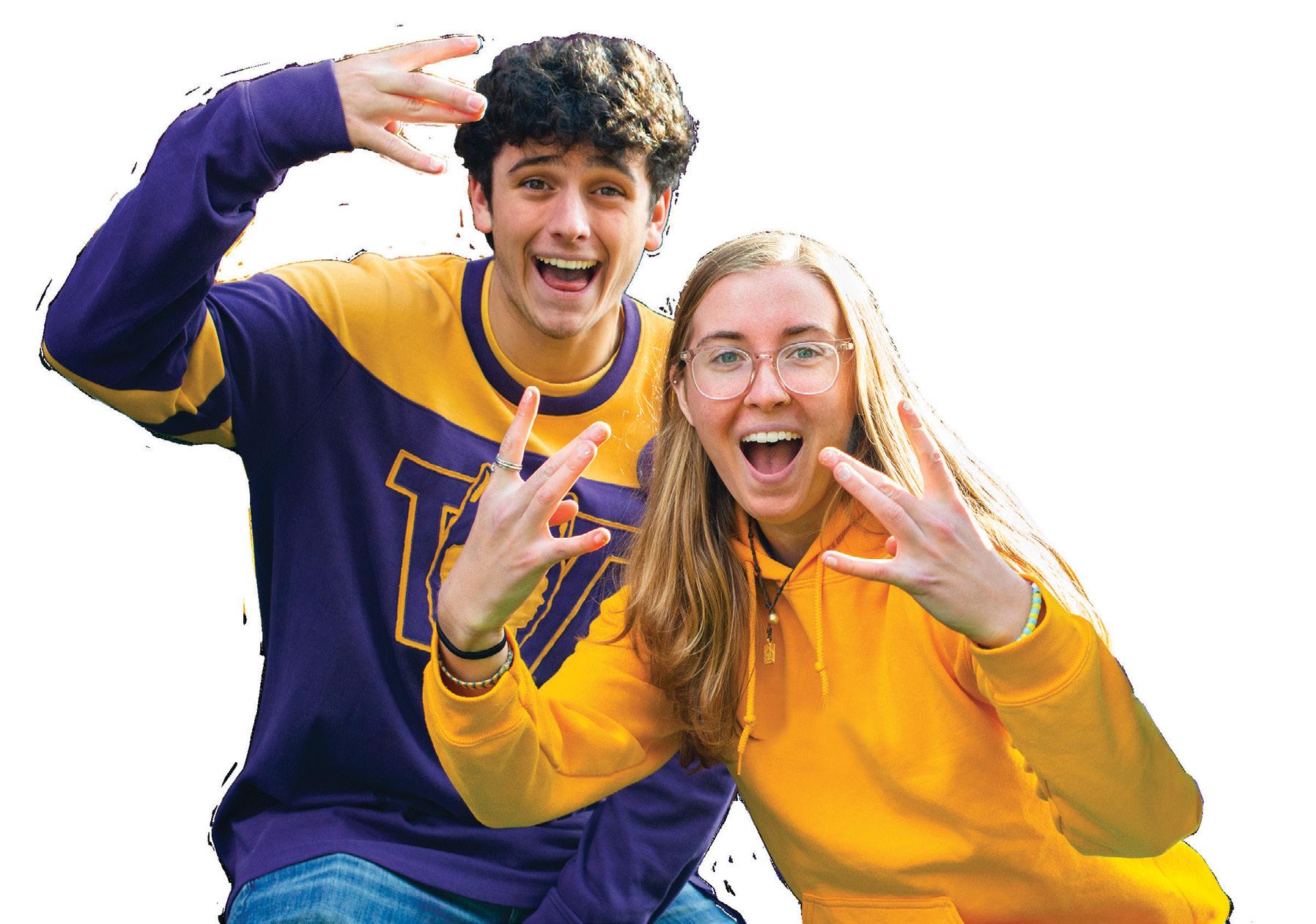


Show your love for the UW on April 4, 2024
This Husky Giving Day, let’s turn each small act into a wave of impactful change. Join us and be part of something extraordinary!
EXPLORE the Husky Giving Day experience, stories of impact and participating programs by scanning the QR code.
GIVE at givingday.uw.edu on April 4.
SHARE your UW love on social media using #HuskyGivingDay.

> > >

22 UW MAGAZINE
Anida Yoeu Ali interacts with a museum patron in a live performance of ‘�he Buddhist Bug.’
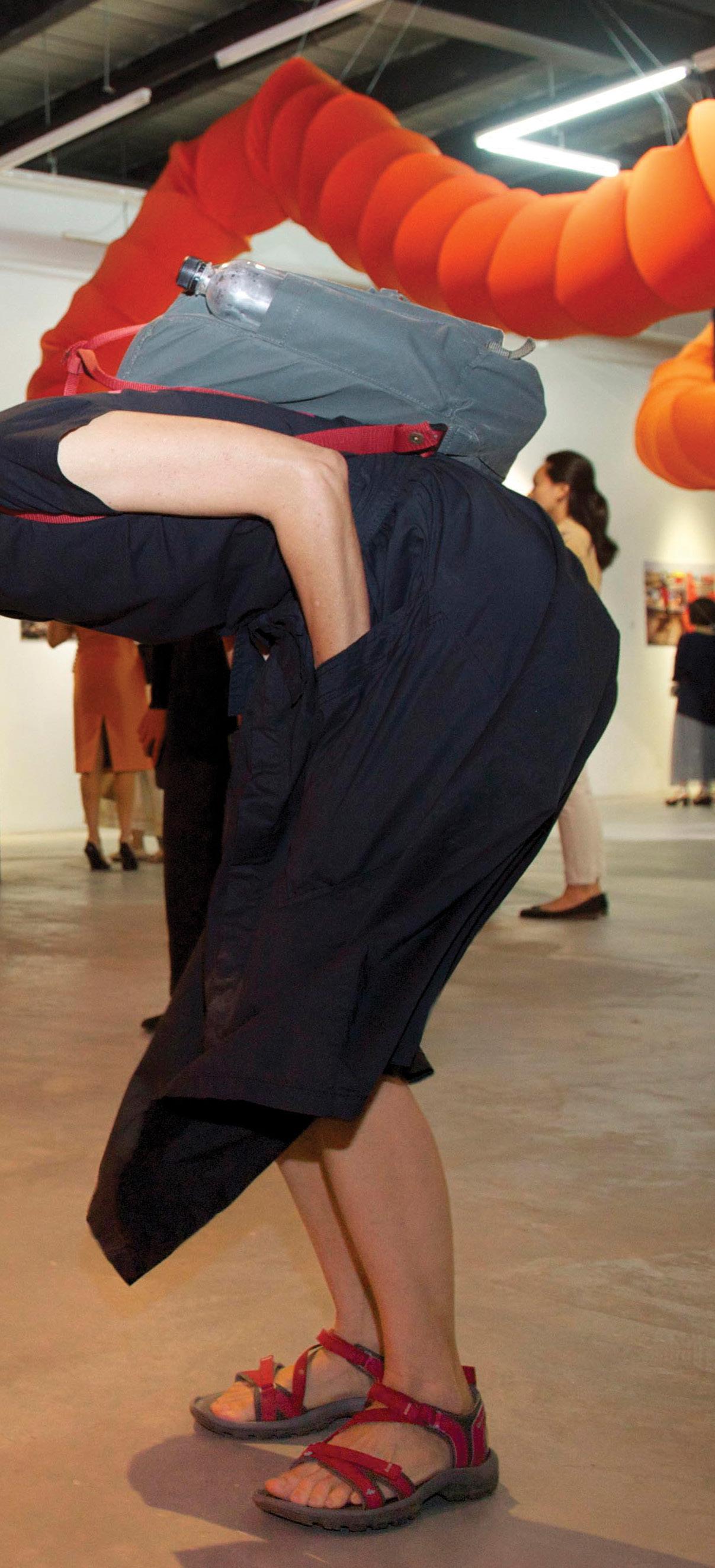
AR T I S T, A GI TA T O R, BUG
UW Senior Artist-in-Residence Anida
Yoeu Ali
opens a solo show at Seattle Asian Art Museum
BY SHIN YU PAI
Last November, Anida Yoeu Ali worked feverishly with a team of volunteers to stretch giant vinyl photos of her performances onto wood and aluminum frames. Assembling the lively, large-scale project for her upcoming solo show at Seattle Asian Art Museum, she had no time to waste. She had just a few days to do it all before leaving for Cambodia for a month, where she worked on finalizing a sculptural piece for her SAAM show.
Ali, a senior artist-in-residence at UW Bothell, has exhibited and performed around the world, from Phnom Penh to Paris. Her “Red Chador” performance— where she dons a sequined full-body cloak and even covers her face—debuted in 2015 in France, where it is illegal to wear face coverings. The costume commentary on what it is to be Muslim and about prejudice and hate crimes has appeared in cities including Seattle, Hong Kong, Washington, D.C., and Tel Aviv.
Born in Battambang, Cambodia and raised in Chicago after her family fled their homeland to escape the Khmer
PHOTOS COURTESY ANIDA YOEU ALI
SPRING 2024 23
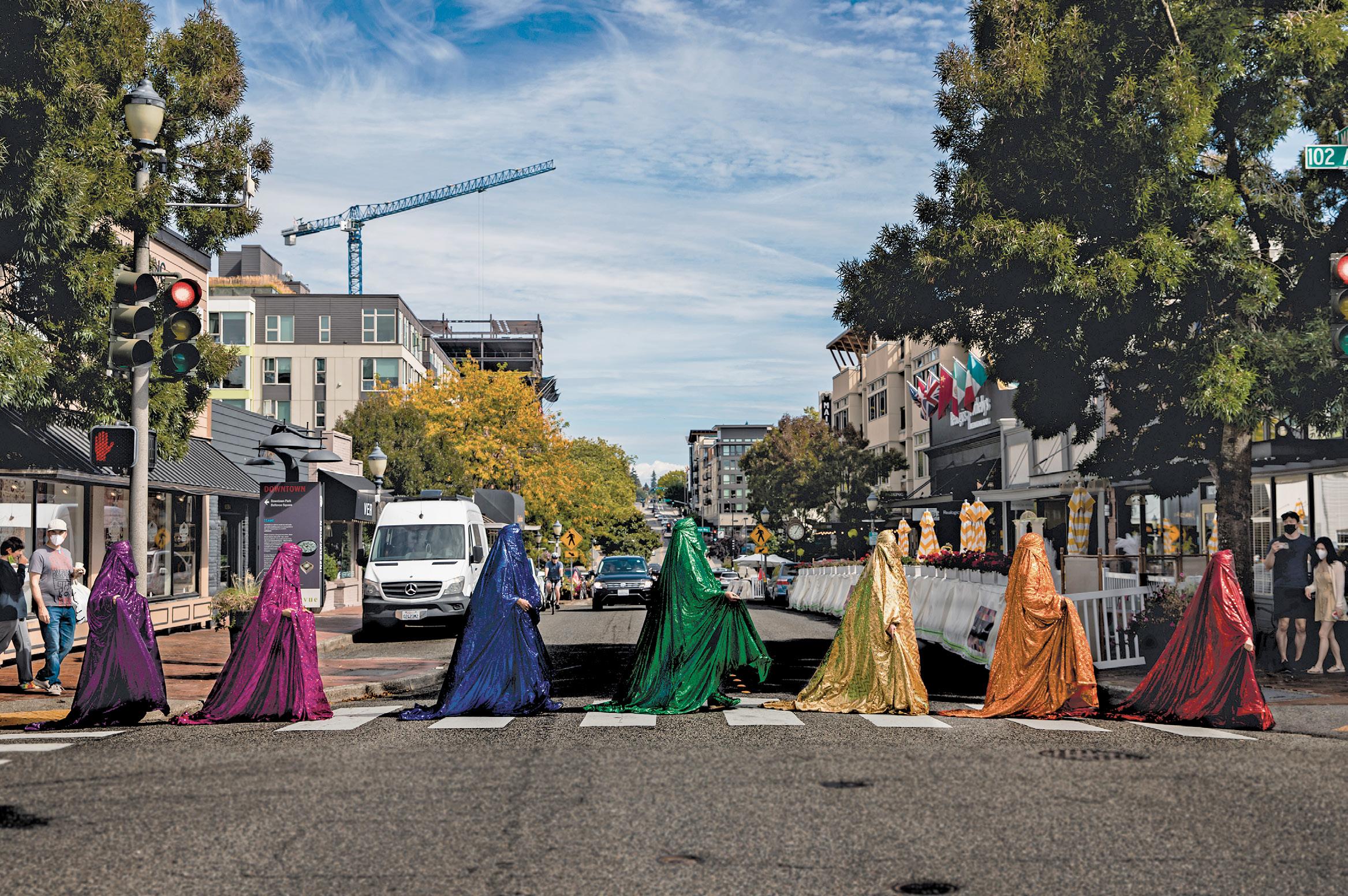
Rouge, Ali takes on serious subjects like her Cambodian American experience, being Muslim in a Buddhist space, and gender and identity, and explores them in colors and costumes that are both unsettling and endearing, even charming. Her vibrant “Buddhist Bug” costume is 100 meters long. Her face peeks from one orange end. Seeing her embody the bug and seeing people around her respond can spark curiosity, even delight.
Though she’s primarily a performance artist, Ali’s museum exhibition focuses on performance installation: photos and videos that document her time-based, site-specific work. At the Volunteer Park museum show, “Hybrid Skin, Mythical Presence,” visitors can interact with a variety of Ali’s art. The large-scale photographic murals of Ali and others in costume and out in streetscapes often capture public encounters. Videos show her art in action—as she stands in a public space and the people nearby either respond or ignore her. Various performance-related artifacts, including the textiles she and others wear in her performances, fill the quiet, 90-year-old Seattle museum with color. As if that’s not engaging enough, Ali will activate the exhibition with two performances this spring.
The SAAM show is an important moment for her and her community, Ali says. It marks her solo debut at a museum and the first time that SAAM has ever presented a Cambodian American artist. Ali notes that the themes in her work, like the history of war, trauma and genocide, are not frequently presented in mainstream cultural institutions. She seeks to be politically provocative and aesthetically remarkable while also conveying playfulness and joy. With this show, the artist hopes to invite new visitors from historically underrepresented communities
into the space of the museum.
The SAAM show includes video documentation of Ali’s work since 2009, paired with the extraordinary costumes from her iconic projects “The Red Chador” and “The Buddhist Bug.” The Buddhist Bug suit winds around and across the rooms. The wearable, tubular garment is a bright orange soft sculpture that occupies both volume and space. Ali says the project speaks to themes of displacement and belonging, and “figuring out who you are and how you present yourself to the outside world.”
“The bug is not a very fast creature and doesn’t do much except for really being present and aware,” says Ali. “She agitates as much as she can with her eyes and her face. And how she sways and wiggles and lures people forward.” The public is encouraged to get as close to Ali as possible and to be daring. Ali finds that children are the most courageous and curious in engaging with her as “The Buddhist Bug.” Ali knows her work won’t reach or connect to everyone, so she focuses on speaking to the audiences who don’t see enough of themselves or their stories reflected back to them.
Ali initially studied graphic design, choosing a field that she thought would please her parents enough while still allowing her to take art classes. She minored in art education as a practical backup. During college, she threw her energies into activism. She organized with other students at the University of Illinois Urbana-Champaign to advocate for an Asian American studies program and cultural center. Her activities brought her into the world of creative writing, poetry and literary magazines through which she discovered artists who weren’t mentioned in her art survey classes.
After college, Ali realized how expensive an art-making practice
24 UW MAGAZINE
Performance artist Anida Yoeu Ali and her fellow performers appear in Bellevue in 2021. �he piece is titled ‘Abbey Road, �he Red Chador: Genesis.’
can be. So she started composing spoken-word poetry and formed the legendary performance poetry group I Was Born With Two Tongues (1998-2003). Later, she organized a multi-media theater group across several cities called Mango Tribe. “We made experimental work engaging with themes of domestic violence, queer bodies and sexual assault,” she says. As Ali toured the world as a spoken-word artist, she realized that she couldn’t fully broach the language divide between herself and her audiences. So she began to shift from poetry to non-verbal and visual performance art. Ali enrolled at The School of the Art Institute of Chicago for a performance degree and found her medium. “That was when I started experimenting with a form called performance installation, which is what the SAAM exhibition will showcase,” says Ali.
In 2016, she began her artist’s residency at UW Bothell. “We lived in Cambodia from 2011 to 2015 and made the decision as a family to come back to the U.S.—mainly for the children’s education,” Ali says. She had been a visiting assistant professor at Trinity College in Connecticut for a year before being drawn to the UW Bothell position. She was “excited about UWB’s interdisciplinarity and their social-justice angle,” adding it was also easier to travel to the Asia Pacific region from the West Coast.
As an artist, Ali has been grateful how UW Bothell supported her teaching a range of innovative and imaginative classes. In addition to her “global agitation” class on art and activism and a course on contemporary ‘Muslim’ artists, Ali also teaches performance for non-dancers, Southeast Asian hip-hop and urban art, and an introduction to spoken word. Finally, she teaches a global media filmmaking intensive with her life partner and artistic collaborator, filmmaker Masahiro Sugano. He also a senior artist-in-residence on the Bothell campus.
Ali acknowledges the significant creative role Sugano has played in her work. The SAAM show includes print and video collaborations between the couple. “He’s been my biggest champion,” Ali says. “I collaborate with a lot of other photographers, but Masa gets it so instantly. When he’s involved, I don’t have to worry.”
Ultimately, Ali wants her students to know that being an artist is within anyone’s reach. She encourages them to think creatively, take risks and have the courage to make something and finish it. Ali’s own practice brings her many complex identities into her work. “Someone like me—I’m a mother, a Muslim feminist and an ethnically mixed Asian American. I hold these different

identities as a genocide survivor and as a diasporic artist,” she says. “I want my students to be able to see parts of themselves in this work and know that they can dream to be an artist, too.”
On sabbatical this year, Ali is making art full-time. Beyond preparing her solo show at SAAM, she has participated in festivals in Copenhagen and Paris and is spending time at her studio in Cambodia.
Ali’s solo show at SAAM runs from Jan. 18 through July 7. Audiences of all ages will have the opportunity to see the garment come to life and the fantasy element of “The Buddhist Bug” on March 23, during a full day of family programming hosted by SAAM. On June 1, Ali is planning a longer performance with “The Red Chador.” She will pair “The Red Chador” with a vibrant rainbow of other sequined chadors that will activate all three of Seattle Art Museum’s locations at the Olympic Sculpture Park, SAAM and downtown. “I’m working with SAAM to figure out the map of how we’re going to spend all those hours traversing Seattle downtown and other corners,” says Ali.
Wearing a chador covered with sequins in a public space, Anida Yoeu Ali sends a silent message about Islamophobia and identity.
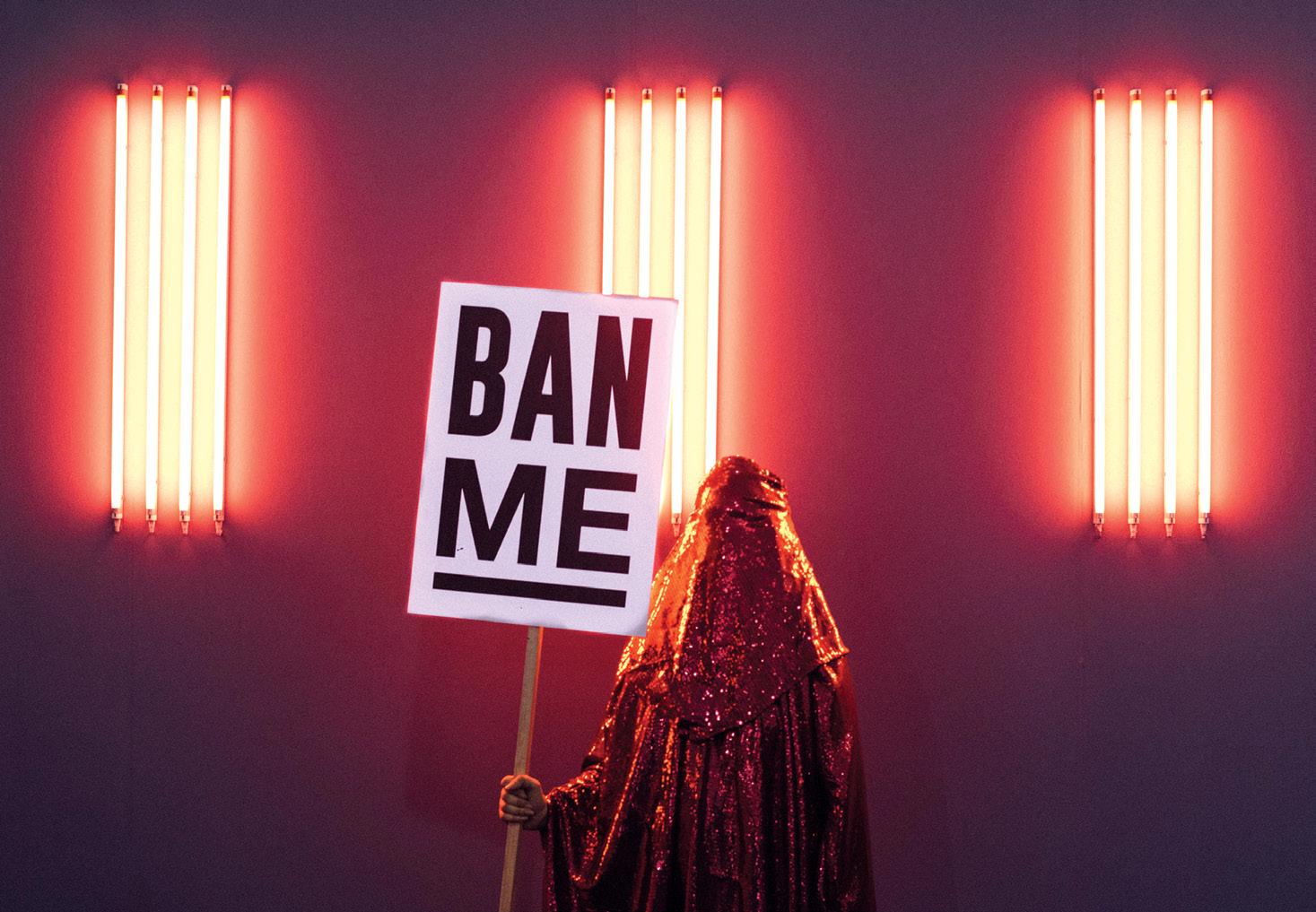
‘THE BUDDHIST BUG’ SPEAKS TO DISPLACEMENT AND BELONGING AND ‘FIGURING OUT WHO YOU ARE AND HOW YOU PRESENT YOURSELF TO THE OUTSIDE WORLD’
SPRING 2024 25
Anida Yoeu Ali teaches in the UW Bothell School of Interdisciplinary Arts & Sciences. Many of the photos of her performances are collaborations with Masahiro Sugano.
Construction management students work on devising a better way to produce concrete, the world’s most used substance outside of water, inside the Concrete Materials Lab at Magnuson Park.
Nestled in a former airplane hangar in the sprawling former Navy base at Magnuson Park, construction and engineering students from the University of Washington stress-test recipes for concrete—one of the world’s most used substances. Made with a combination of cement, water and aggregates, some type of concrete has been produced by every civilization since the Babylonians. Now, university students are joining in the centuries-long quest to refine and perfect this essential material at the University of Washington Center for Education and Research in Construction (CERC).
Dr. Fred Aguayo, who joined the faculty of the College of Built Environments in 2021, is the director of the Construction Methods and Concrete Materials Laboratory (which Aguayo has dubbed CM2L), as well as an assistant professor with the Department of Construction Management and an adjunct assistant professor with the Department of Civil and Environmental Engineering. You could say he enjoys watching cement “dry”—but of course he’s heard that one before. Since joining the UW, it’s his expertise in the field that has allowed more of a focus into concrete and its potential.
The lab, while surprisingly tidy for a place that sees concrete smashed daily, is very much a working environment—something that Aguayo takes pride in. “Don’t expect to wear a white coat,” he says, smiling wide. “Any student coming through here, whether doing research or course lab experiments, will benefit from working so hands-on going into the construction industry.” The construction materials lab also is a key resource for other UW units, such as architecture, civil and environmental engineering, and chemistry and materials science students. The lab is a place
Erum fugit dolorat. pernam il ipicips moluptati soloreh agnihic totatinus omnis earum sittias voluptate
Erum fugit dolorat. con pernam il untores moluptati soloreh enienim totatinus que et earum rempe quatate sittias voluptate sitiae parumque
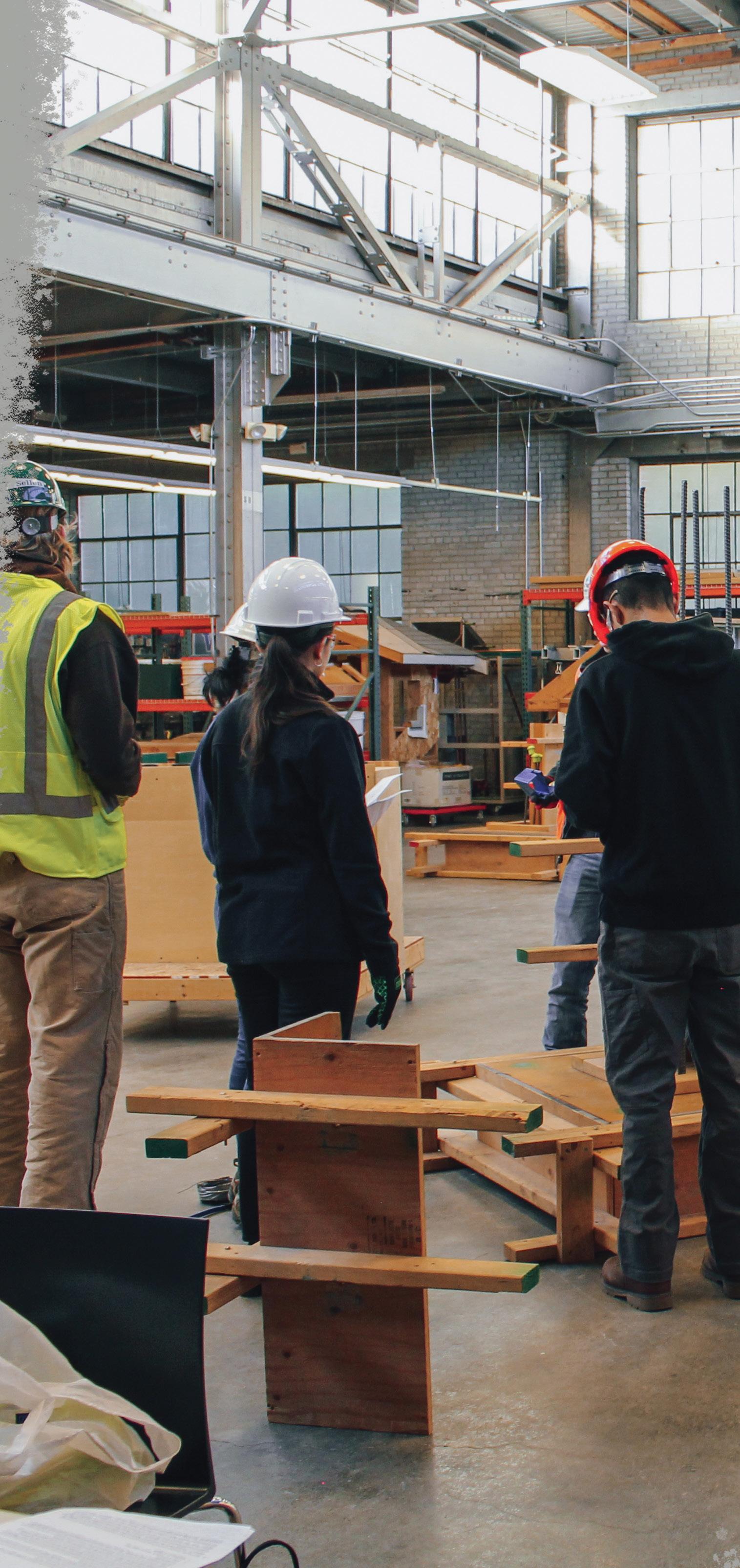
26 UW MAGAZINE
N
dolorat. To con ipicips untores soloreh enienim totatinus que et rempe quatate voluptate reet, sitiae
dolorat. To ipicips moluptati enienim agnihic et omnis quatate voluptate reet, parumque

At the Concrete Materials Lab, the outlook for the future of one of the world’s oldest materials is anything but gray
By Stacy Kendall
MIX MASTERS
Photos by Alex Blair
Right: �he goal of the UW Construction Methods and Concrete Materials Lab is to become a resource for the construction industry as a certified materials testing ground.
Below: Students try out new recipes for making concrete, such as replacing Portland cement with ground limestone. �hat could yield a product with excellent strength and a reduced carbon footprint.
where project samples from these and other departments can be brought to be tested, and then scaled up to real proportions within the hangar’s lofty heights. From undergraduate to doctoral students, this cross-college collaboration is another thing Aguayo appreciates about the work done in the lab. As one of the state of Washington’s only academic experts actively researching concrete materials and their durability, Aguayo has a unique specialty that allows students to see and participate in the future of the concrete construction industry.
Research into cement-based systems of infrastructure is good news for the estimated 4.1 billion tons of cement produced globally, mostly in China. Potential innovations in material durability, alternative and supplementary cement binders, recycled aggregates and high-performing concrete are the keys to improving environmental sustainability, safety and longevity.
Sustainability, notes Aguayo, is one of the things he sees as foremost on the minds of the students who come through the lab. As the Pacific Northwest continues to lead the pursuit of more environmentally responsible materials and methods, innovations in this area cannot come soon enough. Burning limestone to obtain lime, one of the main components of ubiquitous Portland cement, creates CO2, and the cement-making process has been attributed as one of the leading causes of human-made CO2, often cited as around 9% of its global production. While extending the lifespan of the sturdy stuff is one of the main solutions to cutting down on production, as well as discovering more effective outcomes of recycling it, alternative and more environmentally friendly cements are a central focus of Aguayo’s research into the next generation of concrete materials.
For example, using ground limestone to partially replace Portland cement can reduce its carbon footprint and be an effective strength-promoting filler. Known as Portland Limestone Cements, it is one of the current “hot” topics in the concrete industry, Aguayo says. An unintended (but positive) consequence of burning less coal than in previous decades is the reduced availability of coal fly ash, a byproduct of coal burning and one of the most used supplementary binders in making concrete. Completely alternative cementitious materials such as calcium sulfoaluminate (CSA) cement are beginning to gain attention for their remarkably fast strength-gaining properties, superior


28 UW MAGAZINE
I T'S N OT O N LY NEW CON STR UCTION T HAT COULD BE N EFI T THE MOST FROM I N N OVAT IO NS I N C ON C R ETE
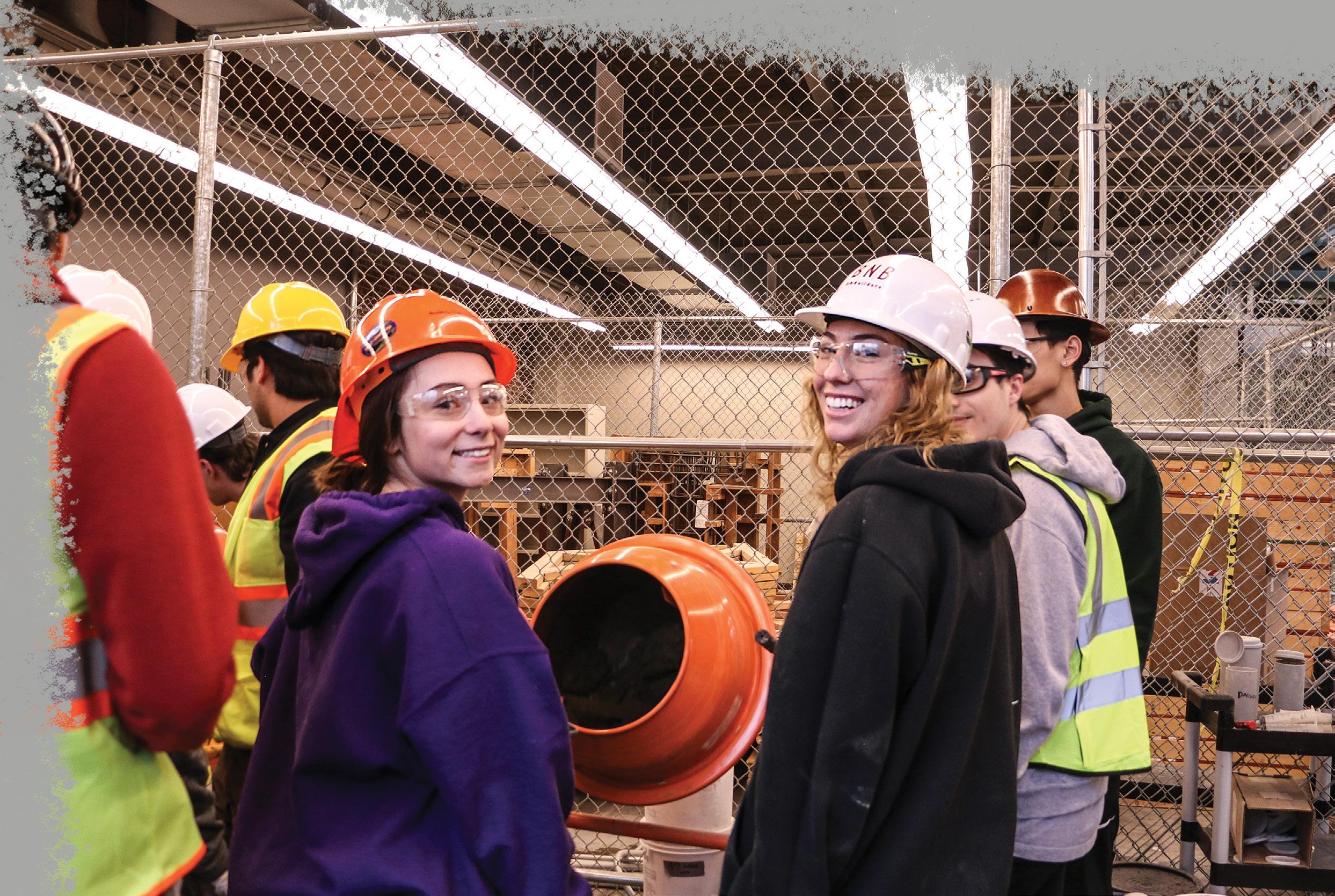
Above: It’s a great thing that students are getting hands-on experience making construction materials. Approximately 11,000 lane miles of roads in Washington state require repair.
durability and lower CO2 footprint than ordinary Portland cement and other infrastructure materials. Imagine the difference in construction timelines with concrete that cures faster, is just as durable (or more durable) and more environmentally friendly. “CSAs can develop most of their design strength in as little as three to four hours, for what would normally take days or weeks in traditional Portland cement binder,” says Aguayo. It’s these types of alternative or supplemental binders that represent a big opportunity in cement and concrete research and would be game-changing for the construction industry.
And innovations in concrete could benefit repairs even more in new construction. Infrastructure such as roads, bridges, utilities and dams are among the enduring repair challenges for cities and states. Seattleites’ daily confrontations with potholes and corroded concrete should spotlight the understanding of the shortcomings of this material as we know it. According to the Washington State Department of Transportation, about 11,000 lane miles of roads in the Evergreen State require repair. Part of the 2022 “Move Ahead Washington” infrastructure package ($3 billion over 16 years) will address numerous repairs and expansions. Longer-lasting concrete could mean fewer maintenance crises.
Meanwhile, the UW Construction Methods and Concrete Materials Lab continues to build on its importance. Giovanni Migliaccio, chair and professor of the Department of Construction Management and executive director of the UW Center for
Educational Research in Construction, predicts that in six to eight years, the lab can serve the construction industry as a certified testing ground, supporting so many of the local companies that already lend their expertise to the students in the form of the department’s advisory council. “We have nearly 40 companies and associations that support our mission through mentoring, internships and scholarships. They also support when classes need a site visit, guest lecturer, coaches for a competition or occasional special needs like software and equipment,” Migliaccio explains. The mix of research and real-life industry involvement has immeasurably increased the department’s and college’s profiles, and it’s only growing. To wit, Migliaccio says their programs have seen a substantial increase in both master’s student applications and undergraduate interest, especially among high school graduates who apply to the UW and list the major as their first or second choice.
The playfulness of undergraduate experiments, Aguayo reveals, is the lighter side of working with this heavyweight substance. One student, he recalls, used broken glass from a bottle as the “rock” in a mix of white concrete to make some coasters and concrete countertops. Not as a strength experiment, but to make it look cool. And it worked. Perhaps the next college to get in on the lab’s creation capabilities will be art.
Whether churning out decorative or cutting-edge alternative concretes, the CERC continues to evolve and grow. UW concrete is making a great case for being the foundation of the future.
SPRING 2024 29
Elevated Awareness
In his recently released memoir, alpinist and climate advocate Graham Zimmerman reflects on what he’s learned from two decades of climbing some of the world’s highest peaks
By Rachel Gallaher
Photos courtesy Graham Zimmerman

Mark Richey, a climbing partner of Graham Zimmerman, makes headway on Link Sar, which rises 23,100 feet in the Karakoram, which spans the borders of Pakistan, India and China.
30 UW MAGAZINE
Like many athletes in the mountaineering community, alpinist Graham Zimmerman knows what it’s like to face death. As someone who regularly puts himself in precarious positions tens of thousands of feet up steep, icy mountain faces, Zimmerman has always been aware of the dangers of his sport. He’s awakened up to the news of friends and colleagues losing their lives or suffering severe injuries. Despite a few close calls—a broken leg and shattered shoulder from an avalanche in New Zealand, falling into a tight crevasse in the Alaska wilderness—he has always made it home at the end of the day.
“It’s not guaranteed,” Zimmerman says over Zoom from his home in Bend, Oregon, where he lives with wife Shannon McDowell and their two Australian Labradoodles, Pebble and Iggy. “When you’re working with risk to life and limb, you have to be really careful. I’ve done a lot of work building models and methodologies for myself that allow me to go into [the mountains] and engage with that risk in a way that has a high likelihood of me coming home in one piece. I haven’t nailed it all the time—if you engage with enough risk, there will be times when it gets you. And that’s a frank reality for me as a climber and member of this community.”
Mountaineering, like many things, is a numbers game. You can be the most cautious, aware and skilled practitioner and still end up in situations full of unpredictability, from inclement weather to shifting topography. When climbing with a team, each person must trust the capabilities and knowledge of everyone else involved. Sometimes, when tragedy strikes or danger arises, it’s merely the act of being in the wrong place at the wrong time. Most of us who have never had a near-death experience cannot begin to comprehend what those moments are like.
According to Zimmerman, at least, it’s nothing like the movies. There’s no grand montage of one’s life, no thoughts of loved ones and no deep philosophical meditation. Instead, as he writes in his debut book, “A Fine Line: Searching for Balance Among Mountains” (released in October 2023 through local publisher Mountaineers Books), “It’s an odd thing to consider how you are going to react when you are about to die, but in that moment, I received my answer. It came in a long string of expletives as the

hidden snowbridge beneath me collapsed and I fell into a crevasse. The world slowed as I felt myself bouncing between the walls as I accelerated downward. One ski popped off as my knee twisted. I came to a quick stop, plugged into a constriction in the hole, the wind forced out of my lungs.”
Thankfully, Zimmerman’s climbing partner, Clint Helander, was able to locate him and, after an hour of constructing a complex pully system, help him out. But the remote wilderness where the men were climbing (the Revelation Mountains are at one end of the Alaska Range, about 130 miles southwest of Denali) and Zimmerman’s injured knee made for an arduous return to their base camp.
When asked why he keeps climbing despite the risk, Zimmerman—the director of Athlete Alliances at the Coloradobased nonprofit Protect Our Winters and the president of the American Alpine Club—looks away from his screen and pauses. “One of the things that I value most in life is learning,” he says. “When I think about the places in which I learn the most, they are places where I’m taking a strategic risk. When you have an accident or an injury, and you do the work to get out on the far side of it, then what do you do? Do you ignore it, move on and totally pivot your lifestyle—or do you look for hard lessons in the experience and register them in a way that makes you better moving forward? There isn’t a right or wrong choice, but in my life, it’s been pretty consistent that the lessons I get from the mountains make it worth going back for more.”
I reconnected with Zimmerman in 2011 when he was back in Seattle recovering from a climbing accident in New Zealand. We both attended Edmonds-Woodway High School in the early aughts and became friends before he went off to the University of Otago to study geography. (Born in New Zealand, Zimmerman is a dual citizen.) I still have memories of hanging out at Zimmerman’s house in high school, big groups of kids gathering in his parents’ basement to listen to Elliott Smith and Bob Dylan. What stands out most in my mind is the climbing wall that Zimmerman installed in his bedroom—the colorful handholds scaling up his wall and ceiling to indicate his budding passion.
“It’s funny,” he says, “usually, if you talk to someone who has
SPRING 2024 31

dedicated their life to a sport, they will tell a story about the first time they experienced it, immediately knowing that they had found their ‘thing.’ When we were in high school, and I first went climbing in the mountains, I remember being scared and tired and getting badly sunburned. I do not remember it being fun, and I do not remember being like, ‘This is my thing.’”
For Zimmerman, the draw to climbing was more complex, driven by a comfortable suburban teenage life in a safe community where you could practically leave your front door unlocked. “When I went to the mountains, I was challenged in a way I had never been before,” he reflects. “I also experienced a new level of agency with decision-making, which I found empowering.”
By the time Zimmerman was 18 and heading to New Zealand for college, climbing was the only thing he wanted to do. Like most industries at the time, mountaineering had a masculinity problem. As a culture, it appeared overrun with swaggering men competing to see who could climb the highest or on the most complicated routes—an allegiance to anything other than the mountains indicated weakness and was a waste of time. Zimmerman admits that his younger self got caught up in that mentality for a while, but part of his motivation for writing “A Fine Line” was to help change that adverse narrative.
“The body of climbing literature and core climbing stories still trend toward this macho, Nietzschean Ubermensch mentality,” he says. “I wanted to present a different perspective and show that to have a life in which climbing is a crucial part, but not everything, doesn’t make you a worse climber. Learning how to balance different elements such as relationships and advocacy gave me a foundation and the tools to try bigger and harder things and have
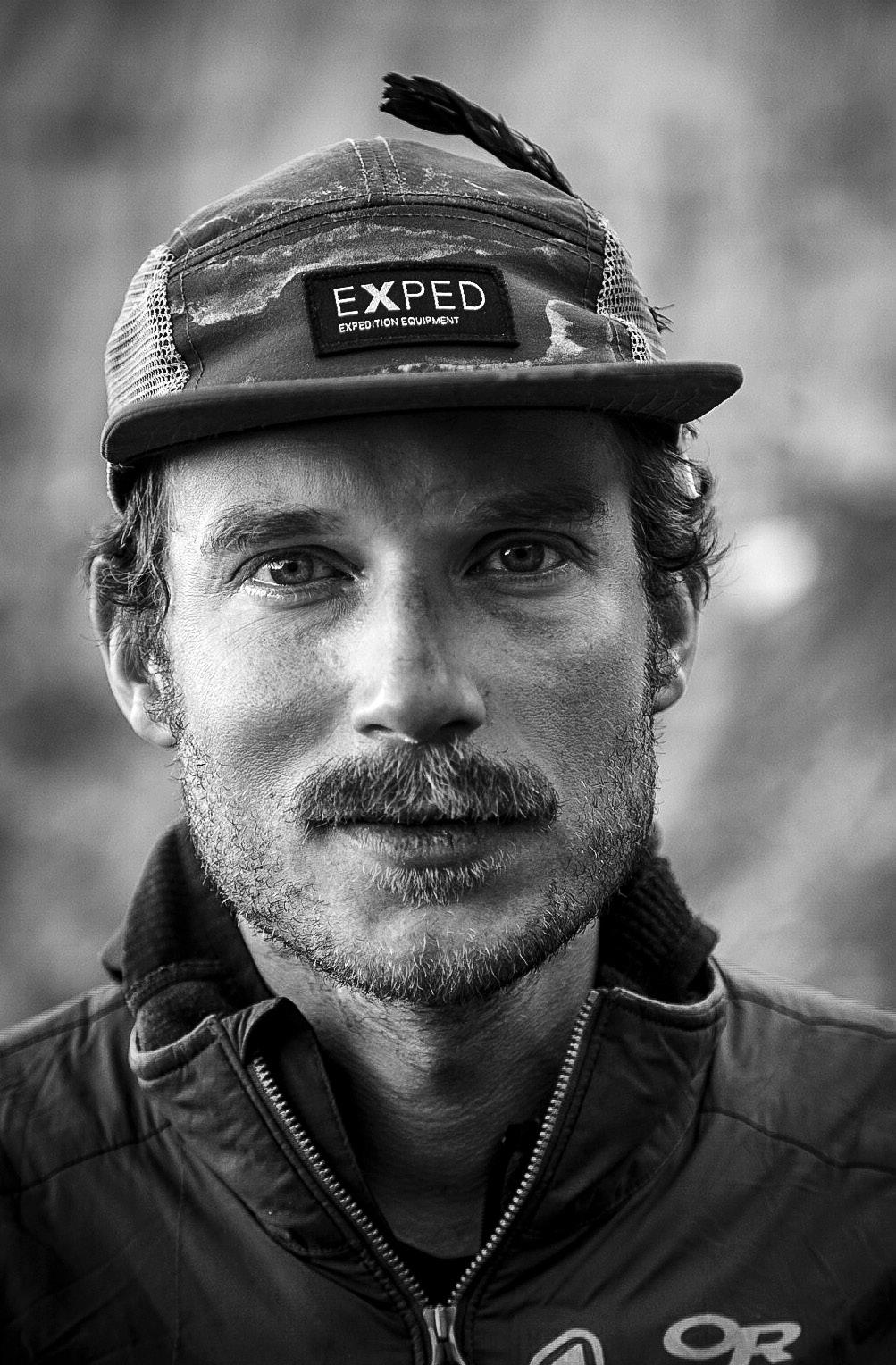
the outcomes of those objectives be even more profound.”
After graduating from Otago, Zimmerman returned to the U.S. and took up a peripatetic lifestyle that included the esteemed Yosemite Search and Rescue team, which specializes in rescues from the big walls of Yosemite National Park. He also worked for MWH Geo-Surveys, running gravitational surveys in Kenya, Eritrea, Ethiopia, Northern Canada and the Southwestern U.S. It was a lucrative job that allowed him to travel internationally and funded his climbing trips between assignments. Then, one day, he checked in on a project he’d worked on in Eritrea. Instead of providing economic and educational opportunities for local communities, the mine that had resulted from the mapping they did “had led to allegations of forced labor, slavery, and torture,” he writes. “No longer could I ignore the impact of the work I was doing in an extractive industry. It created stability for me in the form of a reliable income, but it was immoral and not sustainable for the world.”
Armed with this knowledge—and the growing realization that climate change was negatively and alarmingly impacting the environment—Zimmerman decided it was time to realign his values and actions. In 2019, he got involved with Protect Our Winters, a nonprofit organization in Boulder, Colorado, that focuses on law reform for environmental issues. He also started leveraging content from his climbs to bring awareness to the human impact on the planet. Zimmerman has participated in the production of more than a dozen films for clients such as REI and Outdoor Research.
“I didn’t get into policy or advocacy sooner because of a perceived hypocrisy around my carbon footprint,” Zimmerman
32 UW MAGAZINE
Above left: Zimmerman is breaking ground using the knowledge gained from more than 40 expeditions and assignments around the world to help deal with climate change.
Above right: A keen observer, Zimmerman used the skills he learned from a UW storytelling program to write his first book.
admits. “I felt like I was a big part of the problem. Now, I see myself as an imperfect advocate. I am using my platform as a professional athlete and community leader to pressure politicians into hopefully driving systemic climate-solution changes. In my role at Protect Our Winters, I empower other professional athletes to do the same.”
A leader in every sense of the word, Zimmerman stands out in the climbing community for his openness, emotional maturity, levelheadedness and ability to inspire others. A dedicated team player, he talks about strength in numbers, admitting when he doesn’t know something, and the importance of bringing people onto a team who can fill in those knowledge and skill gaps. “You can make a stronger team that way and accomplish more in the long run,” he says.
“A lot of people attracted to the mountains are misfits,” says mountaineer and author Steve Swenson, ’77, who, in addition to summiting Mount Everest and K2 (the two tallest mountains on Earth) without supplemental oxygen, is known for his climbing expeditions to the Karakoram, a range in the Kashmir region that spans the borders of Pakistan, China and India. Swenson has climbed with Zimmerman a handful of times, including the first summit of Pakistan’s 23,100-foot Link Sar with fellow climbers Mark Richey and Chris Wright. For their efforts, the team was awarded a 2020 Piolet d’Or Award—the highest honor in alpine climbing. “A lot of climbers are awkward, and it’s hard for them to know how to fit into a crowd or take on a leadership position. Graham is unique in that regard. He is much more emotional and apt to express gratitude and appreciation. What impressed me about Graham on our first trip to Pakistan was his willingness to be open and learn,” Swenson says.
In the past two decades of his climbing career—in which he has participated in expeditions in locations including Pakistan, Kyrgyzstan, Alaska, Argentina and New Zealand—Zimmerman has become one of the most acclaimed alpinists of his generation. Like Swenson, his focus is “big mountains” that are technically challenging. He avoids fixed-rope routes, opting to bring what he can carry on his back and climb with only a length of rope tied between two climbers. First ascents are a Zimmerman specialty—he has more than a dozen under his belt. “I’m working on this personal goal of opening one new route each year,” he says. “That’s not always a big mountain. I’m also trying to open routes accessible to the broader community.” In 2022, Zimmerman and fellow climber Ian Nicholson worked on establishing Washington’s Edge of Time Arete, a 650-foot alpine rock climb near Snoqualmie Pass.
Like Swenson, mountaineer and photographer Kaj Bune, who works in the marketing department at EXPED, a Swiss outdoor gear retailer, has known Zimmerman for years. A friend of Zimmerman’s father, who played Ultimate Frisbee with him in Seattle in the 1970s, Bune met his friend’s son when he gave a talk to Zimmerman’s high school mountaineering club. The two have since climbed together in Washington state, and Zimmerman counts Bune as a career mentor.
“Graham has an abundance mentality,” Bune says. “He understands and acts upon the idea that you can give someone else credit, compliment them, or recognize that they have contributed to your achievements, and it doesn’t take away from your success. Graham is always listening and taking in things from everyone he encounters. That’s one of the keys to his ability to be a leader.”
Examples of this are laid out over and over again in “A Fine Line.” Zimmerman recognizes the power of storytelling and uses his voice—authoritative, funny and sharp—to craft a beautifully self-aware memoir exploring his evolution from a couch-surfing climbing obsessive into an emotionally engaged husband embracing balance to achieve a more fulfilling life. In 2020, Zimmerman enrolled in a yearlong course at the University of
Washington, earning a certificate in Storytelling and Content Strategy, which he credits with helping him to write his book and to better approach marketing for the climbing organizations he’s involved with.
“If you look at how people were getting to the conversation about climate change in the late ’80s through the early aughts, there was this approach if we hit communities with enough facts, they will eventually come around,” Zimmerman says. “But people ultimately hit this threshold of facts and will stop listening. We’re trying to move away from that and leverage stories from within communities in order to create common ground. The age-old tradition of storytelling—think about gathering around the campfire for thousands of years—is really powerful.”
On or off the mountain, Zimmerman cuts an inspiring figure. His humble attitude underscores the power of leaning into self-reflection and ultimately learning to love deeply and vulnerably. In the book, he lays bare the story of meeting his wife, the courtship that followed and his eventual dropping of the mental and emotional barriers that often keep people at a distance. Through shared elite-level athleticism (Zimmerman’s wife is a two-time world champion Ultimate Frisbee player), the two found a unique common ground where they support and understand each other. But the love doesn’t stop there. Zimmerman demonstrates what it’s like to walk through the world with openness and curiosity—to embrace every day with enthusiasm and hope for the future.
“Graham uses the word love regularly,” Bune says. “Not just in the book, but in everyday life, he is willing to talk about big mountaineering and love in the same sentence, and that’s a pretty rare thing. Anyone invested in these activities for a long time is feeling that emotion, but Graham is willing to say it out loud again and again. Love—that’s the reason why any of us are out here doing this in the first place.”
Zimmerman performs yoga in the rain while on an expedition in the Karakoram.
In recent years, Zimmerman has chosen to reevaluate the length and types of climbing trips he undertakes (a 2021 attempt to summit the rarely climbed, challenging West Ridge of K2 was abandoned when he and his climbing partner encountered uncharacteristically warm temperatures), a decision he sees as a marker of maturity and growth rather than weakness or failure. “It’s getting harder to justify trips like that K2 climb,” he says. “I’ve seen a lot of loss in my career. We need to make sure we are bringing the folks we lost along with us by celebrating and remembering them and locking their stories into our core ethos for many years to come. I hope my book serves as a reminder of all the remarkable things they’ve done.”

SPRING 2024 33
Civic and Civil
Husky
Civic Saturdays seek to bring people together to explore moral questions that concern all of us
BY CAITLIN KLASK
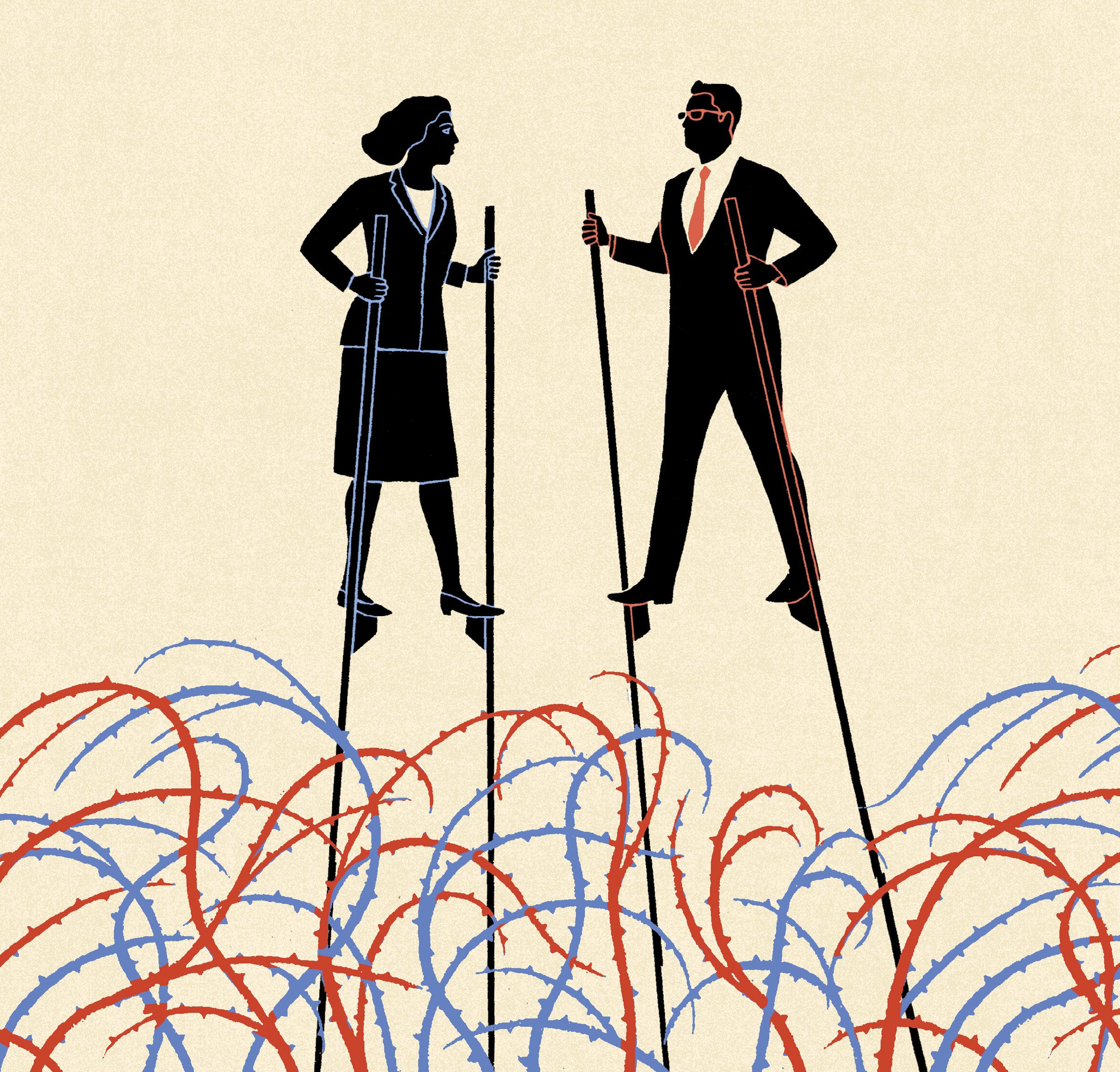 JAMES STEINBERG
JAMES STEINBERG
We have a strange storm brewing in the United States. Civil unrest and political disagreements dominate social-media feeds and news broadcasts. The Surgeon General declared an epidemic of loneliness and isolation in 2023, stating that a lack of social connection can increase the risk for premature death as much as smoking 15 cigarettes per day.
Even before the COVID-19 pandemic upended everything in early 2020, weekly church services reported a dramatic drop in attendance, down from 137 in 2000 to a median of 65 two decades later, according to NPR. Many of us who grew up attending church services simply stopped going as we aged. Today, many of us work from home, or struggle to connect as individualism becomes society’s norm.
But a solution is in the works for Husky alumni: Citizen University and UW Impact are working together to present Husky Civic Saturdays, a civic analog to a faith gathering, hosted by Huskies. Eleven UW alumni trained in community-gathering methods this past fall have gone back to their communities across the country to find out if a gathering grounded in ritual—like a church service, but not based in faith—would bring people together.
“It’s a gathering that shows it’s really possible to come together to build bridges,” says Citizen University Program Director Talya Gillman, ’08. “Not through dialogue or debate about contentious topics, but to transcend that and explore moral questions that concern all of us. … like, what are the dreams you have for what things could be like [in our community]?”
Citizen University, a Seattle-based nonprofit that is dedicated to building civic connection and a culture of powerful, responsible civic awareness across America, created Civic Saturdays in 2016 after the U.S. presidential election. Co-founder and CEO Eric Liu, an author who worked in both the Clinton and Obama presidential administrations, designed Civic Saturdays alongside his wife, Jená Cane, as an antidote to feelings of confusion and being overwhelmed. They started small, hosting local gatherings in Seattle, and realized there was an appetite to scale up. “Over time, people started asking, ‘Can you teach us how to do this? We know Eric can’t come everywhere all the time,’” says Gillman, who oversees the Civic Saturday Fellowship program. “And that’s how the fellowship was born.”
Civic Saturday gatherings operate much like a religious service: Singing opens the gathering, followed by a civic scripture (sharing speeches, newspaper clippings or poetry), civic sermons, breakout groups, more singing, announcements and often breaking bread together. “We’re trying to ignite a new kind of civic ritual that people can look forward to, that they can come back to over and over again to feel energized, activated, fortified, celebrated,” says Gillman.
While the hopes are grand, the challenges are formidable. “We are living in an era where trying to encourage constructive political debate is extremely challenging,” says Chris Olsen-Philips, ’17, associate director of UW Impact, the legislative advocacy program of the UW Alumni Association. “Almost any source of information you look at says that the divide is growing, and it’s hindering democracy.” Instead, Civic Saturdays encourage participants to start locally: Energize your neighbors, then scale up.
By partnering with Citizen University on Husky Civic Saturdays, UW Impact hopes to make alumni more comfortable participating in the democratic process. “Part of going through
the higher-education experience, we hope, is being a contributing member of whatever society you’re in,” says UW Impact director Courtney Acitelli, ’08.
Danny Williams, ’99, had already been thinking about giving back to the Tacoma community when he heard about Husky Civic Saturdays. But one day as he drove around the city not long after attending his training session, someone shot a bullet through his car. He (and his dog in the back seat) escaped injury, and the incident inspired him to ask even more questions. “How can we be more engaged? What can we do to be better neighbors, and then maybe effectively make change?” he wonders. “I’m concerned about what’s going on in Tacoma.
“The purpose is to be a better global citizen, acting locally,” says Williams, a UW Tacoma grad, small-business owner and longtime Tacoma resident. “But I’m not going to tell you how to be a better citizen. I want to reinvigorate and engage people in what citizenship is.”
Gillman stresses that the Civic Saturday model is not about engaging in political arguments or talking through differences. “It’s really important to come together in ways that remind us of what we do have in common,” says Gillman. And what could be a better shared interest than attending the UW?
Jasmine Ames, ’14, decided to apply for the program to show some love for her alma mater, but also for her hometown of Vancouver. She’s a vice president relationship manager at U.S. Bank in Portland, serves on several boards and is working on a Doctor of Law and Public Policy degree, so making time in her schedule is no easy task. She hosted her first gathering in Portland in December. While UW Impact offers promotional support, she sometimes finds the logistics of planning events (while juggling
It’s a gathering that shows it’s really possible to come together to build bridges
law school and a full-time job) cumbersome. Among the things on her mind: will the churchlike similarities exclude Vancouver community members who have had unfavorable experiences with religion? Still, she’s excited to meet with her community and discuss issues and positive impact in a nonpartisan way. The next step: scale up.
“I think it would take a lot more than me. I think it would take a network of civic fellows to really roll up their sleeves and engage the broader community,” says Ames, who created a Civic Saturday Instagram account to attract a wider audience. “Once people start understanding what it is, why our society needs it so much, then everything else will follow suit.”
UW Impact’s Olsen-Philips, who has been through the Civic Saturday Fellowship training, is optimistic about both personal development for participants and the potential for change in the community. “Voices are feeling disenfranchised, and we need to find a way to invite everyone back in,” he says. “This is bringing people together, bridging divides, where everyone feels welcome and included.”
SPRING 2024 35
NEWS FROM THE UW COMMUNITY

Cinema Steward
Former KEXP leader Tom Mara turns his focus to film
By Shin Yu Pai
After many decades in radio, �om Mara has become the executive director of the Seattle International Film Festival. “Seattle is a great film town,” he says, “that needs to become a greater film town.”
Remembering his first day as executive director of the Seattle International Film Festival last year, Tom Mara, ’88, jokes that he was greeted by colleagues, shown his office and promptly asked what he planned to do about Seattle Cinerama Theatre.
The beloved Belltown landmark was shuttered in 2020. But thanks to Mara, the SIFF team and supporters from the community, it reopened in December as the SIFF Cinema Downtown.
At first, Mara was cautiously excited about SIFF taking on a large-scale initiative to add another theater building to its portfolio so early in his tenure. Local arts organizations were still struggling in the wake of the COVID-19 pandemic. And acquiring the 1963 landmark was one thing, but could it
be operated with existing resources?
Mara reached out to various elected officials for help. Former Seattle City Councilmember Andrew Lewis mobilized city support for the initiative, joining other public and private donors who provided nearly $2 million toward the project. “The people I asked to support this journey understood the significance and quickly engaged in support,” says Mara. “It was a lovely experience, witnessing our city and county come together.”
SIFF Cinema Downtown is one of a few remaining theaters in the world with Cinerama technology. Mara describes the building as a “cathedral of cinema” and credits late Microsoft co-founder Paul Allen with saving the theater and investing in
the unique Cinerama technology that projected films like “It’s a Mad, Mad, Mad, Mad World” and “How the West Was Won” onto a curved screen using three synchronized projectors. The technology represents an important chapter in film history.
Although he’s known for his deep connection to music and for running the KEXP nonprofit radio station for decades, Mara’s deep passion for cinema stems back to his youth and weekly movie outings with his father. When he was 16, his dad took him to see Martin Scorsese’s “Raging Bull,” a violent tale about a prizefighter that is now considered one of the greatest movies
His first gig was volunteering at student-run KCMU
ever made. Later, as a UW student, Mara enrolled in a class on Scandinavian film that offered him his first serious encounter with cinema. Viewing Ingmar Bergman’s “The Seventh Seal” and “Wild Strawberries,” he began to understand how influential and profound movies can be.
While at the UW, Mara studied broadcast journalism, which pointed him toward work in public radio. His first gig was volunteering at the UW’s student-run station KCMU, launching his career in alternative radio. “If I hadn’t gone to UW, there’s a good chance that those 34 years at KEXP wouldn’t have come about,” Mara says. “I’ll always be grateful to UW for pointing me toward this enriching life.”
Mara sees similarities in his mission at SIFF to his work with KEXP. “A life enriched with music is a better life,” says Mara. “A life enriched by film is a better life.” SIFF serves film lovers, while also serving emerging filmmakers through its work in education and advocacy. On another level, SIFF contributes to the state’s ecosystem for film while also promoting civic responsibility and playing a critical role in helping to revitalize downtown Seattle.
“What people need to understand is that Seattle is a great film town that needs to become a greater film town,” Mara says, pointing to a number of other local film festivals. “Ultimately, our job is to scour the earth for films that deserve to be seen and get them in front of people.”
36 UW MAGAZINE
MATT HAGEN
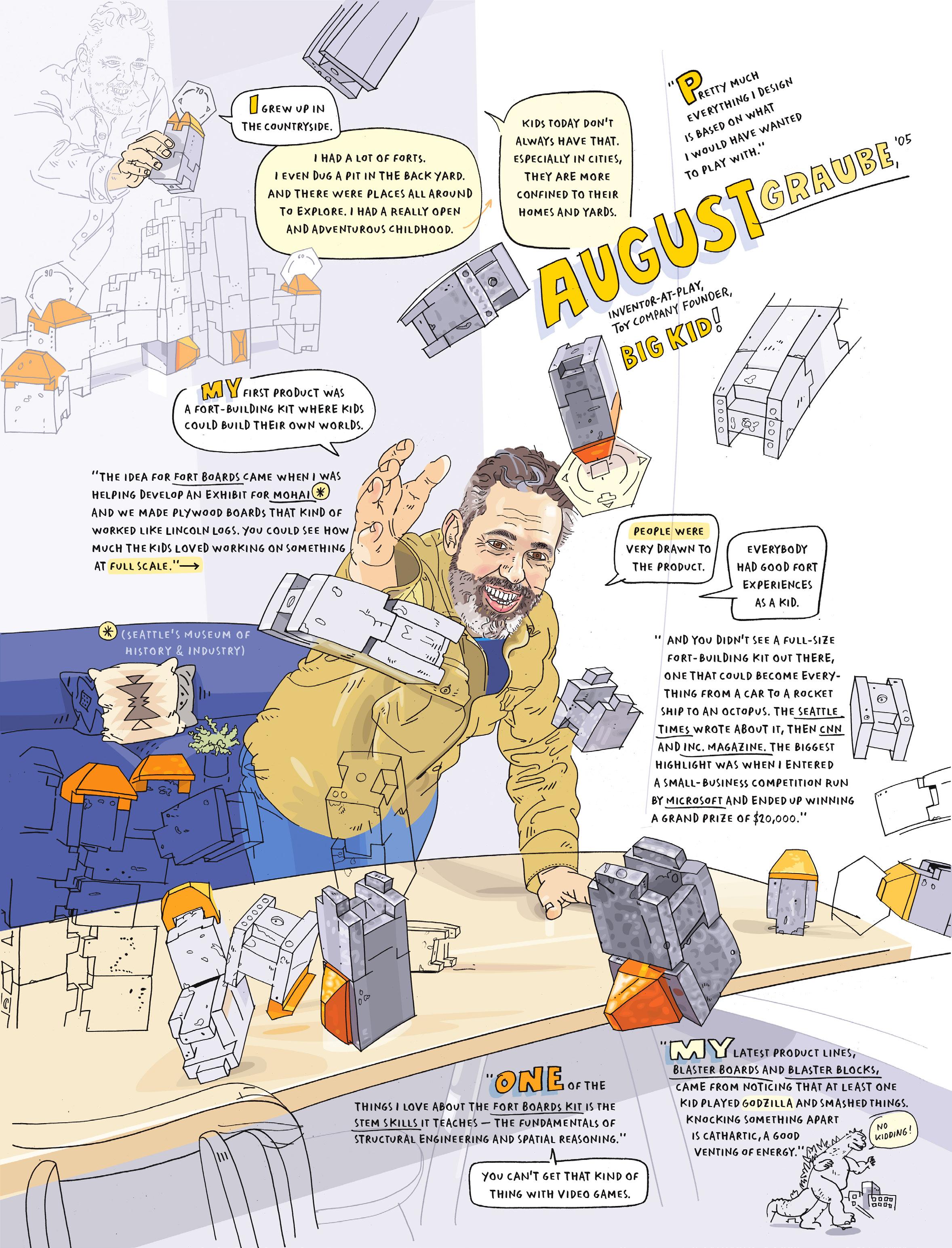
SKETCHES TOY TITAN
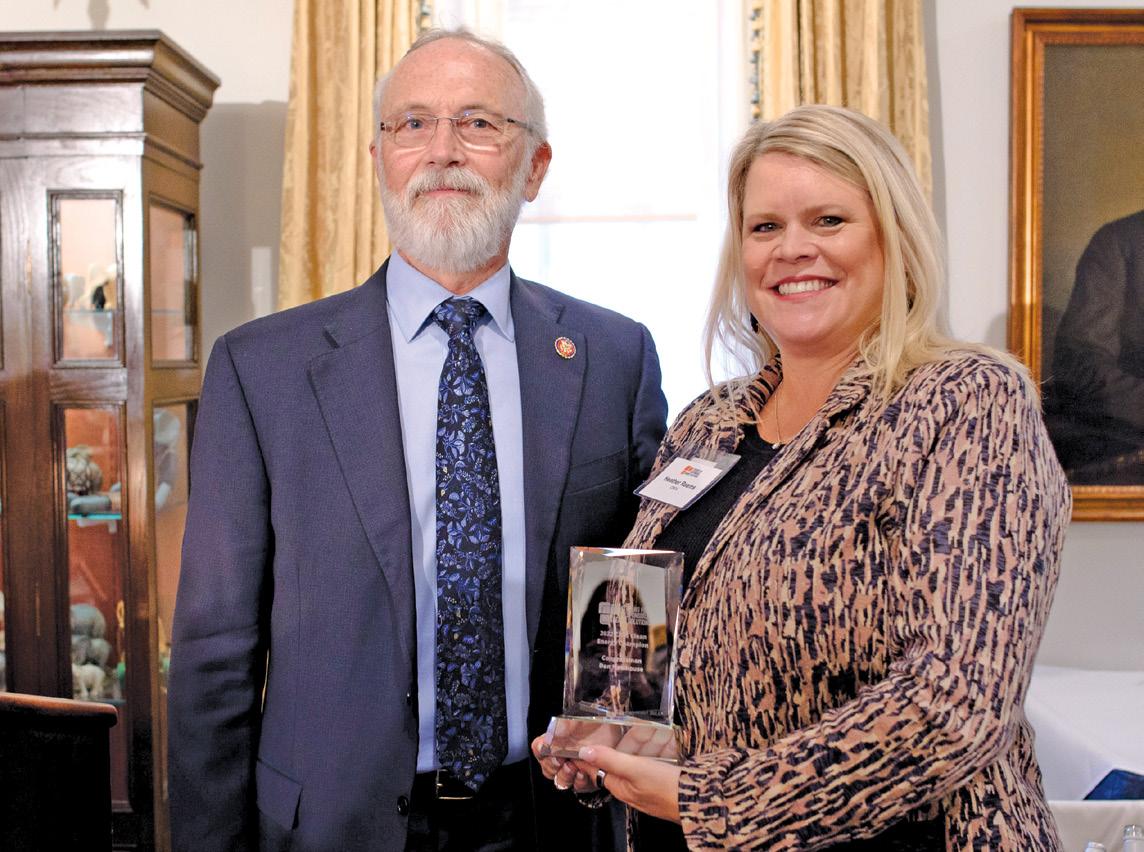
The Energy of Heather Reams
She champions the GOP perspective on clean energy
By Eric Butterman
Heather Reams never forgot the wondrous views of the outdoors from her University of Washington days. As the president of Citizens for Responsible Energy Solutions (CRES), Reams hopes, in part, to protect the country’s beauty by leading this rightof-center nonprofit organization based in Washington, D.C.
“We engage policymakers and the public about responsible, conservative solutions to address our nation’s energy, economic and environmental security while increasing America’s competitive edge,” says Reams, ’95.
The organization, founded in 2016, advocates for clean energy and discusses climate change from a Republican standpoint.
“It (the politics of climate change) tends to be focused generally on the conversations on the left-of-center aisle,” Reams says. “My job and my team, my organization’s job, is to heighten the awareness of how clean energy can help lower emissions that contribute to climate change.”
Seeing an evolution of climate change in Republican circles, Reams says she learned about interacting with the Democratic side from her days as a political science major at the University of Washington, where she felt like she was in the minority as a conservative.
Among her audience today are Repub-
lican members of the U.S. House and U.S. Senate. This has her working with everyone from Rep. Cathy McMorris Rogers from Eastern Washington to the Congressional Western Caucus chaired by Rep. Dan Newhouse. Reams’ job is to educate congressional staff members on areas such as global emissions but also to travel out of Washington, D.C. to speak at conferences and pass along the Republican view on clean energy.
It comes together in an annual celebrated event Reams has led since its beginning, National Clean Energy Week, a forum typically held in September that brings together both sides of the aisle in panel discussions.
CRES is the lead convener of the event, which, last year had more than 20 members of the House and Senate, Reams says, including members from the Biden administration and the Department of Energy, along with more than 50 business leaders.
“I love the fact that we can bring people together that are very passionate about leaving our world better than we found it.”
Part of Reams’ foundation for working with government came from interning for then-U.S. Sen. Slade Gorton, her first experience dealing with politics and policymaking at the federal level. That inspired her to think again about her plan for law school and eventually to move to Washington, D.C.
Reams credits her UW adviser, political science professor John T.S. Keeler, who took the time to understand her conservative point of view and helped her navigate the world. Add her geopolitics education and it’s easy to see why she is such an enthusiastic graduate.
She proudly says: “I draw on my time at U-Dub extensively.”

Opening March 8, 2024. Become an advocate today Higher Education Needs Your Voice UWimpact.org A program of the UW Alumni Association ADVOCATE 38 UW MAGAZINE
Heather Reams, president of Citizens for Responsible Energy Solutions, presents Rep. Dan Newhouse (R-Washington) as a Clean Energy Champion during National Clean Energy Week in September 2022.
CITIZENS FOR RESPONSIBLE ENERGY SOLUTIONS
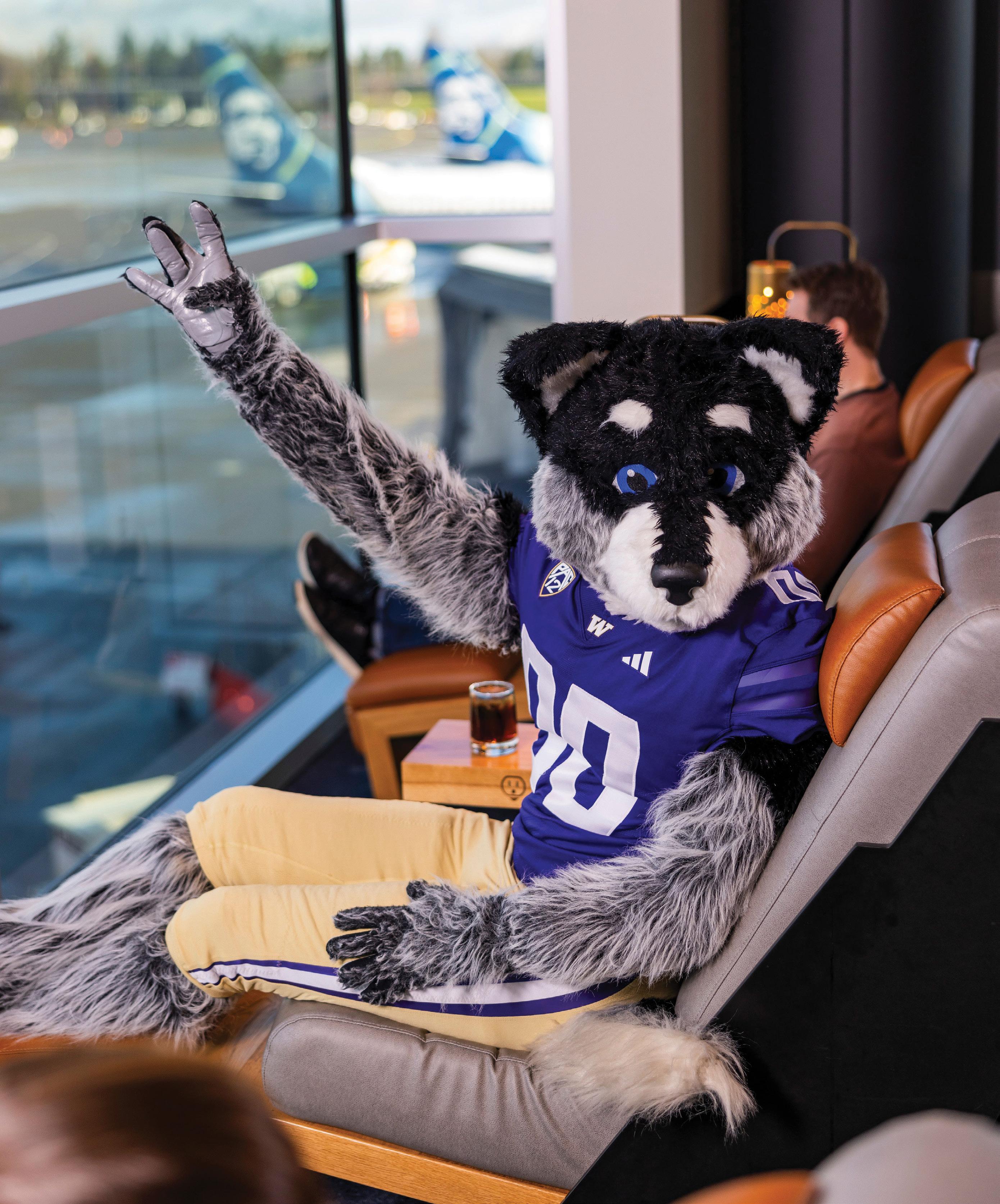
Proud to be the official airline of the University of Washington.
Bending Genres, Breaking Rules
E.J. Koh’s debut novel affirms her place among powerful American storytellers
By Shin Yu Pai

Just months after finishing her doctoral dissertation at the UW, author E.J. Koh, ’23, was traveling the country to promote her new novel.
E.J. Koh spent last November launching “The Liberators,” her debut novel. The tale, which centers on generations of a South Korean family, is getting glowing reviews and has drawn attention from the likes of the Los Angeles Times, NPR and PBS. Published in the wake of her completing a Ph.D. and winning a coveted National Endowment for the Arts fellowship, the book is yet another sign of Koh’s rising literary star.
When she arrived in Seattle from New
York in 2013, Koh knew she wanted to settle in for a while. She had made the move to reunite with her parents, who had relocated from South Korea, but she was also drawn to study at the UW.
When she joined the UW community in 2017, she had already completed an MFA at Columbia University and published an award-winning collection of poetry. The UW’s Ph.D. program in English would offer an environment where she could do rigorous research and express her schol-
40 UW MAGAZINE
COURTESY E.J. KOH
arship and storytelling in creative ways.
Koh worked with Professor Shawn Wong, who is considered a godfather of Asian American literature for his work as a writer, editor, publisher and literary activist. Wong encouraged Koh to explore a hybrid approach to her dissertation—engaging her creative intellect and multiple talents. Her final body of work included a dazzling range of translation, memoir, poetry, photography and visual art.
“She’s amazing,” Wong says of his student. “She turned in her dissertation, ‘American Han,’ and a week later sent me a draft of her novel to read, making all of us feel like we’re the laziest writers in the world.”
Though he supervised Koh’s dissertation, Wong says he doesn’t consider himself her teacher. “I was learning the
Koh once thought that the different genres—like poetry, translation or memoir—were separate rooms that she entered and left
theoretical territory along with her,” he says. “I was certainly not leading. Rather, I asked a lot of questions, and I think those questions helped both of us shape her novel and dissertation.”
Impressed by Koh’s genre-bending work, Wong nominated her for a Graduate Medal in the Humanities from the College of Arts & Sciences. “This is new research and completely original scholarly territory,” he wrote.
During her time as a UW graduate student, Koh published a critically acclaimed memoir, completed her novel and worked as a writer adapting the best-selling novel by Min Jin Lee, “Pachinko,” for an Apple TV+ series. “These works, combined with her dissertation, demonstrate a writer, artist and scholar able to work across genres and connect with readers on so many levels,” says Wong. “In my 39 years here at the UW, I’ve never encountered a Ph.D. student like E.J., or, for that matter, any student like her.”
Koh also worked closely with professors Brian Reed, Jang Wook Huh and Leilani Nishime. Reed helped Koh recognize the
connection between her creative work and the rich canon of Korean American and Asian American literature that came before. “This is part of academia that I want more creative writers to embrace,” says Koh. “To understand that we come from a lineage, where all of our stories do something together. We are not alone.” Koh’s ability to discuss Asian American literature and trace a direct connection to her own creative production allows her to raise new questions and perspectives on racial grief as it illuminates the complexity of human experience. She can move beyond the simplistic narratives of survival and hope.
The idea for “The Liberators,” a multigenerational family saga of memory, trauma and empathy, came while she researched her nonfiction memoir, “The Magical Language of Others.” That collection of personal essays and translations looks, in part, at the history of the Jeju Island Massacre as it connected with the more personal history of Koh’s family. This background research also converged with study that she was doing to prepare for work on the TV series. “The Liberators” came out of ideas sparked by “Pachinko,” things that she hadn’t gotten to write about.
Koh says her dissertation and research were efforts that she would have been making anyway to write her novel. “The novel wrote itself in a way,” she explains. “Every time I worked on a chapter or found a dozen books to add to my reading list, it only furthered another idea, chapter, character. They weren’t in opposition. They were tightly wound together.”
Koh once thought that the different genres—like poetry, translation or memoir—were separate rooms that she entered and left. Now she sees less and less of a separation. “When I was working on the novel, there was never a time when I read so many poetry books and poems. That really helped me come around to the language and the way that I wanted to write the novel,” she says. Likewise, when Koh worked on her memoir, she read mainly fiction. It allowed her to imagine the histories that she wanted to talk about.
While “The Liberators” was just released last fall, Koh is already focused on her next book—a hybrid collection to keep pushing the boundaries of genre.
She also continues hand-writing love letters to strangers who send her emails, a project she started in 2016. She plans to write 1,000 letters and has completed 600 so far. Anyone who would like to receive a letter can find more information on her website at www.ejkoh.com.
MEDIA
PODCAST

Ways of Knowing
By faculty from the College of Arts & Sciences
In this eight-episode podcast, UW faculty explore race, immigration, history, the natural world, even comic books. “Ways of Knowing” is a collaboration between the The World According to Sound and the University of Washington.
BOOKS

Treaty Justice: The Northwest Tribes, the Boldt Decision, and the Recognition of Fishing Rights
By Charles Wilkinson
UW Press, January 2024
In 1974, Judge George Boldt issued a ruling that affirmed the fishing rights and tribal sovereignty of Native nations in Washington state. The Boldt Decision transformed Indigenous law and resource management across the United States.
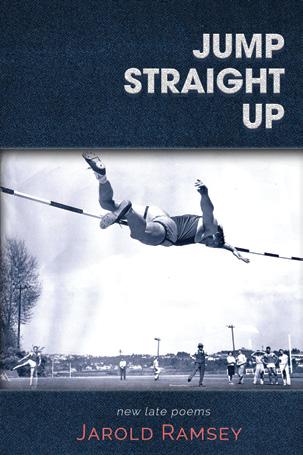
Jump Straight Up
By
Jarold W. Ramsey, ’66
The Poetry Box, November 2023
This collection of poems covers a variety of themes: encroaching age overtaking a long, wonderful marriage; the delights of grandparenthood; awareness of our “interspecies” situation in the everyday natural order and the blessings and challenges of Central Oregon’s canyons, summits and rangelands. Ramsey grew up on a ranch north of Madras, Oregon.
TV SHOW

Archie
By writer and executive producer Dyan Cannon
BritBox
This new series is about the life of Hollywood icon Cary Grant, based on the New York Times best-selling memoir Cannon wrote about her four-year marriage to Grant. Cannon, who attended the UW for 2½ years, is a threetime Academy Award nominee.
SPRING 2024 41
Europe Beckons with Trips to Ireland, Greece, Italy and Normandy
�here’s still time to book your travel for 2024! UW Alumni �ours offers a variety exciting trips the rest of the year. Act quickly so you can book the tour of a lifetime. And remember: You don’t have to be a UW graduate to travel with UW Alumni �ours!
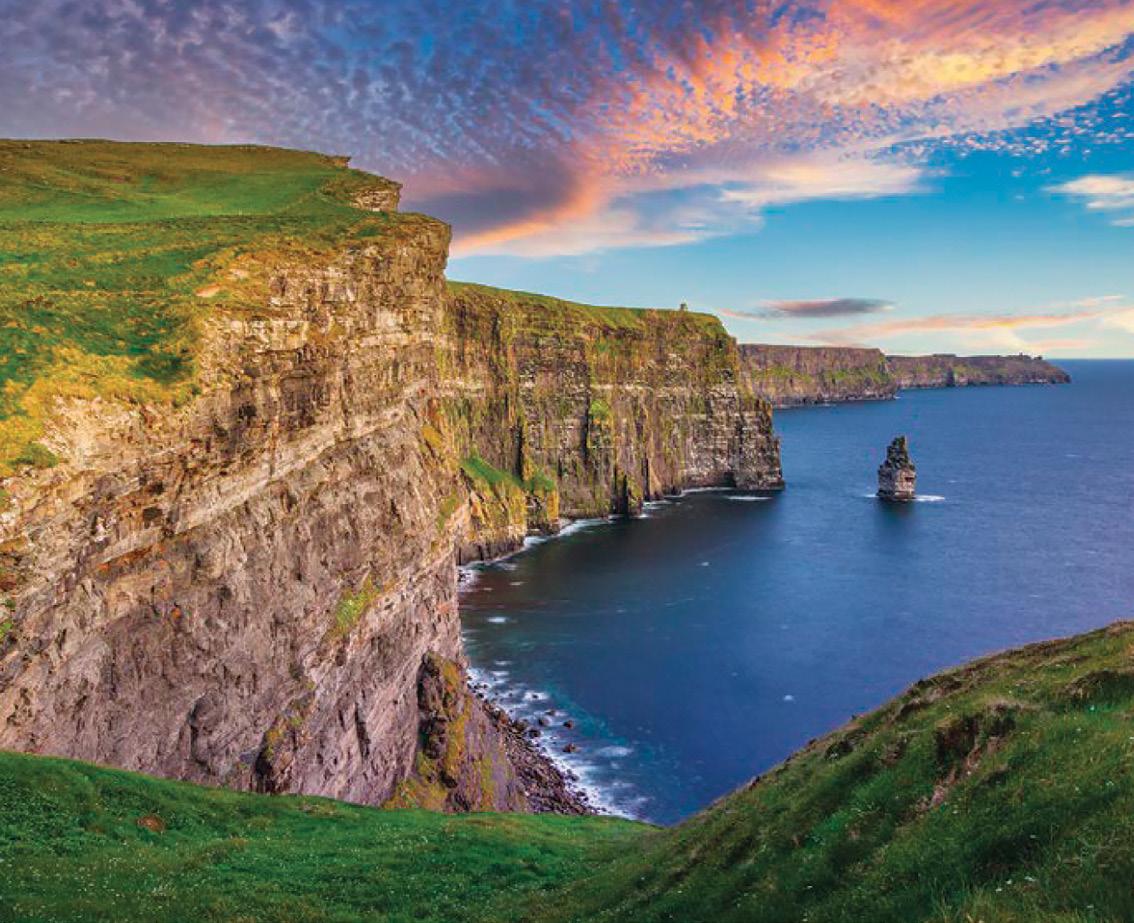
Coastal Gems of the Emerald Isle
September 1-13, 2024
Tour operator: AHI Travel
Ireland’s dazzling coastal beauty takes center stage on this magical, 11-night journey! Explore the Wild Atlantic Way, beginning with the breathtaking Cliffs of Moher and the fossil-laden limestone terrain of the Burren. Ferry to the starkly beautiful Aran Island of Inishmore and take in Achill Island’s moors and mountains. Amid Connemara’s glacier-carved landscape, watch lively dogs herding sheep on a family farm. Next, venture north on a less explored route to the hidden gem, County Donegal. Be awed by spectacular Slieve League, Ireland’s highest sea cliffs. From there, travel into Northern Ireland to discover the vibrant walled city of Derry-Londonderry.

Classic Greece & Italy
October 19-30, 2024
Tour operator: GoNext
On this 10-night voyage from Athens to Rome aboard Oceania Cruises’ Vista, you’ll explore the charming coastal town of Gythion, bask in the Mediterranean sun at a beach in Argostoli and stroll the lovely old Venetian quarter in Corfu. In Dubrovnik, you can hike to the towering fortress in Kotor. In Valletta, see the celebrated St. John’s Co-Cathedral. Before concluding your journey in Rome, walk through the ancient ruins of Herculaneum, a city near Salerno that was preserved by a volcanic eruption of the first century.

Normandy: D-Day 80th Anniversary
October 26-November 3, 2024
Tour operator: AHI Travel
Check out these highlighted trips and plenty more at Washington.edu/alumni/travel.
From Normandy’s sweeping, cliff-lined coast to its rolling countryside, discover proud traditions, dramatic history, culinary delicacies and alluring beauty on this fascinating, seven-night exploration. And as the world marks the 80th anniversary of D-Day, spend two full days visiting Omaha and Utah beaches, the Normandy American Cemetery and other sites associated with this pivotal World War II operation. Admire some of France’s greatest treasures, including magnificent Mont-Saint-Michel and the finely stitched Bayeux Tapestry. Savor flavorful local wines and a lunch at a stately, 10th-century castle, and sample Normandy’s acclaimed Calvados apple brandy on an estate.
42 UW MAGAZINE
Join the Fun: Events and Social Activities for UWAA Members
Invitation-only shopping nights, events and more! These are just a few of the benefits that UWAA members receive year round. Recently, members were treated to a shopping night at University Book Store with special discounts and offers, a Winter Solstice Walk through the Washington Park Arboretum, movie screenings of “The Boys in the Boat,” a mocktail demonstration at Life on Mars and special pricing for ice and roller skating nights.
Upcoming events include Husky Socials at Boon Boona Coffee in Renton and the College Inn Pub, MOHAI Museum Day and a special pre-lecture reception with comedian and actress Margaret Cho. Join the party with your fellow Huskies and become a member today!
uwalum.com/membership


HUSKY FOR LIFE
60,000 strong, UWAA members believe in the profound and global impact of the UW. We believe in our community, and in our students. Share your passion with us.

SPRING 2024 43 JOIN THE PACK UWALUM.COM/JOINUWAA
NEWS FROM THE UWAA
UWAA members raise a glass during a private mocktail event at Husky-owned Life on Mars on Capitol Hill.
Harry the Husky joins UWAA members and students on the ice at Husky Skate Night.
CREATING A CLEAN-ENERGY FUTURE
The UW’s Clean Energy Institute is speeding the development of next-generation technology and supporting the experts who will create it
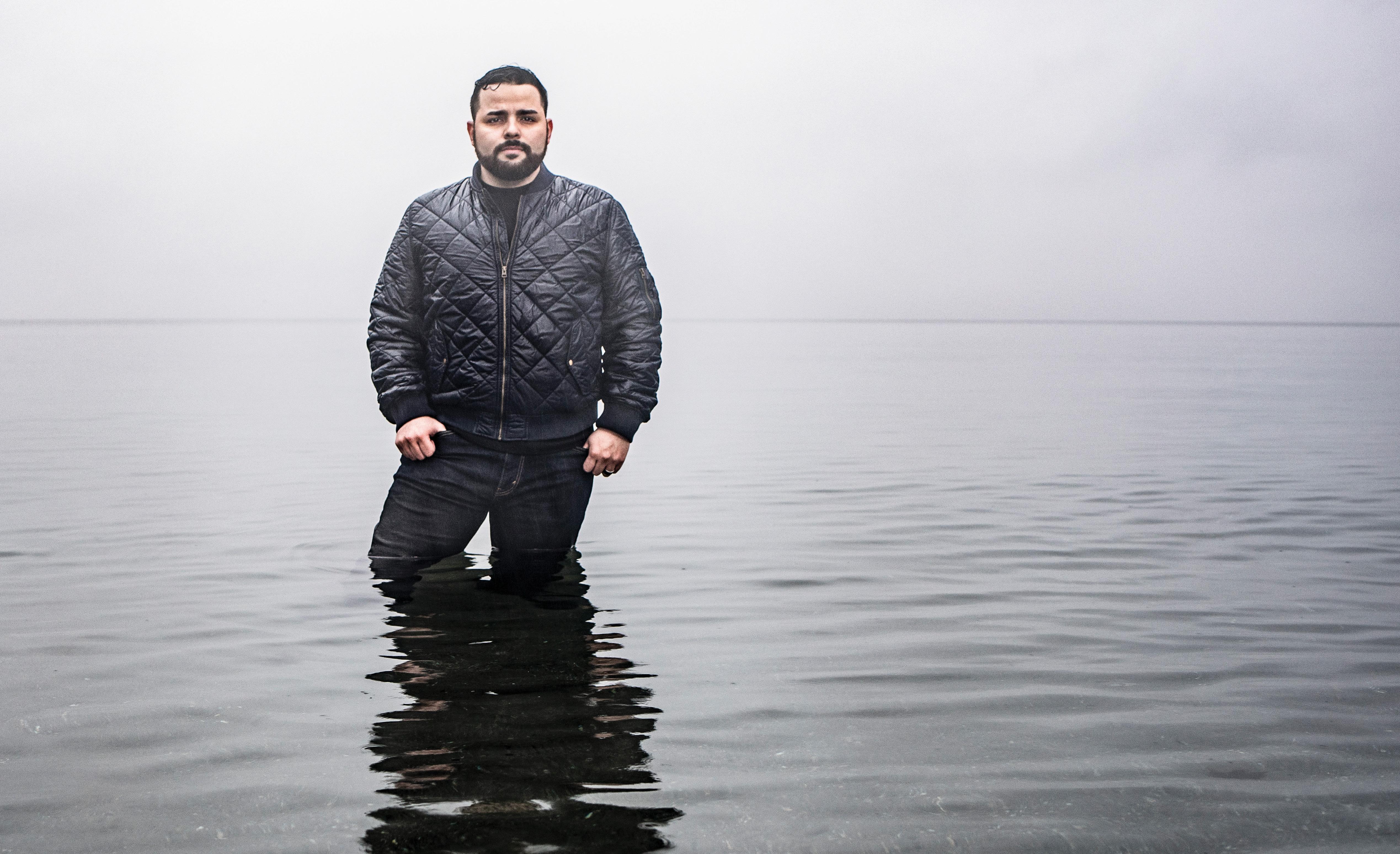 By Jamie Swenson
Photos by Dennis Wise
By Jamie Swenson
Photos by Dennis Wise
GENEROSITY AND OPPORTUNITY AT THE UW
44 UW MAGAZINE

As Hurricane Maria tore through Arecibo, Puerto Rico, in 2017, Miguel González-Montijo hunkered down at home with his family. They were no strangers to hurricanes. Just two weeks earlier, a Category 5 Hurricane Irma had skirted the island, demolishing homes, causing floods and knocking out power for more than a million people. And now Maria, with wind speeds up to 155 mph, was hitting Puerto Rico dead-on. Arecibo, with its peaceful golden beaches and lush hills rising behind it, was now a maelstrom of howling wind and driving rain.
Human-caused climate change was already leading to warmer oceans, enabling more frequent and more powerful hurricanes. But González-Montijo wasn’t thinking that far ahead—he was wondering when Puerto Rico’s power grid would recover and trying to distract himself by studying for graduate school entrance exams by lamplight. After earning his bachelor’s in engineering at the University of Puerto Rico at Mayagüez, he was deciding between finding a job or pursuing graduate studies.
Once the winds subsided, he and his family went outside to survey the scene. “Everything was destroyed,” he says. “The streets were filled with trees, light posts and electrical cables.” It soon became clear just how bad the situation was. A full 97% of Puerto Rico’s electricity is generated by fossil fuels and must travel over rugged mountains and through dense jungle en route to its customers— and now, that electrical grid was in shambles. It would be 2 1/2 months before González-Montijo’s family got their power back; others waited nearly a year. It was the longest blackout in U.S. history.
In the meantime, González-Montijo decided to pursue a graduate degree in civil and environmental engineering. He knew local jobs might be scarce as Puerto Rico slowly recovered. And there was a lot he still wanted to learn— hoping to eventually return home with skills to help make Puerto Rico more resilient.
Accepted to schools across the country, he chose the University of Washington for its many cross-disciplinary research opportunities. He’s now on the cusp of earning his doctorate. His intellectual curiosity led him to clean energy, and he found a community of people—in fields from electrical engineering and public policy to chemistry and physics—who shared his growing passion. At the heart of this passion is the UW’s Clean Energy Institute (CEI).
In 2013, the UW launched CEI with support from the state of Washington; Gov. Jay Inslee, ’73, championed the investment. The institute’s mission is to speed the transition to a scalable, equitable clean-energy future by advancing the next generation of solar energy and battery materials and devices, and improving their integration with the power grid. It was good timing: That same year, the Intergovernmental Panel on Climate Change released a daunting report, warning of the consequences of unchecked carbon emissions. From the get-go, CEI would operate with a sense of urgency. Over the past decade, a combination of federal, state and private investment has bolstered its mission.
In 2017 CEI opened its Washington Clean Energy Testbeds, high-tech labs where researchers and industry partners can use top-of-the-line equipment to develop clean-energy technology. Thanks to philanthropic funding, the Testbeds recruited faculty and staff with deep
industry experience, whose expertise can help innovators move technologies quickly from research to impact. Students of all degree levels can conduct clean-energy research and development side-by-side with industry. And each year, dozens of graduate students gain fellowships and professional experiences through CEI, preparing them for the complex, multidisciplinary clean-energy workforce. González-Montijo is one of them.
“I’ve been a professor for a long time, and I’ve never seen the motivation of the students circulating around the Clean Energy Institute,” says Dan Schwartz, BoeingSutter Professor of Chemical Engineering and CEI founding director. “They know we’re putting them in a position to have an impact.”
In his first year, González-Montijo learned that marine energy combined with microgrids (localized power grids) could help places like Puerto Rico recover from natural disasters. He got involved with a research project to more efficiently and economically produce marine hydrokinetic turbine blades—essentially, propellers that harness energy using the natural movement of water. But lab research alone won’t get clean-energy technology out into the world. It requires cross-disciplinary collaboration and testing facilities to make sure it can be produced in large quantities. It also benefits from the levers of private investment and public policy support.
González-Montijo saw these benefits when he first worked with CEI, through the Science Policy Analysis Track of the Torrance Advanced Experience Program. In this philanthropically supported role, graduate students contribute to technical policy briefs and white papers for the Washington State Academy of Sciences (WSAS), which helps inform state policy.
As a policy analyst, he worked on a report on decarbonizing Washington’s aerospace sector, which was presented at a WSAS symposium. He also got to hear from the CEO of electric-airplane company magniX and meet with a Washington state senator. Having his expertise valued made an impact on González-Montijo. “If this can happen
“Not everyone needs a Ph.D. to contribute to clean energy. There are a lot of opportunities that allow you to participate in this exciting field.”
Power the future. When you contribute to the Clean Energy Institute, you support the clean-energy technology of tomorrow—and the people who will create it. giving.uw.edu/march-2024
SPRING 2024 45
“If we were using other sources of energy, perhaps there wouldn’t be such a dire situation every time we get a natural disaster.”
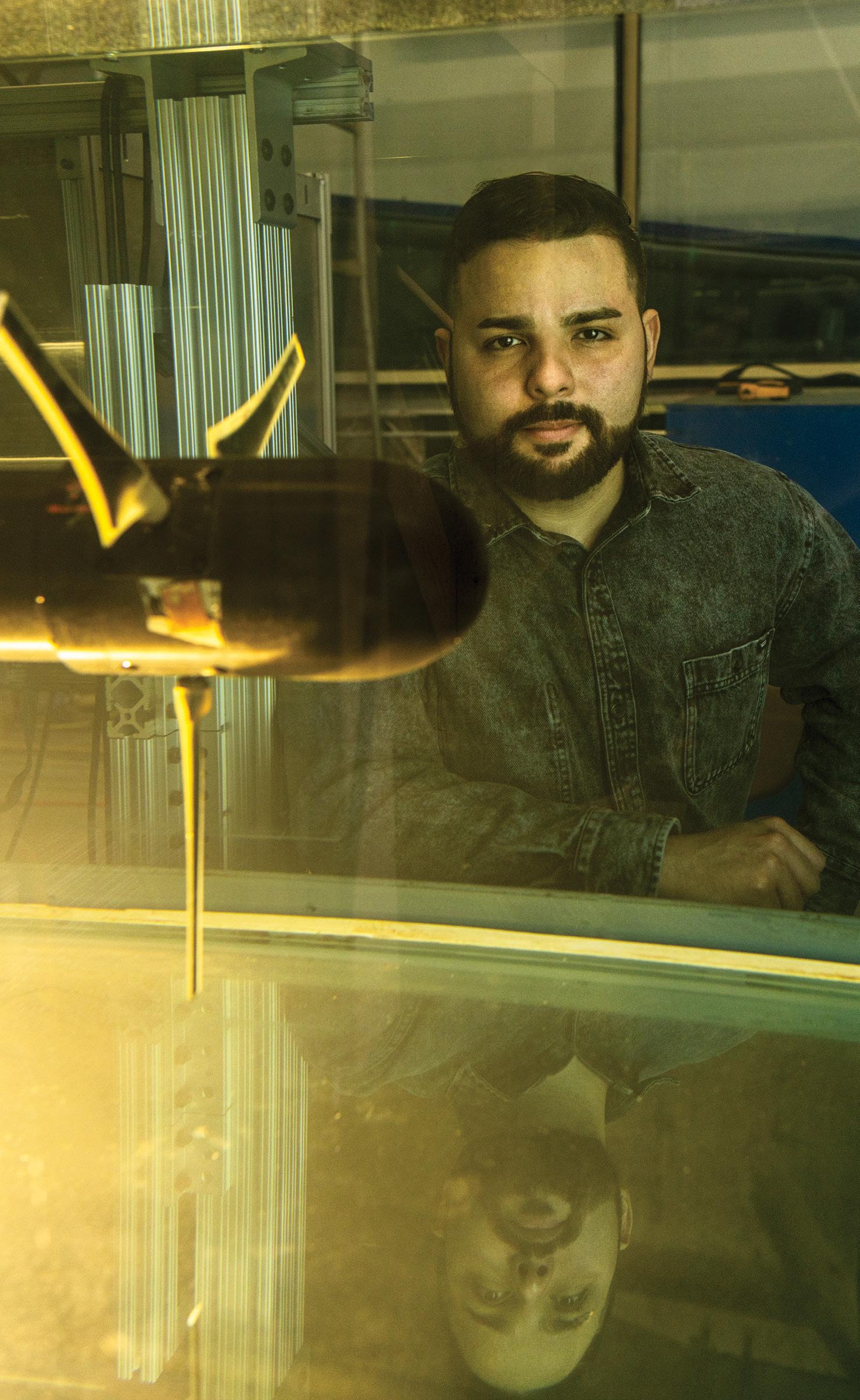
Miguel GonzálezMontijo’s research, in the lab of Mechanical Engineering Professor Brian Polagye, focuses on developing costefficient, open-source turbine blades.
here,” he realized, “it could happen in Puerto Rico. It gave me hope that one day my voice could matter there.”
González-Montijo went on to earn a CEI Fellowship, which involves learning from industry leaders and doing community outreach. He teamed up with Ricardo Rivera-Maldonado, a chemistry doctoral student and CEI fellow who’s also from Puerto Rico, to produce CEI’s first Spanish-language learning resource: a bilingual climate science fact sheet for K–12 students. They hoped to empower young people to discuss climate change and clean energy with their families and
communities. González-Montijo remembers one visit to an elementary school in North Seattle, where a girl who didn’t speak English became fully engaged when he and Rivera-Maldonado presented in Spanish. At a school in South Seattle, a young girl told them, “I want to be a scientist someday,” and began peppering them with advanced questions about geothermal energy.
For this meaningful project, González-Montijo and Rivera-Maldonado were honored with the Clean Energy Outreach & Service Award in 2022.
In addition to several roles with CEI, GonzálezMontijo has been a graduate research assistant for the U.S. Department of Energy’s National Renewable Energy Laboratory (NREL), where he has designed and developed a marine turbine blade component that will be open-source and accessible to startups working in marine energy. “Right now, we can’t afford to be selfish,” he says.
Over his UW career, González-Montijo has advanced research in marine energy. At CEI, he’s traded ideas with colleagues and professors in chemistry, electrical engineering and physics. And he’s shared his expertise with people in government, in industry—and in elementary school.
“Not everyone needs a Ph.D. to contribute to clean energy,” he says. “There are a lot of opportunities that allow you to participate in this exciting field.”
After Hurricane Maria passed, González-Montijo remembers the intense humidity that clung to him like a blanket. The smell of shredded vegetation lingered on the air, clean like freshly cut grass. The familiar crickets, owls and frogs stayed eerily quiet the first night or two. Gradually, they reemerged and resumed their nighttime calls. It would take the people of Puerto Rico much longer to begin returning to life as usual.
“If we were using other sources of energy, perhaps there wouldn’t be such a dire situation every time we get a natural disaster,” says González-Montijo. He has hope, though. Clean-energy technology is seeing huge advances that could make a difference around the world. In fact, he says, NREL is studying how to best deploy marine and wind power and microgrids in Puerto Rico. And communities there are already starting solar-powered microgrids of their own.
There is one positive that González-Montijo remembers from the aftermath of Hurricane Maria: “It created unity among us. We depended on one another. It brought us all closer together.”
Perhaps a clean-energy future will be powered by such a supportive mindset. González-Montijo is doing his part to make this a reality.
46 UW MAGAZINE

The Washington Clean Energy Testbeds: Where Education Meets Industry
Mike Pomfret has been managing director of the Washington Clean Energy Testbeds since they opened in 2017. With a doctorate in chemistry and a background in research and startup leadership, he knows from experience that some of the most innovative companies on the market are startups. “But,” he says, “they tend to have the most financial challenges.” A startup in solar power or lithium-ion batteries might be stymied by the cost of the equipment needed to innovate, test and scale up their product.
That’s where the Testbeds come in. These high-tech labs are open access and available for an hourly fee, so startups can access industrial-quality equipment and staff scientists’ expertise to develop their technology. At the main Testbeds site, an unassuming former warehouse on the outskirts of University Village, you’ll find safety-goggled scientists using equipment like a 30-foot roll-to-roll printer for solar cells and batteries; devices that replicate the sun’s power to test solar technology; and a digital simulation of a power grid.
Companies that use Testbeds technologies get to keep their intellectual property, too. “That brings people in,” says CEI director Dan Schwartz. “This has never been about maximizing University revenues. It’s about maximizing our ability to have an impact on students and on companies that might be able to reduce carbon emissions faster.”
Students also benefit from access to the Testbeds and proximity to industry. Hannah Contreras, a chemistry doctoral student and CEI Fellow, chose the UW for its “clear, established infrastructure for clean-energy research.” In her Energy Materials, Devices and Systems (EMDS) course, held at an on-campus Testbeds location focused on research and training, she made her first solar cell—a task she now does regularly in her research on next-generation solar cells. And through the Tech Due Diligence Track of CEI’s Torrance Foundation Advanced Experience Program, created thanks to philanthropic generosity, Contreras advises climate tech investors as they evaluate companies seeking funding.
“Our students are hungry to contribute to a clean-energy future,” says Cody Schlenker, an EMDS instructor and Washington Research Foundation Innovation Associate Professor of Chemistry and Clean Energy. “They’re ready to take ownership and fix the problem. Our goal is to help equip them to do it.”

A Clean, Green Future
By Ken Denman Chair, UW Foundation Board
As a venture capitalist, and through my decades of business leadership, I’ve always paid close attention to groundbreaking ideas and the people who turn them into reality. And some of the smartest folks in the world, in just about every discipline, are right here at the UW. Many of them, concerned about the health of our planet, are devoting their education and careers to a cleaner, greener future. Some are developing innovative new technologies. Others are getting their hands dirty to improve our relationship with the planet and with one another.
At the frontier of technology is the UW’s Clean Energy Institute (CEI), formed in 2013 to help accelerate our transition away from fossil fuels. With the guidance of CEI experts and access to CEI’s open-source, industry-standard Washington Clean Energy Testbeds, startups can move their innovations to market more quickly. And through hands-on, interdisciplinary experiences, UW students can jump-start their careers in clean energy. You can read more about one such student, and about CEI, beginning on p. 44.
Another example is the UW Farm, which is cultivating a sustainable future—and addressing the harm humans have caused in the past. Based on the site of a former landfill, this scrappy student- and volunteer-powered organization is both a production farm and an immersive educational program that works with the wider community. Since its founding at this location nearly 20 years ago, the UW Farm’s soil health has improved dramatically. Its Native Garden has created opportunities for cultural reconnection—long before the site was a landfill, this place was home to Coast Salish longhouses and a fishing weir. The UW Farm has donated many tons of produce to local food banks. And with two additional locations on campus, it has plenty to teach us about how urban farming can contribute to a more sustainable future. Read about how the UW Farm shapes the Husky Experience on p. 48.
These transformative organizations, and many more at the UW, have thrived because of the brilliant and dedicated people who work there—and because of supporters like you who help them turn their mission into reality. With your continued help, we can keep breaking ground together.
Thank you.
CYRUS MCCRIMMON
the CEI Testbeds will have a new home in Portage Bay Crossing, the UW’s new knowledge community being developed west of campus. Learn more:
Soon,
uw.edu/portagebaycrossing
SPRING 2024 47
LEARNING IN A LIVING LABORATORY
A pizza party was what first lured Aisling Doyle Wade, ’21, to the UW Farm. Against the backdrop of golden sunflowers, she found a welcoming community—inspiring her to sign up for an Urban Farm class in the College of the Environment.
As a UW student, Doyle Wade (second from right) volunteered and worked at the farm’s three sites: a sprawling 1.5 acres near Union Bay Preserve, a rooftop garden at McMahon Hall and an urban farm site between the seven-story buildings of Mercer Court Apartments. After graduating with a degree in Community, Environment & Planning, she returned as the farm’s production manager to help oversee its day-to-day operation.
Each year, some 1,200 to 1,500 Huskies like Doyle Wade find their way to the UW Farm through classes, service-learning programs, research projects and clubs. Students are at the heart of the certified-organic farm, which began as a registered student organization in 2006. Today, it generates 13.8 tons of produce annually for campus dining, the Husky Food Pantry and a community-supported agriculture (CSA) program.
When they’re plucking sun-ripened tomatoes off the vine for a CSA box, coaxing spiny thistles out of the ground before the winter or adjusting to daily weather shifts, students gain hands-on insights in this “living laboratory,” says farm manager Perry Acworth, ’14.
For Doyle Wade, this immersive learning was an invaluable part of her Husky Experience. “It’s about connecting what you’re learning in class to a real-world example,” she explains. “I learned better seeing and experiencing things firsthand.”
ByMalavikaJagannathan PhotobyDennisWise
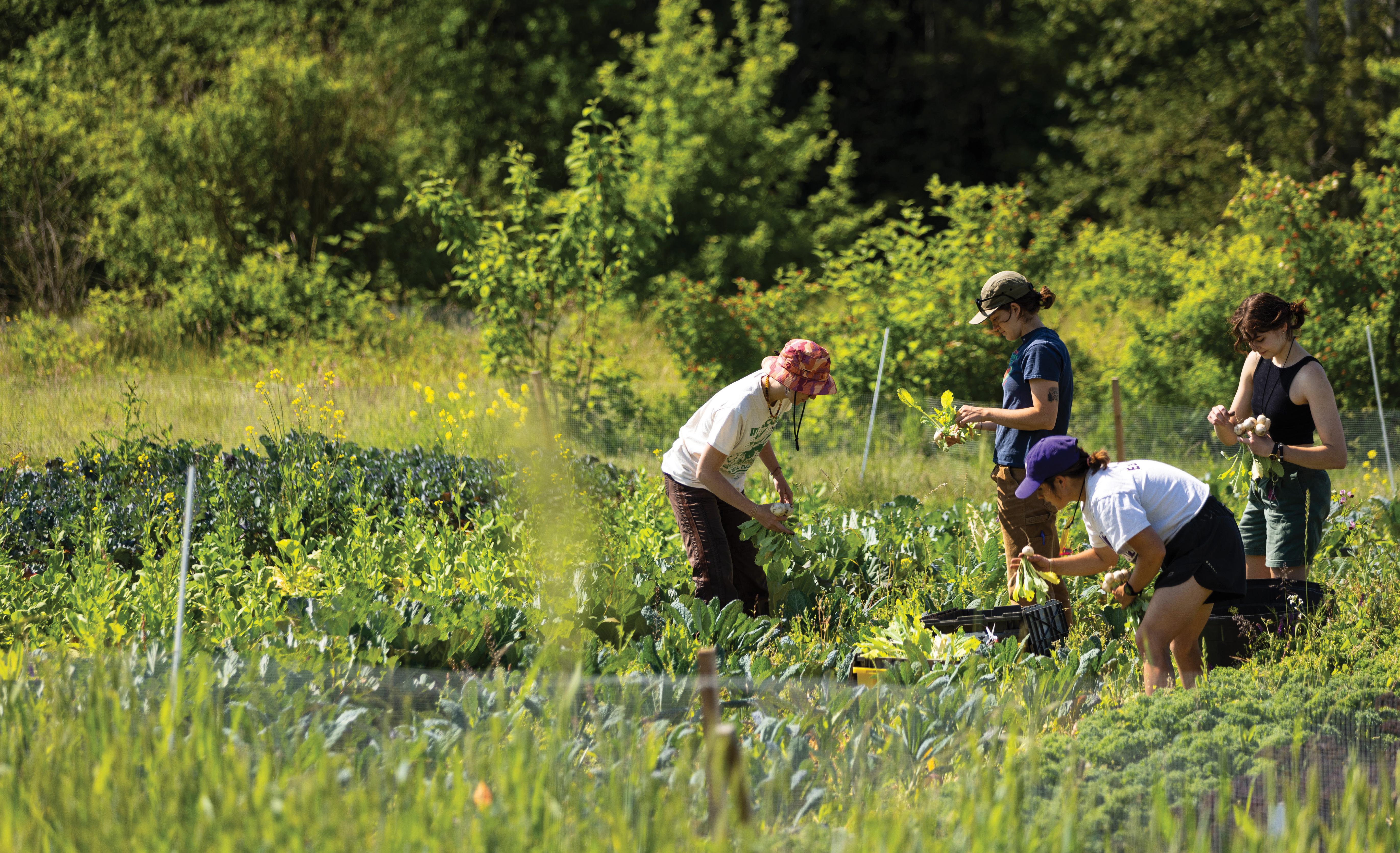
48 UW MAGAZINE
Promote hands-on learning. When you support the UW Farm, you give Huskies the opportunity to learn about regenerative agriculture, food systems and sustainable living in a unique urban farm setting. giving.uw.edu/march-2024

SPRING 2024 49
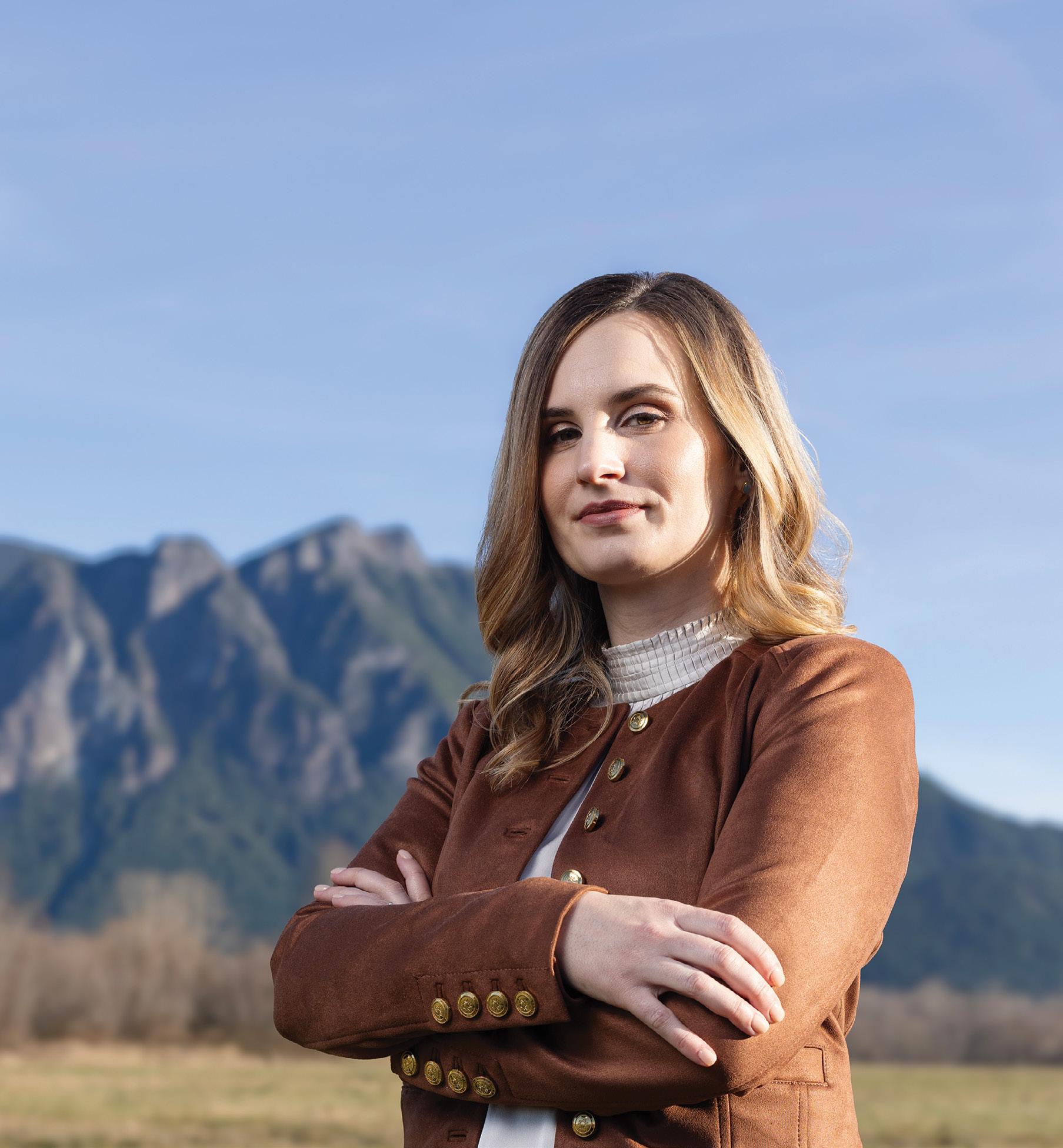
Reaching and Teaching
Teacher Pamela Savagaonkar saw a gap in STEM education for kids and started a venture in Snoqualmie Valley
By Jon Marmor
Pamela Savagaonkar turned a quest to find summer science camps for her children into a thriving business in the Snoqualmie Valley.
Inspired by her father’s career in dentistry, Pamela Savagaonkar developed a passion for the STEM field, leading her to pursue advanced math and science courses at the University of Washington. Juggling her university studies with a full-time position at Seattle Children’s, she also embraced motherhood at a young age while finishing her degree.
Needing a family-friendly schedule, she chose a career in education and began teaching in Bellevue. After looking fruitlessly for summer STEM camps for her young children, she identified the need for academic and enrichment programs. With her teaching background, a bachelor’s degree in forest resources from the UW, and two master’s
Continued from p. 18
recounts the details of Washington state’s Fish Wars of the 1960s and ’70s and the successful legal action to uphold tribes’ treaty rights to fish at their usual and customary sites. Looking back to his time as a student, Blackhawk says he didn’t realize the importance of the community around him. “I’ve come to see a little bit regretfully that I lived in the center of an environment rooted in the history of active political advocacy that has made Indian sovereignty legitimate not just across the Northwest, but across North America,” he says.
Blackhawk was drawn to the UW in 1994 to pursue his doctorate with Professor Richard White, ’72, a well-known scholar of Native American and environmental history. When he arrived, Blackhawk encountered far fewer Indigenous students and faculty than he might today. Nonetheless, he found a community. Staff and faculty, including Augustine McCaffery, ’85, ’92, ’12, and Associate Professor Cheryl Metoyer made the University welcoming and helped him navigate the gray and grueling early years of his Ph.D.
“When Ned came to Washington, I recognized right away then what we see now: He was very smart and a stronger and stronger writer,” White says. The professor encouraged Blackhawk’s interest in researching American Indians and colonists in the Great Basin, which became the focus of his dissertation. “Ned had something you can’t teach: He could figure out what is a significant issue and what can be explored,” says White.
That is essentially what Blackhawk has done again—only this time creating a sweeping history of Indigenous North America drawing from recent scholarship and reinterpreting events from a fresher standpoint.
degrees in education, she took a leap and founded Cascade Enrichment in 2016.
She made Cascade Enrichment especially family friendly by having her staff of more than 50 educators drive to kids’ homes for tutoring sessions or deliver help remotely. “Kids like having tutoring from home instead of at a facility,” she says.
Snoqualmie Valley-based Cascade Enrichment offers STEM nights in local schools as well as summer STEM camps where kids can build a catapult and make xylophones with jars of water. Savagaonkar also created an assessment system that provides parents with data to understand how their children are doing. No wonder Cascade Enrichment is such a success.
At the start of his academic career, Blackhawk was frustrated with the pervasive narratives that seem to overlook significant scholarly and academic work featuring Indigenous people. “I have always felt that Native American history has been marginalized in the study of American history,” he says. Even today’s most popular historians—those who appear on The New York Times best-seller list—seem to forget or at least omit the Native Americans, Blackhawk says. Or they describe the Indigenous experience as a homogenous event. But finding the Native American people in history “may not be as hard as it sounds.” For well over 100 years, historians, anthropologists and other scholars have been exploring Indigenous history.
The sources are out there, he says. “That’s the world of academic underdevelopment and underrecognition that I am working to expose.”
50 UW MAGAZINE
RON WURZER
Proudly cheering on our hometown and Husky Nation since 1971.
Go Dawgs.

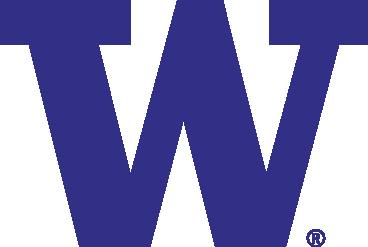

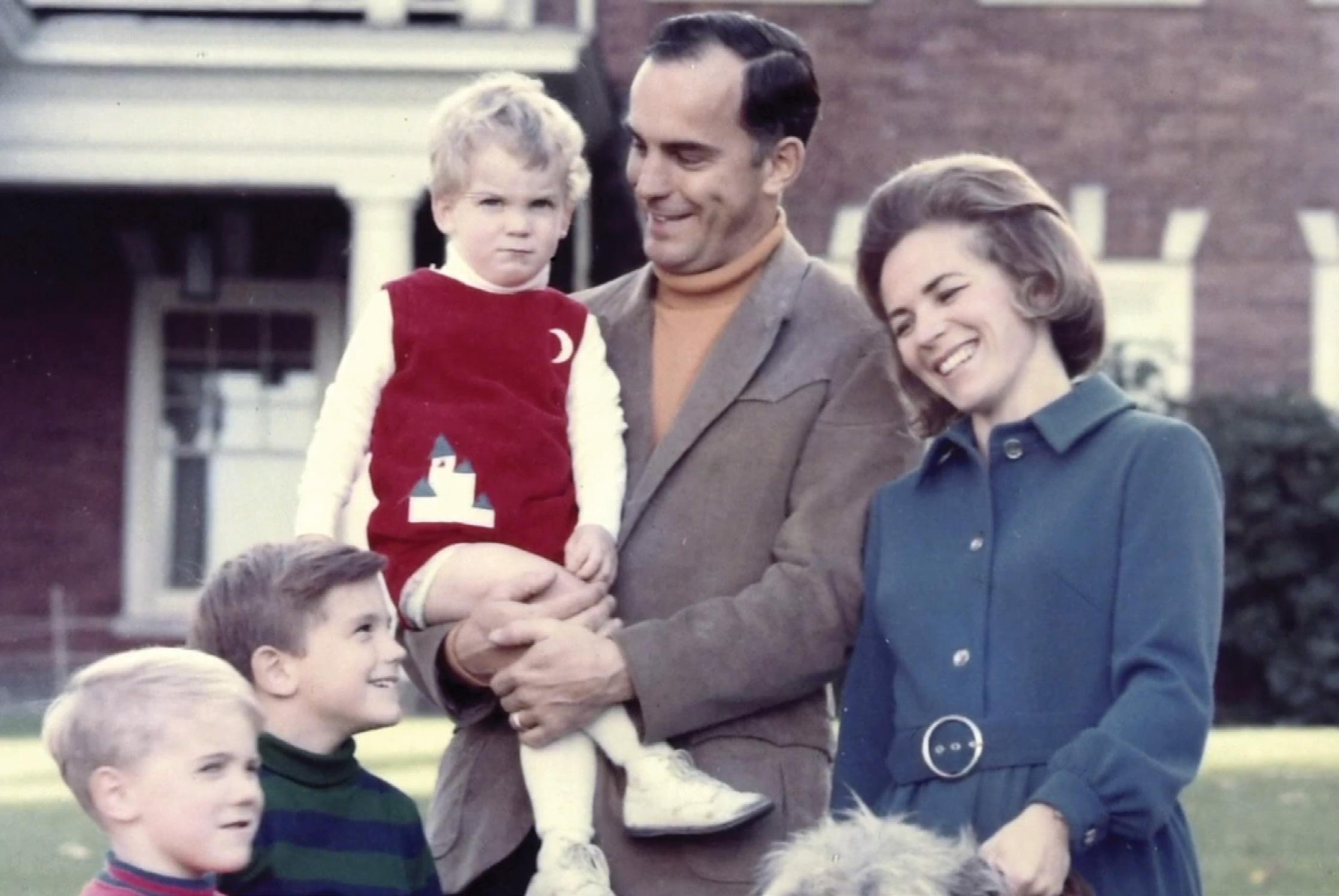
Grace, Passion and Public Service
Nancy Bell Evans was an inspiration to UW students as well as one of the University’s biggest champions
By Jon Marmor
Nancy Bell Evans was revered for her graceful, steadfast support of education, health care and arts and culture in the state of Washington. The longtime wife of former Gov. Dan Evans, ’48, ’49, died Jan. 26 at the age of 90.
“Nancy was a true civic leader who dedicated her life to helping others, including UW students and the state we all serve,” UW President Ana Mari Cauce said. “She was not only a supporter of the UW’s Evans School, she was an inspiration to the many students who will follow her footsteps into public service.”
Evans helped found and later served as chair of the Friends of Cancer Lifeline, national chair of the First Ladies’ Mental Health Month, a founding trustee of Planned Parenthood of Olympia and a founder of the Governor’s Mansion Foundation.
The phrase that came up most often when describing Evans was “a force of nature,” her family said in a statement to
The Seattle Times.
Born Nancy Ann Bell in Spokane on March 21, 1933, she loved music, played piano for an orphanage and earned a degree in music from Whitman College. She met Dan Evans—then serving in the Washington state House of Representatives—during a ski trip. They were married in 1959. When he was elected governor in 1964, she became the youngest first lady in state history at the age of 31. Dan Evans served as governor of Washington from 1965 to 1977.
At the tail end of the Vietnam War, Dan invited Vietnamese refugees to come to the Evergreen State. The couple welcomed the first group of refugees to arrive.
Nancy was a member of the UW Foundation as well as the Dean’s Council at the Daniel J. Evans School of Public Policy & Governance. She also served on the visiting committee of the UW School of Public Health and was an honorary cochair of the Evans School’s campaign.
RECOGNITION

COLLEEN MCELROY, ’73, not only was the first Black woman to become a full-time professor at the UW but she earned an international reputation as a writer, especially of poetry. The mentor of Ada Limon, ’98, the current U.S. poet laureate, she joined the UW faculty in 1973. She won the American Book Award in 1985 for her book of poetry “Queen of the Ebony Isles.” She died of natural causes at the age of 88 on Dec. 12.
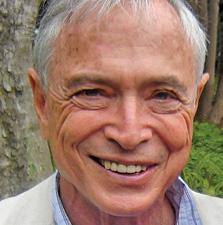
ABE BERGMAN was a professor emeritus of pediatrics at the UW School of Medicine who was a giant in children’s safety. He advocated for research into sudden infant death syndrome, fought to strengthen the standards for children’s flame-resistant sleepwear, helped establish the Odessa Brown Children’s Clinic in Seattle’s Central District and helped pass the Indian Health Care Improvement Act of 1976. He died Nov. 10 at the age of 91.
52 UW MAGAZINE TRIBUTE NANCY BELL EVANS, 1933–2024 COURTESY OF THE EVANS FAMILY

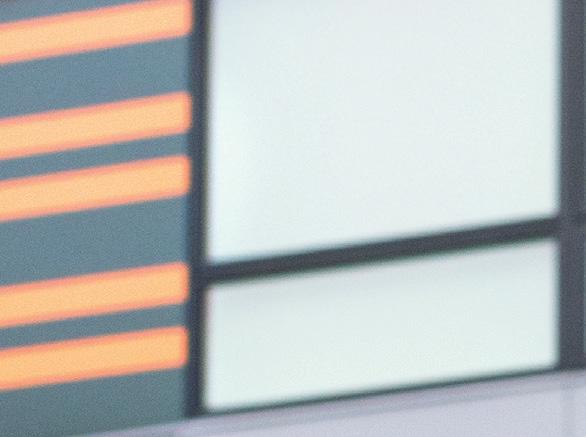


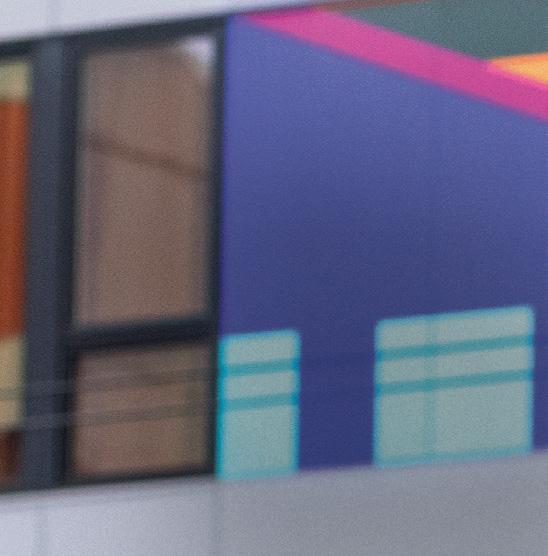


REAL DAWGS WEAR PURPLE









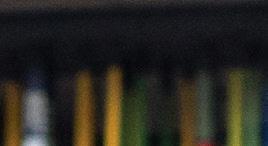
DIRECTOR, SEATTLE’S OFFICE OF PLANNING AND COMMUNITY DEVELOPMENT


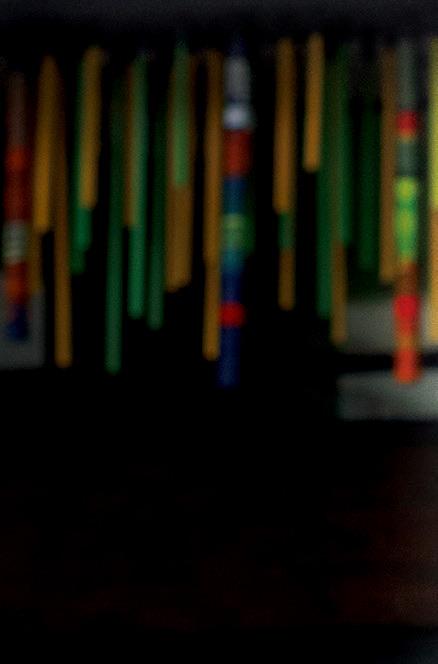

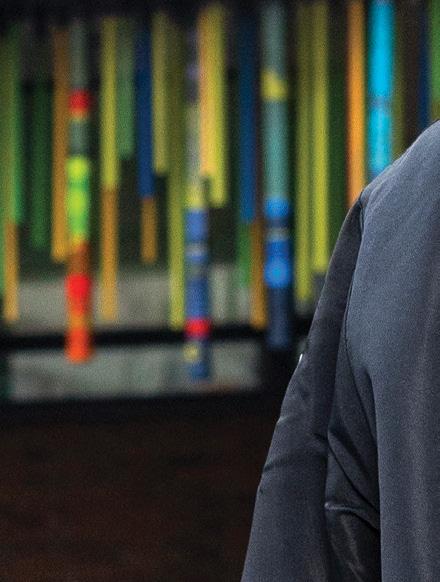
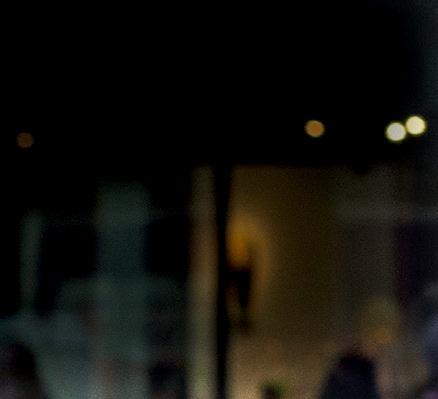
Ask Rico Quirindongo, and he’ll tell you architecture is more than design and construction—it’s also about building community. Eager to return to his Seattle roots after college, Quirindongo was drawn to how the University of Washington’s graduate architecture program connects students to practicing architects and planners. For his thesis project, the proud Husky supported community eff orts to create the Northwest African American Museum—a project he’d later see forward as a professional architect. Quirindongo has made his architectural mark on Seattle, from reimagining Climate Pledge Arena to overseeing the waterfront expansion at Pike Place Market. Through his current role with the city of Seattle, this dedicated Dawg aims to build a more equitable city where people of all income levels can aff ord to live—and all communities benefi t from growth and development.


realdawgswearpurple












wearpurple UWearPurple






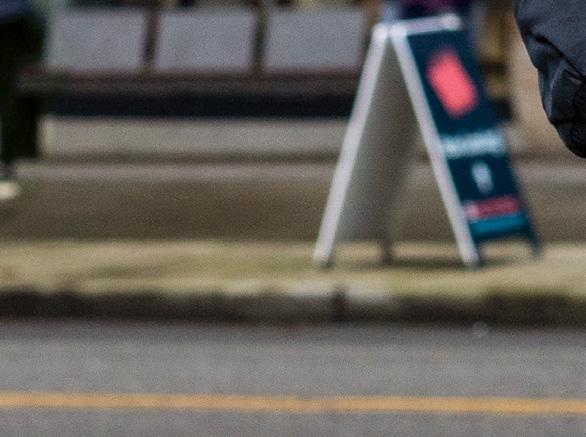


In Seattle’s Central District, Rico Quirindongo stands in front of the Midtown Square complex he designed, which includes affordable housing, local art and Black-owned businesses.



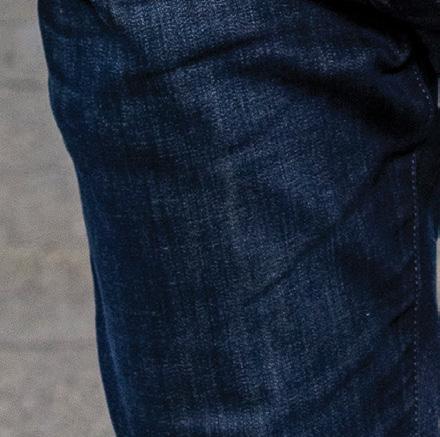


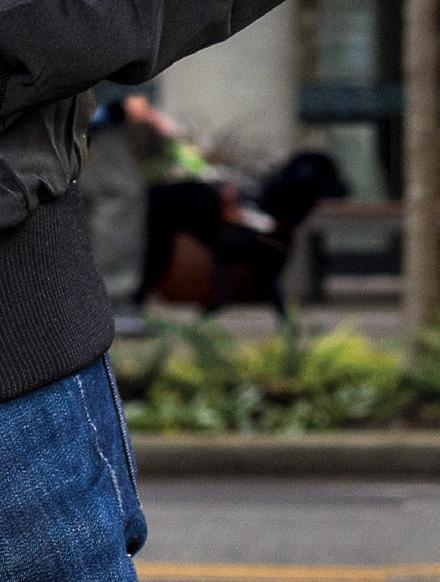

In Memory
ALUMNI
MICHAEL L. ANDERSON Burien, age 85, Sept. 27
1940
BARBARA SAUNTRY ’41, Seattle, age 103, June 30
GORDON S. GIOVANELLI ’49, ’63, Escondido, California, age 97, Dec. 21, 2022
1950
FRANK P. HOLBERG ’50, Bothell, age 95, Nov. 12
DUANE E. MATTHEWS ’51, Issaquah, age 93, Sept. 17
ROCKY VERNON LINDELL ’52, ’56, East Wenatchee, age 94, Nov. 15
MARYLU ANN WALLERICH ’52, ’53, Tacoma, age 92, Oct. 16
CHRISTY ALICE TIMBERLAKE ’53, Rancho Mirage, California, age 91, Nov. 10
MARTHA TROLLIER ’53, Redmond, Oregon, age 91, March 6, 2023
JACK WARNICK ’53, Tacoma, age 91, Nov. 21
BARDEN “BUD” ERICKSON ’54, Freeland, age 93, Dec. 2
JON M. “BOBO” JONSSON ’54, Seattle, age 94, Nov. 18, 2022
DONALD A. LEACH ’54, Burlington, age 93, Oct. 15
BARBARA NEVILLE LENTZ ’54, Yarrow Point, age 91, Sept. 17
DEIRDRE RAPALJE PLUNKETT ’55, Lopez Island, age 91, Oct. 27
DONALD K. MCCANDLESS ’55, Auburn, age 90, June 16
JAMES LEE SALLEY ’55, ’56, Mercer Island, age 90, Sept. 19
CHARLES JOSEPH SEDLACEK ’55, ’64, Redmond, age 90, Sept. 28
DIANE M. FATHI ’56, Seattle, age 89, Oct. 28
MANFORD H. WILLIAMSON ’56, Bothell, age 92, Nov. 28, 2022
PAUL JEROME FARRELL ’57, Salem, Oregon, age 88, July 21
CAROL SATHER LODMELL ’57, Mercer Island, age 88, Oct. 16
DENNIS LEO HARKONEN ’58, Redmond, age 87, Sept. 30
JOHN SAYRE ’58, Anacortes, age 87, Nov. 9
MARY SHEILA BOIN ’59, Palm Desert, California, age 86, Sept. 29
DOUGLAS G. FREEMAN ’59, Kirkland, age 88, Nov. 8
JOLENE MARIE HOPPE KUHNS ’59, Kennewick, age 89, Oct. 15
ROLF C.E. LUTH ’59, Des Moines, age 89, Oct. 1
LYNN MCALLISTER ’59, Seattle, age 86, Oct. 27
CHARLES WHITEMAN ’59, Issaquah, age 87, Nov. 24
1960
SONJA BERG ’61, Lynnwood, age 84, Nov. 24
GUNBJORG LADSTEIN ’61, Seattle, age 85, Nov. 3
BETTY JOAN MCDOUGALL ’61, Seattle, age 90, Nov. 25
MICHAEL JOSEPH CORDRY ’62, Seattle, age 83, Nov. 7
MARY CORINNE FLYNN ’62, Shoreline, age 85, Oct. 7
WILBUR L. JURDEN JR. ’62, ’68, Nordland, age 83, Nov. 26
KATHERINE SIMPSON ’62, Streetsville, Ontario, age 83, Nov. 18
PATRICK DREW ’63, Seattle, age 84, Nov. 25
JUDITH DENNIS JURDEN ’63, Nordland, age 82, Nov. 19
GLENNIS (PAGE) BACHER ’64, Edmonds, age 84, Nov. 22
DAVID MCARTHUR HEWITT ’64, Seattle, age 86, Nov. 2
NANCY MADGE MILAN ’64, Seattle, age 81, Oct. 23
KATHERINE FOVARGUE OLSON ’64, Seattle, age 81, Oct. 29
JOHN MICHAEL “SUDS” RILEY ’64, Bellevue, age 82, Sept. 28
STEVEN WILSON ’64, Tucson, Arizona, age 81, Nov. 10
JOHN GILBERT BERGMANN ’65, Shoreline, age 84, Oct. 23
FREDRICK “FRITZ” BOWMAN ’65, Clyde Hill, age 81, Aug. 22
WILLIAM KINZIG
’65, Bellevue, age 81, Aug. 7
GEORGE KOZU ’65, Brier, age 97, Nov. 28
JAMES WILLIAM ANABLE ’66, Seattle, age 85, Dec. 3
KAREN DAHLIN
’66, ’68, Bellevue, age 79, Nov. 28
DAVID S. MARGESON
’66, Guemes Island, age 80, Sept. 19
JAMES DOUGLAS SPAETH
’66, Vancouver, British Columbia, age 81, Oct. 4
THOMAS BUCHANAN
’67, Portland, Oregon, age 82, Oct. 31
DAVID COVEY
’67, Renton, age 79, Nov. 5
WILLIAM EDWARD LARTER
’67, ’71, Everett, age 81, Nov. 16
PAUL W. SWENSSON
’67, Olympia, age 78, Nov. 17
PAMELA CHENEY
’68, Seattle, age 59, Nov. 8
MICHAEL K. HALL
’68, Gig Harbor, age 77, Sept. 18
GEORGE COLE SCOTT III
’69, Richmond, Virginia, age 86, Oct. 25
PHILLIP B. WINBERRY
’69, Seattle, age 78, Sept. 27
ROSS ALAN WORD ’69, Winter Haven, Florida, age 71, June 4, 2018
1970
JOHN DRINKARD ’71, Seattle, age 77, Oct. 27
RICHARD GEIST ’71, Colorado Springs, Colorado, age 81, Oct. 24
JACK B. JAFFE ’71, Newberg, Oregon, age 78, Dec. 23
LARRY RICHTER ’71, Seattle, age 77, April 20, 2022
JACK MARTIN SEGEL JR. ’71, Federal Way, age 76, Oct. 8
GARY DEAN TORGERSON ’72, Seattle, age 82, Oct. 20
ASIA ALDERSON BENNETT ’73, Seattle, age 89, Dec. 11
NANCY BOOTHROYD RUMMEL ’73, Shoreline, age 93, Nov. 18
MARK C. WAI ’73, ’76, Burbank, California, age 71, Oct. 22, 2020
JOHN E. WEIR ’74, Lexington Park, Maryland, age 81, Jan. 1
MARY KATHRYN BARBIERI ’75, Bow, age 80, Oct. 29
LEO B. BLODGETT JR. ’75, Portland, Oregon, age 75, May 13
KAREN MILLWARD ’77, Seattle, age 78, Sept. 18
DOROTHY J. KELLY ’78, North Bend, age 89, Dec. 5
MATTHEW LAWRENCE PRATT ’78, La Conner, age 68, Oct. 2
LINDA WALKER CAPRON ’79, Redmond, age 67, Sept. 28
EDWARD “WAYNE” KUTCH ’79, Snohomish, age 68, Sept. 29
1980
TANYA TRUAX SHAWCROFT ’80, Hansville, age 72, Dec. 23
LINDA GERMAN WOLD ’81, Seattle, age 74, Nov. 12
BRUCE CUTTER ’82, ’83, Liberty Lake, age 70, Jan. 6
CATHERINE JANE BARKER ’83, ’88, Edmonds, age 77, Nov. 13
KIMBERLY IONE TURNER ’83, Tacoma, age 62, May 18
KEVIN ROBERT SCUDDER ’89, Seattle, age 63, June 28
1990
SUSAN MARIE COLEMAN ’93, Mukilteo, age 82, Nov. 27
BRENDA HECKATHORN ’95, Redmond, age 49, July 25
ERIN FINNEGAN ’97, Santa Barbara, California, age 61, Nov. 8
CLEA FINKLE ’99, Seattle, age 60, Nov. 28
2000
ANDREW JACOB NACHTIGAL ’03, ’09, Seattle, age 47, Oct. 16
2010
DEBRA HOPSON ’12, Lacey
FACULTY AND FRIENDS
DIANE ADAM worked at the UW in nursing and medical research, specializing in women’s health. She died Aug. 26 at the age of 72.
MARY JO BOARMAN worked as a purchaser at the UW. She died July 31 at the age of 91.
E.J. BRISKER, ’70, was one of the founders of the UW Black Student Union, which led the 1968 occupation of the UW President’s Office and other campus efforts to improve diversity, equity and inclusion at the University. A native of Mississippi, he joined demonstrations after Emmett Till was murdered, and later was asked by Stokely Carmichael to create and lead the Seattle chapter of the Student Nonviolent Coordinating Committee. He died Sept. 20 at the age of 80.
TUFA TAULA BROWN worked in food services at Harborview Medical Center. She was known for her no-nonsense attitude that commanded respect. She died Nov. 30 at the age of 65.
WILLIAM BUSH JR. was a professor of radiology at UW Medicine after starting his career at Virginia Mason Medical
54 UW MAGAZINE
Center. The Oregon native enjoyed time with family and friends, fly-fishing, singing barbershop music and taking in college and professional sports. He was preceded in death by his wife, Janet, who died exactly one month and one day before he did. He died Sept. 15 at the age of 82.
JIM CAPLE, ’97, was a Longview native who became a national baseball writer for ESPN, The Athletic, The Seattle P-I and St. Paul Pioneer Press. He also was a former reporter and editor at The Daily and a frequent contributor to the University of Washington Magazine. He wrote a wide range of stories from the history of Husky Stadium to the story of “The House at 5030” that documented the lives of Jim and 10 friends who shared a U District boarding house. He died Oct. 1 at the age of 61.
MARY JO CASTLEBERRY
worked as a secretary at Harborview Medical Center and later became a nurse. She died Oct. 15 at the age of 79.
ROY JAY CORREA JR., ’54, was a Seattle urologist who served on the clinical faculty of the UW School of Medicine. He died Nov. 21 at the age of 91.
KIRBY CRAMER, ’62, served in the Marines, earned his MBA at the UW and bought a company that he evolved into Hazleton Laboratories, one of the largest testing companies in the world. A major supporter of the UW, he was a founding partner of Keystone Capital. He died Aug. 7 at the age of 86.
DIANA DARIN, ’79, served as an administrator at the UW for more than three decades. As the director of the University’s Human Subjects Office, she played a key role in the development of informed consent for human subjects and in protection for humans as well as primates in the arena of research and experimental studies. She died Aug. 3 at the age of 91.
STEPHEN FINK retired from the UW in 2018 after 18 years as the founder and executive director of the UW’s Center for Educational Leadership. He died Sept. 5 at the age of 71.
JENI KAY FUNG, who worked at the UW from 1965 to 1988, played a key role in establishing the UW Continuing Education Program. She also
worked as an administrative assistant to Dr. Sheldon Rovin, former dean of the UW School of Dentistry, and to Dr. Rheba de Tornay, former dean of the UW School of Nursing. She was involved in the creation of several key programs in nursing, including one that addressed the health-care needs of the aging population. After her retirement in 1988, Gov. Gary Locke appointed her to the Washington State Nursing Care Quality Assurance Commission as a public member from 1997 to 2000. She died Nov. 16 at the age of 98.
MARIE SVENDSEN HALVERSON, ’55, championed many causes and was a board member and advocate of the Burke Museum for more than 40 years. She died Oct. 21 at the age of 90.
SIGVARD T. HANSEN JR., ’61, ’69, was a trailblazer in orthopedic traumatology and foot and ankle reconstruction. He created Harborview Medical Center’s world-renowned orthopedic traumatology fellowship and was chair of UW Medicine’s Department of Orthopedics. He wrote the premier and most widely used textbook in the field of foot surgery and his programs turned out hundreds of highly distinguished skilled trauma and foot and ankle surgeons, many of whom now head their own training programs. He died Nov. 11 at the age of 87.
ALLAN SACHS HOFFMAN was recruited to the UW from MIT to create a world-class bioengineering department. During his time building an international powerhouse at the University, he worked on controlled drug delivery and biomaterial-surface modification and published more than 500 scholarly articles. He died Dec. 15 at the age of 91.
NANCY JO IRVIN retired in 1999 after working 36 years for UW Medical Center-Montlake. The Montana native held numerous positions at the UW, from staff nurse to charge nurse to administrative liaison to the medical director. She died July 26 at the age of 87.
GEORGE KACHLEIN III, ’56, served in the Navy after graduating from the UW. He went on to work for his father-in-law’s company, Ellensburg Telephone Co. He helped grow ETC into a highly respected telecommunications company and worked his way up to head the team
in his 40-year career. He served on the Ellensburg City Council and on the boards of The Washington Athletic Club, Central Bank of Washington and AAA Washington. A major supporter of the UW, he died Nov. 9 at the age of 89.
ELIZABETH MIDORI KOBAYASHI, ’53, was a member of the University of Washington Faculty Auxiliary hiking group. She died Dec. 9 at the age of 94.
GAYLE BARRY LEE, ’59, was the only female graduate from the UW Law School in 1959. She went on to serve more than 35 years as assistant attorney general for Washington state. She died Dec. 16 at the age of 88.
ALAN LEONG, ’97, was a lauded UW Bothell business professor who was twice voted best MBA professor at UW Bothell (in 2006 and 2013). He was honored with a Certificate of Excellence from the Foster School’s Undergraduate Business Council. He died Oct. 11 at the age of 65.
KATHRYN “NAN” LITTLE, ’96, ’98, helped create the YMCA Earth Service Corps as its first director, and worked on the UW’s outreach to Native American students. She died Nov. 30 at the age of 78.
RALPH JUSTIN MALOTT, ’66, served in the Army at the end of World War II, completed medical school and later came to the UW to get his degree in psychiatry. He retired as a professor in the UW School of Medicine. He died Nov. 11 at the age of 100.
DONALD WALDO MITCHELL, ’70, was a medical resident at Harborview Medical Center before joining the U.S. Public Health Service. He died Nov. 1 at the age of 84.
LORNA FRASER MULLIN, ’57, was a major supporter of the UW who served on the UW School of Nursing Advisory Board. She died Dec. 6 at the age of 89.
GRETCHEN C. MURPHY, ’73, served as director of the UW’s Health Informatics and Health Information Management master’s program during a long career in medical records management. She died Dec. 15 at the age of 81.
ELLAN JOY NELSON worked in UW Medical Center-Montlake’s pulmonary department
during a career in health care that spanned more than 40 years, including roles in nursing and health-care administration. She died Oct. 9 at the age of 79.
ST. ELMO NEWTON III, ’11, was a clinical professor of orthopedics at UW Medicine. During his 45 years as an orthopedic surgeon, he performed countless surgeries at Swedish Hospital while a partner at Seattle Orthopedic & Fracture Clinic (now known as OPA Ortho). After retirement, he was proud to earn a UW undergraduate degree in sociology at the age of 77. He died Oct. 30 at the age of 89.
ROGER OLSTAD spent 31 years as a professor in the UW College of Education, where he taught science education. In addition, he served as associate dean for graduate studies, as president of the national Science Teachers Association and a board member of the Pacific Science Center. He was the UW’s first Boeing Distinguished Professor of Education and served on the faculty until his retirement in 1995. He died Oct. 11 at the age of 89.
SIMON OTTENBERG was an internationally known UW anthropologist who spent more than 30 years on the UW faculty. He helped assemble collections of Coast Salish works of art on paper at the Burke Museum and at the Seattle Art Museum. He died Nov. 1 at the age of 100.
STEVE POOL, ’77, was a legend on the Seattle TV airwaves, spending nearly 40 years at KOMO-TV. One of the first Black weather forecasters in the U.S., he started at KOMO after graduating from the UW. A member of the UW School of Communication Hall of Fame, he died Nov. 21 at the age of 70.
MICHAEL PURDY spent 30 years working as a contracts manager at the UW. He died Aug. 2 at the age of 69.
JOHN RUSSELL, ’80, ’88, was a respected registered nurse and leader with UW Medicine. He served as a staff nurse and held leadership roles in nursing leadership and clinic management. He died Sept. 4 at the age of 75.
LUCY SATO, ’73, ’79, retired from Harborview Medical Center in 1982 after seven years of service. She died Dec. 18 at the age of 96.
JOHN “RAND” SEALEY, ’69, founded Washington’s oldest independent wine store and later wrote a wine review newsletter. In 1969, he founded Seattle’s Esquin Wine Merchants, which had a huge impact on the Seattle-area wine scene. He also founded Rand Sealey’s Review of Washington Wines, which was highly influential in the growing wine industry. He died Oct. 17 at the age of 79.
SAM LEATON SEBESTA was a professor emeritus in the UW College of Education. Known as one of the college’s most loved and highly rated professors, he served on the UW faculty from 1965 to 1995. A prolific author of K-8 textbook series, he continued to tutor students after he retired. He died Oct. 26 at the age of 93.
THEODORE TETSUO TANIGUCHI, ’49, was incarcerated with his family during World War II. After the war, he earned a degree from the UW School of Pharmacy. He was the first director of pharmacy at UW Medical Center and the School of Pharmacy’s first clinical professor in the 1960s. He co-founded the UW School of Pharmacy Alumni Association and was a charter member of the School of Pharmacy’s Dean’s Circle. He died Dec. 15 at the age of 95.
NORMAN EDWARDS TERRELL, ’57, served in the Air Force during the Korean War and came to the UW after the war to earn a degree in Slavic Languages. He was the recipient of a Woodrow Wilson Scholarship and was a Rhodes Scholar. He worked for the State Department and was director of international affairs at NASA. He retired as NASA’s associate administrator for policy. He died Dec. 9 at the age of 90.
REBA CARROLL TURNQUIST, ’67, spent more than six decades working at the UW Gallagher Law Library. A voracious reader, in her final years she would read two newspapers a day and be in the middle of numerous books on a wide range of topics. She died Sept. 23 at the age of 92.
ALVIN VAUGHN was a Garfield High School and Husky basketball star. He later worked more than 30 years as a firefighter for the Port of Seattle Fire Department and also was a pastor. The Pasco native died Dec. 25 at the age of 61.
SPRING 2024 55
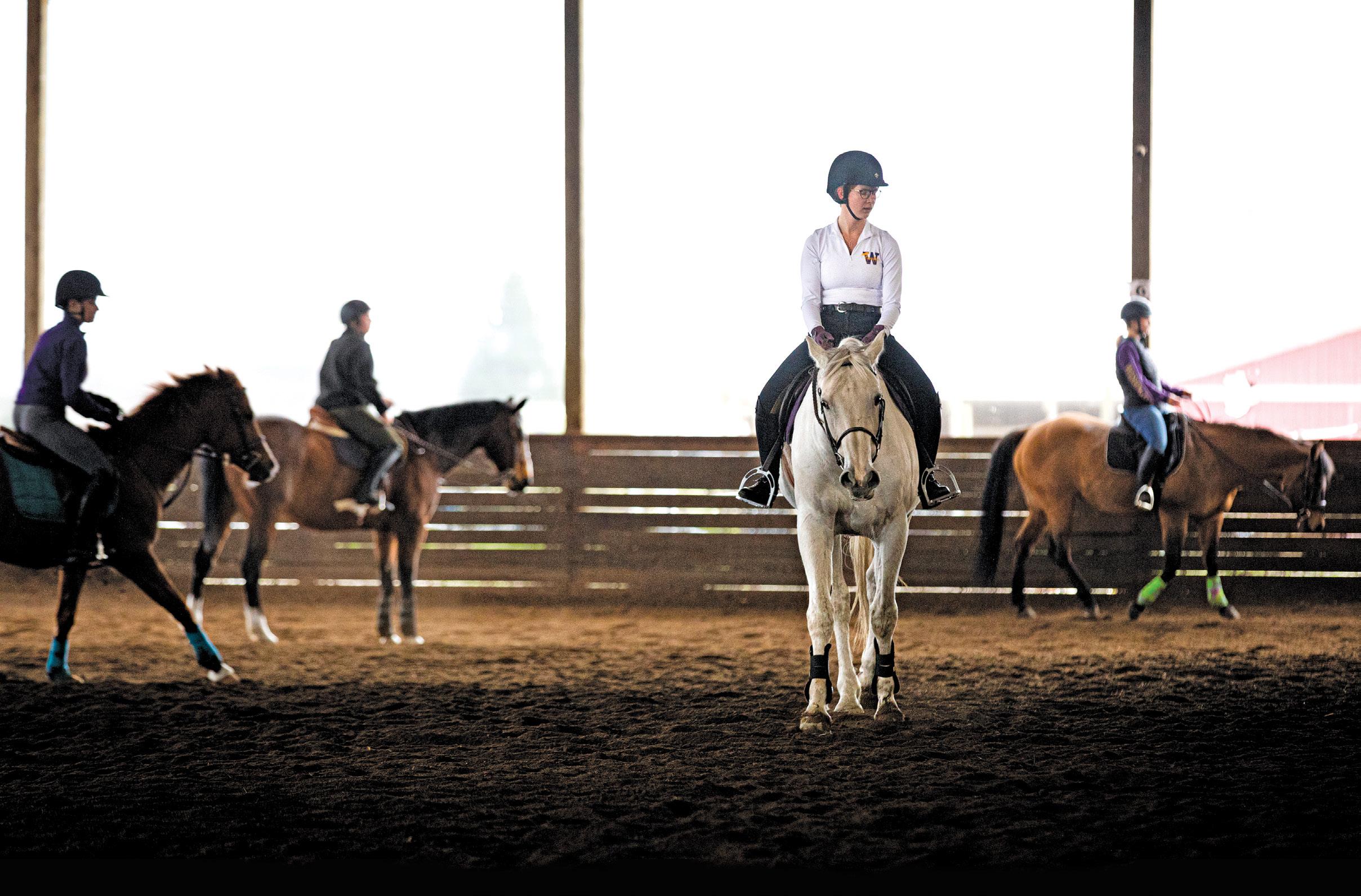
Seriously Horsing Around
Students from the big city saddle up for fun on the UW Equestrian Team
By Caitlin Klask

In 2023, supermodel Bella Hadid returned to competitive horse riding. Meanwhile, the “Barbie” movie reminded us that patriarchy could be way cooler if it involved more horses. Chanel recently featured a horse and rider in haute couture on the runway. So … could it be that the trendiest club on campus is the UW Equestrian Team?
Officially called the IHSA Equestrian Team at the UW, the club sport and registered student organization competes under a program called the Intercollegiate Horse Shows Association. Just because it’s a club sport doesn’t mean these students are horsing around: IHSA can get really competitive. Teams can vie to qualify for regional and national competitions either as individuals or as a team by accruing points at local shows throughout the year. And this year, the UW team is close to qualifying for its regional championship, which will be held at the Red Barn at Stanford University in April.
MARK STONE (2)
DEFINE THE UW 56 UW MAGAZINE
THINGS THAT
Above: Olivia Brandon, ’23, rides with UW team members at Ready to Ride �raining in Stanwood. Right: Fiona Dunbar, ’23, is one of many science majors on the team.
For a school in a major city, the UW has plenty of students with equestrian experience. “We get a lot of interest from Instagram,” says Lauren Bowser, ’24, who joined her sophomore year after finding out about the equestrian team at a tabling event on campus. Originally from Kirkland, Bowser, a physics and astronomy major, is one of many science majors on the 23-person team. During Bowser’s fresh man year, the team was on hiatus from competition due to the pandemic, so members met through Zoom. “We were spending the past couple of years kind of recovering from COVID-19,” says Bowser, explaining that the IHSA also experienced a shakeup in leadership. “So it’s our first year [that is] totally normal.”
“Normal” to this team means driving 50 miles just to get to practice. Practices are held in Stanwood at Ready to Ride Training, about an hour’s drive from cam pus. “There’s lots of stops for snacks involved,” says Bowser. “There’s coffee involved. There’s a group playlist. It’s fun all around.” The rural training facility offers occasional weekday lessons, but the UW’s main practices happen on Saturdays. That’s when riders will have a two-hour lesson that includes adjusting to different horses, since “normal” to an IHSA team also means adapting to whatever horse you’re assigned.
“The first time you’re on your horse is when you’re being judged in the arena,” says Bowser. For IHSA shows, locals pro vide horses, and riders are assigned horses based on height and weight requirements. This method tests a rider’s adaptability on the spot. Once, Bowser was even as signed a mule.
It also means a rider doesn’t have to own a horse—or even regularly ride the same horse—to compete. The IHSA prides itself on being open to all ability levels. “It’s less pitting people against each other than my past experience has been,” says Bowser. The UW Equestrian Team grants awards allowing members to forgo annual membership dues ($125 to $175, depend ing on participation) or receive a free package of lessons. Team members are passionate about horses, their sport and their team, and they’re happy to share the experience with anyone. Well, anyone who knows it exists.
“That’s the joke of the team,” Bowser says. “We have a sticker that says ‘UW has an equestrian team.’” Another idea to raise awareness: “One day we would love to somehow get a horse on campus.” And who would vote “neigh” on that?
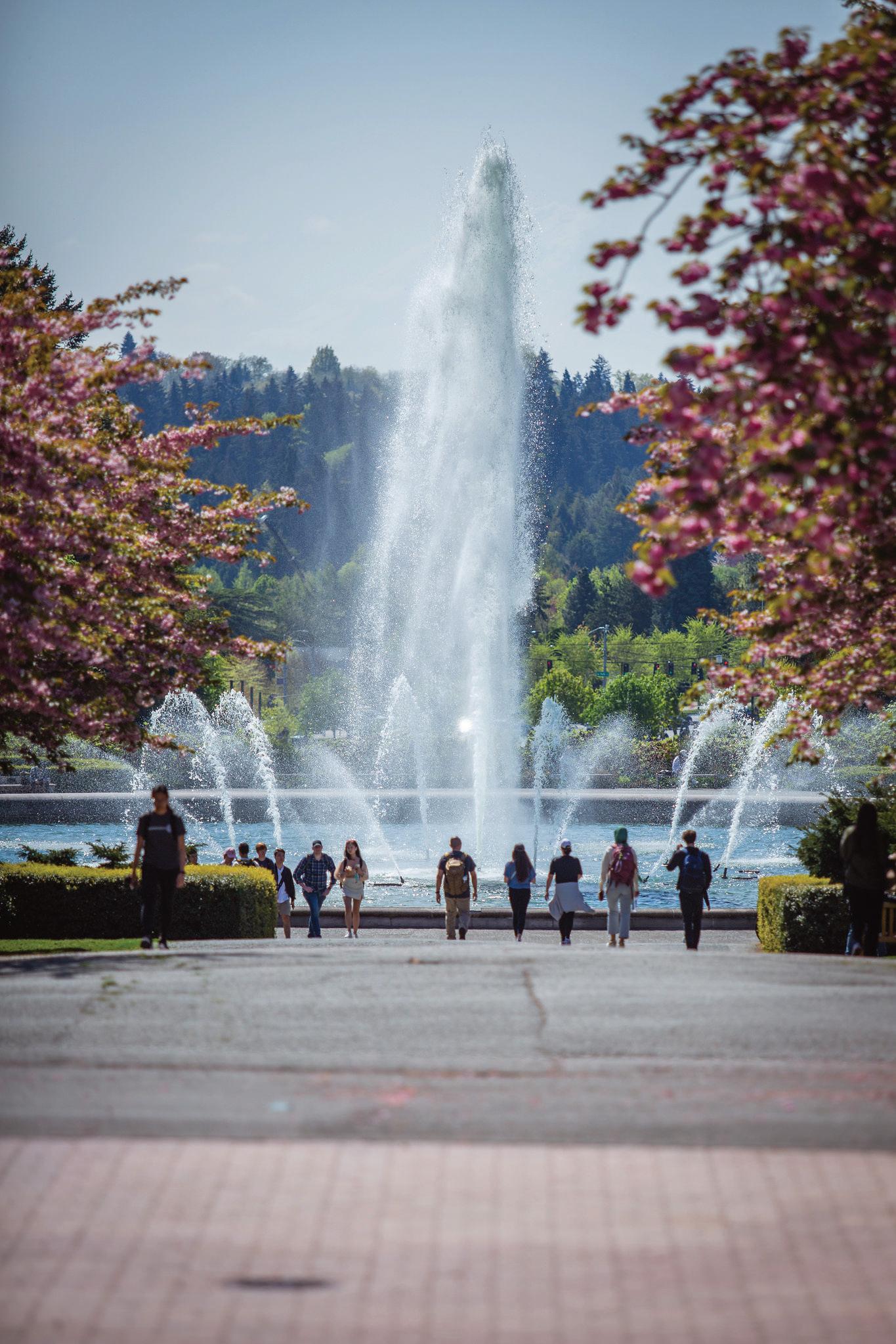



There’s a path for you.
With certificates, degrees, courses and specializations built around your life, there’s nothing stopping you from learning anything, anywhere.
4333 Brooklyn Ave NE Campus Box 359508 Seattle, WA 98195 FIND YOUR PATH AT PCE.UW.EDU














 BY TRACIE D. HALL
BY TRACIE D. HALL



































































 JAMES STEINBERG
JAMES STEINBERG
















 By Jamie Swenson
Photos by Dennis Wise
By Jamie Swenson
Photos by Dennis Wise


































































